9 Volumes
Culture: The Flavors of Philadelphia Life
Philadelphia began as a religious colony, a utopia if you will. But all religions were welcome, so Quakerism mainly persists in its effects on others, both locally and in America, in Art, clubs, and the way of life.
History: Philadelphia and the Quaker Colonies
Philadelphia and the Quaker Colonies
Sociology: Philadelphia and the Quaker Colonies
The early Philadelphia had many faces, its people were varied and interesting; its history turbulent and of lasting importance.
Medicine
New volume 2012-07-04 13:34:26 description
Religion
New volume 2012-07-04 13:22:31 description
Quaker Philadelphia 1683-1776
New volume 2012-11-21 17:33:18 description
Nineteenth Century Philadelphia 1801-1928 (III)
At the beginning of our country Philadelphia was the central city in America.
Surviving Strands of Quakerism
Of the original thirteen, there were three Quaker colonies, all founded by William Penn: New Jersey first, Pennsylvania biggest, and Delaware so small Quakerism was overcome by indigenous Dutch and Swedes.
The Society of Friends
New volume 2019-05-23 17:20:54 description
Quakers: The Society of Friends
According to an old Quaker joke, the Holy Trinity consists of the fatherhood of God, the brotherhood of man, and the neighborhood of Philadelphia.
Quakers, or the Society of Friends, originated as a dissenting religion during the Sixteenth Century. George Fox founded the religion in the region near Manchester, England. Interestingly, the Industrial Revolution began in the same place, at about the same time or only slightly later. Quakerism borrowed some features of German Mennonites, particularly pacifism and simplicity of speech and dress. Quietism, with totally silent meetings as a religious experience, may have been centuries older in monasteries, but it is fair to surmise that it came to the Quakers from the Mennonites. It is still common to hear Mennonites referred to as German Quakers. Fox was an evangelist among the poorly educated classes of society, many of them made newly-aware of their own ideas by translations of the Bible. A handful of well-educated and well-born converts to the religion, led by William Penn, wrote down, softened, and intellectually strengthened the ideas of the quietist movement into a simpler but coherent and sophisticated body of thought. Less is more.
A good example of the simplifying process at work is the name of the religion. Originally, the group were "Friends of the Truth", with dissent thus strongly implied. To become The Society of Friends is a quite another thing, but the evolution was too slow and subtle to provoke resistance.
In fact, it is now difficult to identify anything other than War that Quakers uniformly and strongly oppose. By extension, violence and the incitement to violence, intemperate language or confrontation are deplored, although not cursed as sins. Outsiders unfamiliar with the group sometimes mistake mildness for timidness, and are soon taught a lesson in what is called "steely meekness". The group began with dissent from chivalry, feudalism, and class domination; it resisted the expensive and superficial religious forms of music, ritual, architecture, ceremony, and dress. But as society has itself moved away from such things, Quakers no longer think it is important to advertise their beliefs by adopting "plain" dress and speech or even making a useless fuss about courtroom oaths and pledges. But it is probably true that art, music and everyday dress in Philadelphia is a little less ornate than it might have been without early Quaker disapproval.
In the past century, with the single exception of anti-war conscientious objection, Quaker beliefs have all moved in a positive direction. Steely meekness has shifted from protesting the abuse of Native Indian Tribes, to the posture of assisting the victims of this or any other bigoted oppression. Or natural disaster, of course, but the victims of wars and oppression most readily evoke action and service on their behalf. When such relief is temporarily unpopular, the need for private assistance seems greatest, since government relief is constrained. Prison relief is in this class, both because it leans against the instincts of government, and because Quakers have ample cause to remember the experiences of their own conscientious objectors.
Quakers have continued to evolve since the death of William Penn. Plain speech and plain living quietly continue, but have moved away from the "ostentation of quaintness". Two presidents of the United States have been Quakers, several have won Nobel Prizes, and this group of about twenty-five thousand continues to exert a disproportionate leadership in the nation. Anyone may ask to join the religion, but no one is ever solicited to do so.
In this collection of essays about Philadelphia, we concentrate mostly on the Philadelphia Yearly Meeting. It is important to understand, however, that there are 30,000 Quaker members of over a thousand monthly meetings in Bolivia and Peru; the largest yearly meeting in the world is in Africa, the Kenya Yearly Meeting. In the United States, there are today 33 yearly meetings, of which the Philadelphia one is the largest, with 11,000 members. It contains 103 constituent or "monthly" meetings, scattered from Barnegat, New Jersey to Center County, Pennsylvania, and on a north-south axis from upstate New York to the eastern shore of Maryland. It, therefore, covers the area originally owned by William Penn, the so-called "Quaker Colonies". Some evangelical yearly meetings resemble Protestant denominations, with ministers, hymns, and collection plates. The Philadelphia Yearly Meeting remains "unprogrammed", adhering more strictly to the traditions of silent worship in its weekly meetings for worship, although the monthly meetings for business while orderly are anything but silent. Collections of two to ten monthly meetings will assemble every three months for "Quarterly Meeting", which is usually organized with an agenda. To hold this unstaffed archipelago of adherents together, the Yearly Meeting itself does have a full-time staff with a budget of over $5 million a year and conducts an annual program of business and discussion lasting several days. Among the various projects under its care is the supervision of 55 local private Quaker schools. Adding the informal but strong relationship with three outstanding colleges and a half-dozen retirement villages, the influence of these 11,000 members requires more active individual participation than is seen in most other religions.
Henry Cadbury Dresses Up for the King

|
| Henry Cadbury |
There are a few old Quaker Clothes in the attics of their descendants, and on suitable occasions, an old broad-brimmed hat or two will appear at a Quaker gathering, for amusement. Quakers gave up the old style of "plain dress" when it became generally agreed that such eccentric dress was not plain at all but rather drew attention to itself. On the other hand, there is a distinctly unfashionable quality to almost everything Quakers do wear. When silk and nylon stockings were fashionable for women, Quaker women often wore black stockings. When it became the style for women to sport black stockings, Quaker women usually wore flesh-colored nylons. Among men, thin metal-trimmed spectacles displayed the same counter-fashionable tendency. Nowadays, these little quirks are often public signals among strangers, a way of wig-wagging "I notice you are a Quaker, so am I." And of course, unfashionable clothes are cheaper, and that's always a good thing.
And so it happened in 1947 that the Quakers were awarded the Nobel Peace Prize, with information passed along that white tie and tails were the expected form of dress at the ceremony. Henry Cadbury was selected to receive the award on behalf of the American Friends Service Committee, and you can be sure Henry Cadbury didn't own a set of tails. Henry was also very certain he wasn't going to go out and buy a set, just for a single wearing.
The AFSC collects used clothing, to distribute to the poor. Henry inquired whether there might be a set of white tie and tails to be found in the used-clothing bin, and luckily there was. It had been collected on behalf of the Budapest Symphony Orchestra when that impoverished but distinguished group of musicians was invited to give a concert in London. One of the monkey suits more, or less, fit Henry.
So, after investing in dry cleaning and pressing, Henry packed it up and went off to Oslo, to meet the King.
Slavery: If This be done well, What is done evil?
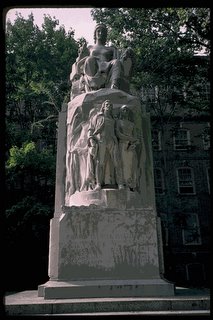
|
| Francis Daniel Pastorius |
The Declaration of the German Friends of Germantown, Against Slavery, in 1688.
These are the reasons why we are against the traffic of men's body, as followeth:
Is there any that would be done or handled in this manner? viz.: to be sold or made a slave for all the time of his life? How fearful and faint-hearted are many at sea, when they see a stranger vessel, being afraid it should be a Turk, and they should be taken, and sold for slaves in Turkey. Now, what is this better done, than Turks do? Yea, rather it is worse for them, which say they are Christians; for we hear that the most part of such negers is brought hither against their will and consent and that many of them are stolen. Now though they are black, we cannot conceive there is more liberty to have them, slaves, as [than] it is to have other white ones. There is a saying , that we shall do to all men like as we will be done [to] ourselves; making no difference of what generation, descent, or color they are. And those who steal or rob men, and those who purchase them, are they not all alike? Here is liberty of conscience, which is right and reasonable; here ought to be likewise liberty of the body, except evil-doers, which is another case. But to bring men hither, or to rob, [steal] and sell them against their will, we stand against. In Europe, there are many oppressed for conscience sake; and here there are those oppressed which are of black color. And we who know others, separating wives from their husbands, and giving them to others: and some sell the children of these poor creatures to other men. Ah! do consider well this thing, you who do it, if you would be done in this manner--and if it is done according to Christianity! You surpass Holland and Germany in this thing. This makes an ill report in all those countries of Europe when they hear of [it,] that the Quakers do here handler men as they handle there the cattle. And for that reason, some have no mind or inclination to come hither. And who shall maintain this your cause, or plead for it? Truly, we cannot do so, except you shall inform us better hereof, viz,: That Christians have liberty to practice these things, Pray, what thing in the world can be done worse, towards us, than if men should rob or steal us away, and sell us for slaves to strange countries; separating husbands from their wives and children. Being now this is not done in the manner we would be done at, [by]; therefore, we contradict [oppose], and are against this traffic of men's body. And we who profess that it is not lawful to steal, must, likewise, avoid purchasing such things as are stolen, but rather help to stop this robbing and stealing, if possible. And such men ought to be delivered out of the hands of the robbers, and set free as in Europe. Then is Pennsylvania to have a good report, instead, it hath now a bad one, for this sake, in other countries. Especially whereas the Europeans are desirous to know in what manner the Quakers do rule in their province; and most of them do look upon us with an envious eye. But if this is done well, what shall we say is done evil?
If once these slaves ( which they say are so wicked and stubborn men,) should join themselves--fight for their freedom, and handle their masters and mistresses, as they did handle them before; will these masters and mistresses take the sword at hand and war against these poor slaves, like, as we are able to believe, some will not refuse to do? Or, have these poor negers not as much right to fight for their freedom, as you have to keep them slaves?
Now consider well this thing, if it is good or bad. And in case you find it to be good to handle these blacks in that manner, we desire and require you hereby lovingly, that may inform us herein, which at this time never was done, viz., that Christians have such a liberty to do so. To this end, we shall be satisfied on this point, and satisfy likewise our good friends and acquaintances in our native country, to whom it is a terror, or fearful thing, that men should be handled so in Pennsylvania.
This is from our meeting at Germantown, held ye 18th of the 2nd month, 1668, to be delivered to the monthly meeting at Richard Worrell's.
Garret Henderich
Derick op de Graeff
Francis Daniel Pastorius
Abram op de Graeff.***
At our Monthly meeting, at Dublin, ye 30th 2d mo., 1688, we have inspected ye matter, above mentioned, and considered of it, we find it so weighty that we think it not expedient for us to meddle with it here, but do rather commit it to ye consideration of ye quarterly meeting; ye tenor of it is related to ye truth.On behalf of ye monthly meeting,
Jo. Hart.
***
This above mentioned was read in our quarterly meeting, at Philadelphia, the 4th of ye 4th mo., '88, and was from thence recommended to the yearly meeting, and the above said Derick, and the other two mentioned therein, to present the same to ye above said meetings, it is a thing of too great a weight for this meeting to determine.Signed by order of ye meeting.
Anthony Morris
International Visitors Council
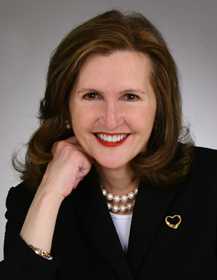
|
| Nancy Gilboy |
The President of IVC, Nancy Gilboy, tells us it stands for International Visitors Council, now approaching its 50th anniversary. As you might suppose, it is located at 1515 Arch Street, near the old visitors center. Philadelphia has a new visitors center on 5th Street, of course, and perhaps it takes time to move or maybe moving isn't in the cards. We had another Visitors center on 3rd Street that came and went, so proximity between Center and Council perhaps isn't as important as rental costs, or leases, or other issues.
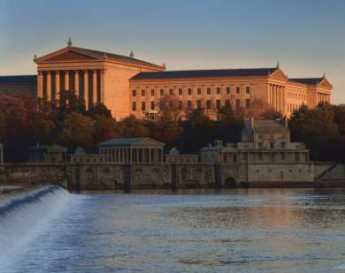
|
| Philadelphia Art Museum |
The Council has a modest budget, but a great idea. Anyone who has traveled much knows that you tend to follow the travel agent's set agenda for a town, you see a lot of churches and museums, but you can almost never get tickets for the local entertainment events, and you almost never meet any local people except taxi drivers and bellhops. That's even more true of young travelers, who don't have either the money or the experience to anticipate the issue, or enough local friends to guide them around the obstacles (This exhibit closed on Mondays, that event is all sold out, this event was spectacular, you should have been there yesterday, sorry we didn't know you were coming we have a wedding to go to, etc.). On guided tours, it is remarkable how few things seem to happen after 4 PM.
So, fifty years ago, some imaginative Philadelphia leaders got the idea that a lot of Philadelphia residents would enjoy taking some foreign tourists under their wing, maybe have somebody to know when they, in turn, make a reciprocal visit, maybe boast about our town a little. Furthermore, by getting involved with the US State Department, young visitors can be identified as potential future leaders in their country. If the guess is a good one, and the experience favorable, Philadelphia might prosper from the publicity and from the later return visits, now in the triumph of success. That was the founding spirit of the Philadelphia International Visitors Council.
So that's how it came about that Margaret Thatcher, < Tony Blair, the current President of Poland, and the head of the Russian Space Program were once visitors in Philadelphia homes. People who like to do this sort of thing tend to like each other, so the monthly receptions (First Wednesday at the Warwick) are interesting Philadelphia social occasions in their own right. Success begets success, and the CCP (originally Business for Russia) has affiliated itself, along with the Philadelphia Sister Cities Program, the Consular Corps Association, The Philadelphia Trade Association, and probably others.
Look at it from the visitors' viewpoint. New York has larger colonies of foreign nationals than Philadelphia does, but New York is an expensive place to visit. Washington has dozens and dozens of embassies, but a visitor soon learns the last thing an embassy staff wants to see, is a citizen from home. So those places aren't really a typically American place to visit. Indiana is plenty American, but there isn't much to see there. So Philadelphia has many attractions, lots of history, it's as thoroughly American as a city can be, and all it needs is someone to open up and show it to you. Cleverly organized, the IVC has undoubtedly put the Philadelphia stamp on many foreign visitors, without their exactly recognizing they are being told This is America. If the State Department is shrewd in its assessment process, Philadelphia will in time be held in high esteem by the leaders of a lot of foreign nations.
In the spirit of announcing that Philadelphia is where you can find America, my own little daughter astonished me at a dinner party by telling the assembly the following story:" William Penn was nice to the Indians, so it was safe to land in Philadelphia. Pretty soon, so many people landed here they had to move West to settle down. And, folks, that's why the people to the North of us talk funny, and the people to the South of us talk funny -- but everybody else in America talks like Philadelphia!"
John Woolman Reports on Yearly Meeting, 1758
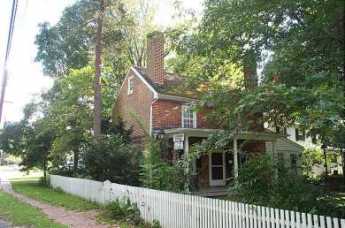
|
| John Woolman House |
"In this yearly-meeting (1758) several weighty matters were considered; and, toward the last, that in relation to dealing with persons who purchase slaves. . . .
"Many faithful brethren labored with great firmness, and the love of truth, in a good degree, prevailed. Several Friends who had Negro's expressed their desire that a rule might be made to deal with such Friends as offenders who bought slaves in future. To this, it was answered, that the root of this evil would never be effectually struck at until a thorough search was made into the circumstances of such Friends who kept Negro's, with respect to the righteousness of their motives in keeping them, that impartial justice might be administered throughout. Several Friends expressed their desire that a visit might be made to such Friends who kept slaves, and many Friends said that they believed liberty was the Negro's' right; to which, at length, no opposition was made publicly. A minute was made, more full on that subject than any heretofore, and the names of several Friends entered, who were free to join in a visit to such who kept slaves. "
Jury Nullification
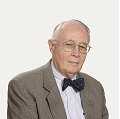 |
| Tom Monteverde |
We must be grateful to the late distinguished litigator, Tom Monteverde, for reminding us of the importance of the jury in American history. Juries seldom realize how much power they can have if they unite on a common purpose. In fact, juries have the implicit right to veto almost anything the rest of government does, by rendering it unenforceable. If the jury opinion is a majority view, nothing but a civil war can legally stop them. So it helped Washington to have jury nullification seem an invincible Quaker idea, while the South trusted a rich slave-owner who had renounced power.
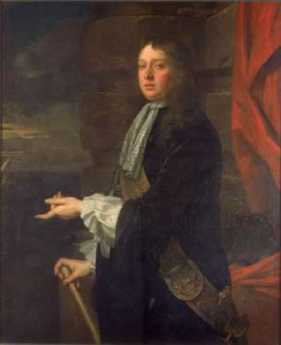 |
| William Penn |
The right to a jury trial originated in the Magna Carta in 1215, but a jury's essentially unlimited power was established four centuries later by Quakers. The legal revolution grew out of the 1670 Hay-market case, where the defendant was William Penn, himself. Penn was accused of the awesome crime of preaching Quakerism to an unlawful assembly, and while he freely admitted his guilt he challenged the righteousness of such a law. The jury refused to convict him. The judge thus faced a defendant who said he was guilty and a jury who said he wasn't. So, the exasperated judge responded -- by putting the jury in jail without food.
The juror Edward Bushell appealed to the Court of Common Pleas, where the problem took on a new dimension. The Justices certainly didn't want juries flouting the law, but nevertheless couldn't condone a jury being punished for its verdict. Chief Justice Vaughn decided that intimidating a jury was worse than extending its powers, so the verdict of Not Guilty was upheld, and Penn was set free. Essentially, Vaughn agreed that any jury that wasn't allowed to acquit was not really a jury. In this way, the legal principle of Jury Nullification of a Law was created. A verdict of not guilty couldn't make William Penn innocent, because he pleaded guilty. A verdict of not guilty, under these circumstances, meant the law had been rejected. Jury nullification thus got to be part of English Common Law, hence ultimately part of the American judicial system.
 |
| Andrew Hamilton |
This piece of common law was a pointed restatement of just who was entitled to make laws in a nation, whether or not nominally it was ruled by a king or a congress. Repeated British evasion of the principles of jury trial became an important reason the American colonists eventually went to war for independence, and probably a better one than some others. The 1735 trial of Peter Zenger was an instance where Andrew Hamilton, the original "Philadelphia Lawyer", convinced a jury that British law, blocking newspapers from criticizing public officials for improper conduct, was too outrageous to deserve enforcement in their court. In that case, jury defiance became even more likely when the judge instructed the annoyed jury that "the truth is no defense". Benjamin Franklin's Pennsylvania Gazette was here quick to come to the side of jury nullification, saying, "If it is not the law, it ought to be law, and will always be law wherever justice prevails." Franklin quickly became allied with Andrew Hamilton, who became Speaker of the Pennsylvania Assembly.
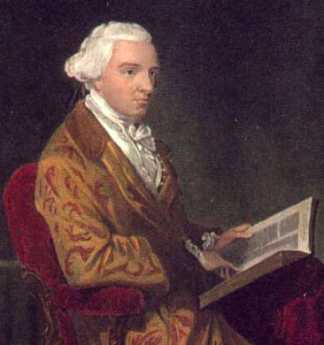 |
| John Hancock |
The Zenger case was often stated to be the origin of the Freedom of the Press in our Constitution fifty years later, but in fact the First Amendment merely provides that Congress shall pass no laws like that. Hamilton had persuaded the Zenger jury they already had the power to stop enforcement of such tyranny, and the First Amendment could be seen as trying to prevent enactment of laws that will foreseeably incite a jury to revolt.
The Navigation Acts of the British government, for example, were predictably offensive to the American colonists, whose randomly chosen representatives on juries were then rendered useless with their wide-spread refusal to convict. This, in turn, provoked the British ministry. John Adams made a particularly famous defense of John Hancock who was being punished with confiscation of his ship and a fine of triple the cargo's value. Adams was later singled out as the only named American rebel the British refused to exempt from hanging if they caught him. As everyone knows, Hancock was the first to step up and sign the Declaration of Independence, because by 1776 there was widespread colonial outrage over the British strategy of transferring cases to the (non-jury) Admiralty Court. Many colonists who privately regarded Hancock as a smuggler were roused to rebellion by the British government thus denying a defendant his right to a jury trial, especially by a jury almost certain not to convict him. To taxation without representation was added the obscenity of enforcement without due process. John Jay, the first Chief Justice of the Supreme Court of the newly created United States, ruled in 1794 that "The Jury has the right to determine the law as well as the facts." And Thomas Jefferson built a whole political party on the right of common people to overturn their government, somewhat softening, it is true, when he grasped where the French Revolution was heading. Jury Nullification then lay fairly dormant for fifty years. But since the founding of the Republic and the reputation of many of the most prominent founders was based on it, there was scarcely need for any emphasis.
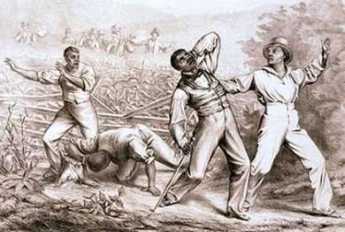 |
| Slave |
And then, the Fugitive Slave Law of 1850 began to sink in. It became evident that juries in the Northern states would routinely refuse to convict anyone under that law, or under the Dred Scott decision, or any other similar mandate of any branch of government. In effect, Northern juries threw down the gauntlet that if you wanted to preserve the right of trial by jury, you had better stop prosecuting those who flouted the Fugitive Slave law. In even broader terms, if you want to preserve a national government, you had better be cautious about strong-arming any impassioned local consensus. A rough translation of that in detail was that no filibuster, no log-rolling, no compromises, no oratory, no threats or other maneuvers in Congress were going to compel Northern juries to enforce slavery within their boundaries of control. All statutes lose some of their majesties when the congressional voting process is intensely examined, and public scrutiny of this law's passage had been particularly searching. Even if Southern congressmen would be successful in passing such laws, it wasn't going to have any effect around here. The leaders of Southern states quickly got a related message, and their own translation of it was, "We have got to declare our independence from this system of government that won't enforce its own laws". If juries can nullify, then states can nullify, and the national union was coming to an end. Both sides disagreed so strongly on this one issue they were willing, for the second time, to risk war for it.
Ku Klux Klan
The idea should be resisted that Jury Nullification is always a good thing. After the Civil War, many of the activities of the Ku Klux Klan were tolerated by sympathetic juries. Many lynch mobs of the Wild, Wild West were encouraged in the name of law and order. Prohibition of alcohol by the Volstead Act was imposed on one part of society by another, and Jury Nullification effectively endorsed rum-running, racketeering, and organized crime. The use of marijuana and abortion are two further examples where disagreement is so strong that compromise eludes us. What is at stake here is protecting the rights of a minority, within a society run by a majority. If minority belief is strong enough, jury nullification issues an unmistakable proclamation: "To proceed farther, means War."
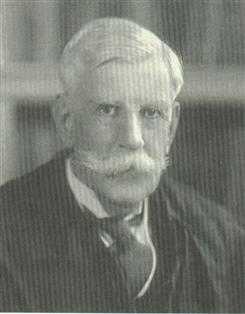 |
| Oliver Wendell Holmes |
That's a somewhat strange outcome for a process started by pacifist Quakers, so the search goes on for a better idea. Distinguished jurists differ on whether to leave things as they are. In a famous exchange, Oliver Wendell Holmes once had dinner with Judge Learned Hand, who on parting extended a lawyer jocularity, "Do justice, Sir, do justice." To which, Holmes then made the somewhat surly response, "That is not my job. My job is to apply the law."
Thus lacking any better approach, it is hard to blame the US Supreme Court for deciding this was something best left unmentioned any more than absolutely necessary. The signal which Justice Harlan gave in the majority opinion on the 1895 Sparf case was the very narrow ruling that a case may not be appealed, solely on the basis that the trial jury was not informed of its right to nullify the law in question. Encouraged by this vague hint, what has evolved has been a growing requirement that incoming jurors take an oath "to uphold the law", officers of the court (ie lawyers)are discouraged from informing a jury of its true power to nullify laws, and Judges are required to inform the jury in their charge that they are to "take the law as the judge lays it down" (ie leave appeals to higher courts). If a jury feels so strongly that it then persists in spite of those restraints, well, you apparently can't stop them. Nobody thinks this is a perfect solution, and aggrieved defendants like the Vietnam War protesters are quite vocal in their belief that the U.S. Supreme Court finally emerged with a visibly asinine principle: a jury does indeed have the right to nullify, but only as long as that jury is unaware it has that right. That's almost an open invitation to perjury if accurate; but while it's not precisely accurate, it comes close to being substantially true.
That's where matters stand, and apparently will stand, until someone finds better arguments than those of Benjamin Franklin, John Jay, Andrew Hamilton -- and William Penn.
North of Market
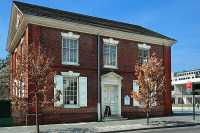
|
| Free Quaker Meeting House |
In their 1956 book "Philadelphia Scapple", Harold Donaldson Eberlein and Mrs. Henry Cadwalader give an interesting description of the evolution of the term "North of Market". In the early days of the city, almost all of the town was South of Market Street. In fact, an early 18th Century visitor once wrote that he always brought a fowling piece when he visited Philadelphia because the duck hunting was so good at the pond located at what is now 5th and Market.
When the Quaker meeting house was built at 4th and Arch Streets, many of the more important Quaker families thought it was important to build their houses nearby. In that way, Arch Street developed the reputation of being a Quaker Street. So the original meaning of the North of Market term was the Quaker ghetto. Quaker families continued to spread West along Arch Street or nearby, and this accounts for the location of the Friends Center at 15th and Cherry and related local activities. When the Free Quaker were evicted from the meeting at 4th and Arch because of their activities during the Revolution, they built their own meeting at -- 5th and Arch.
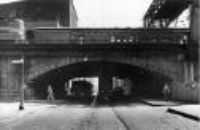
|
| Chinese wall |
During the Civil War, a number of people made fortunes that socially upscale people over in the Rittenhouse Square area considered disreputable, so elaborate but ostracized mansions marched due North up Broad Street, where they can still be observed as stranded whales in the slums, leaders without followers. The show houses of manufacturers of shoddy war goods soon gave the meaning of parvenu to the term North of Market.
And then, the Pennsylvania Railroad ran an elevated brick structure from 30th Street to City Hall Plaza, the so-called Chinese Wall. For nearly a century this ugly looming structure on Pennsylvania Boulevard, now John Kennedy Boulevard, with its smoky engines above, and dark dripping tunnels at street level, sliced the town in half and made it very unattractive to build or to live, North of Market. The Spring Garden area had some pretty large and expensive houses, but it was cut off by the railroad trestle and has only recently started to revive. It helped a lot to tear down the Chinese Wall, but that was fifty years ago, and the area has taken a long time to recover from the earlier diversion of social flow to the South of it. And, psychologically, North of Market will take even longer to recover from the implication of -- industrial slum.
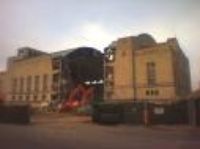
|
| center |
Meanwhile, of course, Oriental immigration settled along Arch Street at 9th to 12th Streets, and we now have our Chinatown there, complete with street signs in oriental lettering. In effect, we have a real Chinese Wall, a social one. Just what will happen to this group is unclear, since it is readily observable that they like to cluster together, unlike the East Indian immigrants, who head for the suburbs as fast as they can. Since the Chinese colony is physically blocked on all sides by the Vine Street Expressway, the Convention Center, and the Ben Franklin Bridge, it is hard to know where they will flow if the group gets much larger. The depressed Vine Street crosstown expressway makes a definitive border for downtown, and the contrast between the two sides of this expressway is striking. On one side is Camelot, and on the other side, almost nothing is being built. The future of North of Market, at the moment, is a little unclear.
Pennyslvania's Boundary: David Rittenhouse, Hero, Lord Baltimore, Villain
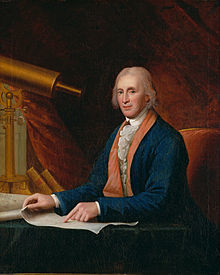
|
| David Rittenhouse |
In the Twenty-first Century, when we know how every American creek and river run, we can see it might have been simple to establish a boundary between the new royal grant to William Penn, and an earlier grant to Lord Baltimore by the then-reigning king's father, Charles I. Essentially: Penn got the Delaware Bay and a lot of wilderness to the west of it. George Calvert, Lord Baltimore, had long held the top half of the Chesapeake Bay and a strip of wilderness to the west of that. Two bays, with two hazy strips of wilderness attached.
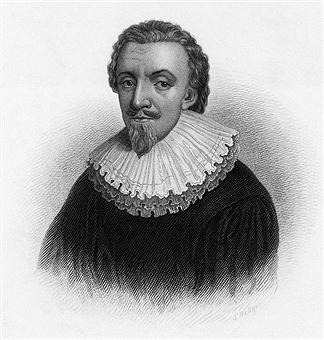
|
| George Calvert, Lord Baltimore |
At what is now Odessa, Delaware, those two bays are only five miles apart; compromise should have settled the issue quickly. Two English gentlemen could have sat down over a pipe and a brew, working something out. However, the English nation was then changing kings, beheading them over matters of religion. A Roman Catholic, Lord Baltimore probably thought an opportunity might emerge from the turmoil if he stalled until matters went his way, since next in line of succession was James, Duke of York, who was a Catholic. But matters fall into the hands of the lawyers when principals of an argument are unable to speak. As we noted elsewhere, in the legal system of the day the last word from the last king was what counted in law courts, accepting any uncertainty about future latest words from future latest kings in order to maintain immediate peace. To lawyers of the time, all this talk about justice, fairness, and geometry was idleness when the nation needed order and stability. So the Calvert family lawyers over the course of eighty years, introduced one specious proposition after another that turned other lawyers purple with rage. Penn's lawyer, Benjamin Chew, beat them at this game, and his mansions in Delaware and Germantown attest to the value attached to this achievement. In other circumstances, posturing might have led to war, as it did in similar disputes with Connecticut. Penn probably knew better, but it takes two to compromise.
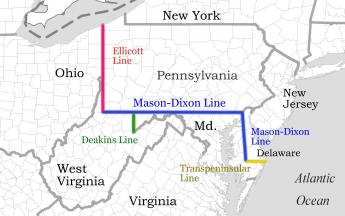
|
| Mason-Dixon Line |
It must be admitted that honest confusion was possible. Sometimes, a line of latitude was a line in the sense Euclid intended: all length and no width. At other times, lawyers and kings were talking about "parallels" as if they were strips, roughly sixty miles wide. If a sixty-mile strip was intended, it was important for a grant to specify whether it extended to the southern edge of the strip, or to the northern edge. But in fact, the state of science in the Seventeenth Century contained uncertainty about both where the strips were, and how wide. And if the grant's language didn't even make it clear whether the parties were talking about strips or width-less lines, eighty years could be a comparatively short time for a court to decide the case. To be fair to Lord Baltimore, many people at the time didn't think these matters were capable of fair solution, so the traditional way of dealing with land disputes was either by force or by craftiness.
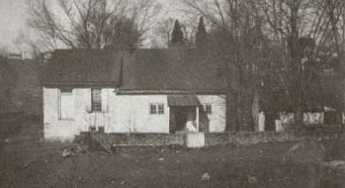
|
| David Rittenhouse Birth Place |
In William Penn the folks from Maryland were, unfortunately, dealing with a friend of the King, who had one of the most brilliant mathematicians in Western civilization as his adviser. David Rittenhouse may have been born in that little farmhouse you can still visit on the Wissahickon Creek, and made his living as a clockmaker, but his native talents in mathematics, astronomy surveying, and instrument construction were so deep and so varied that later biographers are reduced to describing him merely as a "scientist" and letting it go at that. If you want to sample his talents, spend an hour or two learning what a vernier is, and then see if you could apply that insight, as he did, to a compass. So, as it turned out, Rittenhouse was able to describe a twelve-mile circle around New Castle, Delaware, construct a tangent that divides the Delmarva's Peninsula in half, and match it up with an east-west line we now call the Mason Dixon Line. When they finally got around to laying these lines on the ground, Mason and Dixon cut a twenty-four-foot swath through the forest, using astronomical adjustments every night, and laying carved marker stones every fifth of a mile for hundreds of miles. The variation from the line devised by Rittenhouse was at most a fifth of a mile off the mark; the intersection with the north-south line between Maryland and Delaware was less successful. The survey by Mason and Dixon was not quite completed to the Ohio line because the Indians, curious at first, eventually became wild with suspicion at such behavior, particularly the part about going out and aiming cannons at the sky every night. It seems likely that George Calvert, Lord Baltimore, had no more confidence in this madness than the Indians did.
So, the next time you take the train from Philadelphia to Washington DC, reflect that strict reading of the words in the land grants did admit the possibility that your whole trip could either have been within the State of Maryland, or else in the Commonwealth of Pennsylvania, depending on whether lawyers, or scientists, had triumphed in this dispute. Since the Mason Dixon Line later divided not merely two states, but two violently opposed cultures, Rittenhouse must stand out in the history of one of those people who were so smart that most people couldn't understand how smart he was.
Edward Hicks: Peaceable Kingdoms

|
| Peaceable Kingdoms |
Edward Hicks (1780-1849), the most important folk artist of American art, was born and lived all his life in Bucks County, Pennsylvania. About a hundred of his paintings survive, 62 of which are versions of "The Peaceable Kingdom". Recently, his Peaceable Kingdoms have been selling for more than $4 million apiece, and the other works at more than a million. As is so often the case, he was born in poverty and spent his life in poverty, so the financial benefits have all gone to middle-men.
Hicks had to overcome an additional handicap. Quakers disapproved of painting things up just for show, and they strongly disapproved of the vanity underlying the act of having a portrait painted of yourself. In fact, the early Quakers would not even permit their names to be placed on their tombstones.
Hicks was apprenticed into the wagon business and showed a talent for painting them. From that, entirely self-taught, he migrated into the business of painting business signs in an age of limited literacy. The Blue Anchor Tavern, the King of Prussia Inn, the Crossed Keys Tavern and the signs of various tradesmen were an essential part of conducting business. It is easy to see these tradesmen signs in the easel paintings of Hicks' later career, which reduce themselves to rearrangements of such individual sign paintings to make a coherent canvas.
If you have seen one "Peaceable Kingdom" you haven't seen them all, but you only need to see one to be able to recognize the others at sight. They generally form a group of wild animals and an occasional child in the right foreground, with a grouping of Quakers and Indians in the left background, taken from Benjamin West's famous portrayal of Penn signing the treaty of peace with the Delaware Indians. The scene is taken from Chapter 11 of Isaiah, in which the lion lies down with the lamb.
Hicks was not a successful farmer, and he had to overcome Quaker resistance even to sell religious paintings with a Quaker moral. No doubt the resistance was strengthened by the fact that his cousin Elias Hicks had split the Quaker church into two (Conservatives and Hicksites) in 1827, and Edward was himself a strong itinerant preacher. Although the plain message of the Peaceable Kingdom is reconciliation between the two branches of Quakerism, he probably encountered a fair amount of coolness among the Conservative opposition.
Hicks was neither an educated nor a sophisticated man. It is forgivable that he made such a strong Old Testament statement when he and his cousin represented a dissenting sect that was gravely doubtful about the wisdom of allowing your life to be ruled by biblical verses.
Quaker Investment Committee
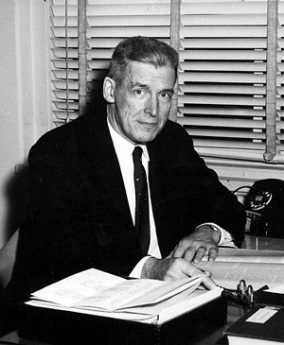
|
| Jonathan Rhoads |
Charitable institutions and other non-profit organizations occasionally assemble an endowment and thus develop a need for an oversight committee to hire (and occasionally fire) an investment manager, to monitor the fund's management, and to assess the manager's fees. The meetings of the oversight committee could, therefore, be pretty brief, related to two numbers. How had the endowment portfolio performed, compared with some acknowledged benchmark? To these two numbers might be added a brief summary of the investment management fees, compared with the usual benchmarks (40 basis points, or .4%, would be a common standard). However, an agenda so mercilessly sparse seems an inadequate reason to convene a group of worthies for an hour, and quite commonly the committee will chat about investments in general, hoping to pick up some personal pointers. A good tip or two makes the whole effort seem worthwhile.
On one such occasion in 1987, the famous Quaker surgeon Jonathan Rhoads, Sr was chairman of the committee. The manager of the endowment was a handsome fellow whose picture had occupied a full page of the New York Times financial pages just a day or two before this particular meeting. The picture had been truly spectacular, the tailoring was remarkable, and he surely had perfect teeth. As this gentleman entered the room, the committee gathered around, slapping his back and congratulating him on his fame with great jollity. Little did the group know that within thirty days, the stock market would have its most severe drop in almost twenty years. Unnoticed at first by the merry-makers, Jonathan Rhoads had sat down at the head of a perfectly empty long mahogany table, and was intoning to the empty seats, "We will now begin by reading the minutes of the last meeting of this committee". Visibly shaken, the group immediately broke up and took their seats.
Rhoads went on. We were now to hear the report of our portfolio by our manager. Proudly, it was noted that in February we had bought XYZ for 20, and in July we had sold it for 44. And in March we had bought ABCs for 60, and it now stands at 100. When he had concluded, the chairman said, "That's fine. That's just fine. But what bothers me is that point of confusion." Why, what confusion, Dr. Rhoads?
"The confusion between investment genius, and just being in a bull market." Later the same month, the stock market suddenly dropped 22% in one day, thus guaranteeing that no one in the room would ever forget the episode.
Quakers From the Indian Point of View
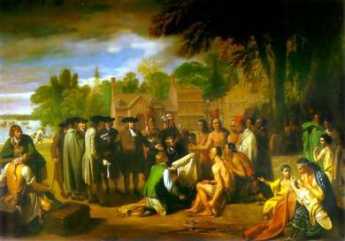
|
| William Penna and Indians |
The following property of the Nicholson family has been presented to the Haddonfield Friends Meeting in replica form. Although signed by John Haines, it is not readily apparent why this member of a very old New Jersey Quaker family was being addressed, just what it means that he signed it, or possibly whether John Haines was a name adopted by Corn Planter. Very likely, however, Haines was acting as public scribe, a common profession in all illiterate societies. As a matter of fact, there have been so many Joseph Nicholsons that it takes some tracing to identify just which one he was, too.
------------- To the Children of the friends of Onas, who first settled in Pennsylvania:
The request of the Corn Planter a Chief of the Seneca Nation --
Brothers, The Seneca Nation see, that the greater Spirit intends that they shall not continue to live by hunting, and they look round on every side and inquire who it is that shall teach them what is best for them to do. Your fathers have dealt fairly and honestly with our fathers, and they have charged us to remember it and we think it right to tell you, that we wish our Children to be taught the same principles by which your Fathers were guided in their Councils.
NicholsonsBrothers, We have too Little wisdom among us, we cannot teach our Children what we perceive their situation requires them to know, and we, therefore, ask you to instruct some of them -- we wish them to be instructed to read and to write and such other things as you teach your own Children, and especially to teach them to love peace.
Brothers, We desire of you to take under your care two Seneca boys and teach them as your own, and in order that they may be satisfied to remain with you and be easy in their minds that you will take with them the son of our interpreter and teach him also according to his desire.
Brothers, You know that it is not in our power to pay you for the education of these three boys, and therefore you must, if you do this thing look up to God for your reward.
Brothers, You will consider this request, and let us know what you determine to do -- If your Hearts are inclined toward us, and you will afford our Nation this great advantage, I will send my son as one of the boys to receive your instruction and at the time which you shall appoint.
Signed February 10. 1791 -- in the presence of Joseph Nicholson
his Corn X Planter Mark
John Haines
Rufus Jones, Quaker
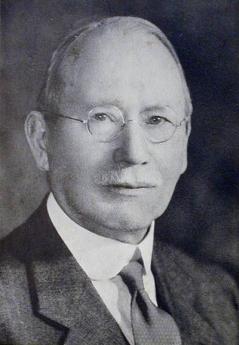
|
| Rufus Jones |
Rufus Jones (1863-1948) dominated the Quaker religion for two generations, causing a transformation which deserves to rank with that of George Fox, William Penn and Elias Hicks. A few elderly Quakers still remember him in person, mostly as an old gentleman who tended to lean back while he spoke, usually hooking his thumbs in the sides of his vest. He was a prodigious writer, having once made a promise to himself that he would read a new book every week, and write a new book, every year. He kept that up for thirty years.
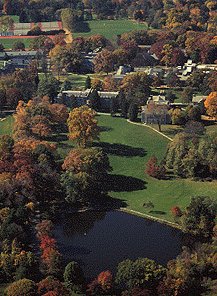
|
| Haverford College |
As a matter of fact, that understates his output. His published works were collected by Clarence Tobias at Haverford College, and run to 168 volumes, plus 8 boxes of pamphlets and articles. His family also donated his personal papers to the College, and they require 75 linear feet of shelf space.
His stated occupation would have been Professor at Haverford College, where his personal influence on the undergraduates was as profound as their influence was to be on the rest of the world. He is regarded as one of the founders of the American Friends Service Committee and the single greatest influence in reuniting the two divisions of Quakerism, although some of the formalities were not completed until after his death.
One other index of his remarkable energy was that he crossed the oceans more than two hundred times during his lifetime.
Perhaps the arrival of mass communication has made it possible to have equal impact with less effort. But Rufus Jones stands for the principle in life, that it never hurts to work just a little harder. If high school students are thinking of applying for admission to Haverford, they better understand what is going to be expected of them.
Silence Connotes Assent: Only To Quakers
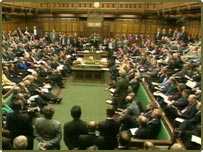
|
| British Parliament |
In 1604, the British Parliament considered the issue of what it should mean if Parliament remained silent on a topic. The English Civil War, King Versus Parliament, was soon to begin, so it was almost inevitable that Parliament would decide that in no sense, no way, was consent to be assumed from its silence. This common law principle endures to the present, and has been explicitly reaffirmed by the U.S. Supreme Court in the past few months. On an even simpler level, what is it to mean if the presiding officer called for the ayes, failed to solicit discussion or nays, and declared the matter settled? That's a fairly common error of inexperienced presiding officers -- and it's a common trick of manipulative partisan presiding officers, too.
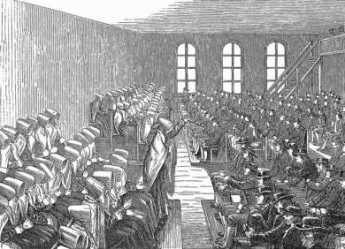
|
| Quaker Meeting for Business |
Parliament soon made the 1604 declaration that if the presiding officer failed to call for the nays, the motion was not carried, no matter how many ayes there appeared to be.
In Quaker Meeting for Business, however, the reverse is true. A proposal is made and discussed until discussion ceases. At that point, some weighty member will announce, "I approve", and usually there will be a chorus of other approves. If there is further silence at that point, the matter is carried and entered into the minutes, which are read aloud for comment and correction, before the meeting adjourns. It's really remarkable how much business can be accomplished in an hour, using that procedure.
The essential difference is that the Quakers are striving for unanimity, while courts and parliaments are striving for a decision. If the issue is whether or not to tax activity or to hang a criminal, it is probably futile to hope for unanimous consent. The stated need here is to come to some judgment, any judgment, in a timely fashion. The Quaker goal is to reach consensus, which may take some members longer than others, but the assumption is that everyone will eventually get to the same point. One group counts votes, with the chairman casting the deciding vote in the event of a tie, while the other group holds a matter over to another meeting until a significant consensus emerges.
The irony of this situation is that a group which sincerely strives for unanimity will actually dispose of its business more quickly than a group which forces the pace to meet some artificial deadline. The Quaker system does break down when the urgency for a decision is greater than the pace of reaching unanimity. The Parliamentary system breaks down when the number of votes (whether a majority or a super-majority) required for a decision, is in fact less than that intangible level of agreement which keeps the organization from disintegrating.
Slaveowning Quaker Steps Up To The Plate
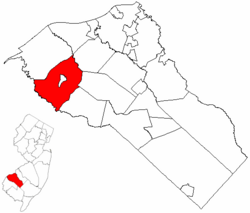
|
| County of Gloucester |
I, Joseph Nicholson of the Township of Woolwich and County of Gloucester, do hereby set free from bondage my Negro Tenor, aged about twenty-two years, and do, for myself, my Executors and Administrators, release unto the said Tenor, all my Right, and all claim whatsoever as to her person or to any Estate that may acquire, hereby declaring the said Tenor, absolutely free, without any interruption from me, or any person claiming under me.
In Witness whereof I have hereunto set my Hand and Seal this twenty-seventh day of the Twelfth Month, in the Year of our Lord One Thousand Seven Hundred and Seventy-nine. 1779.
. . . Joseph Nicholson (Seal)
. . Sealed and Delivered in the presence of Joseph Allen
The Definition of a Real Philadelphian (1914)
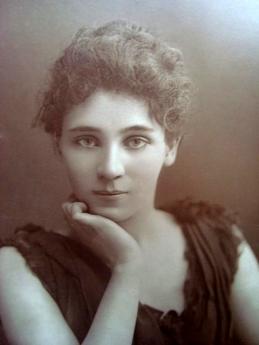
|
| Elizabeth Robbins Pennell |
There are several million people living in Philadelphia, but of course, not all of them are real Philadelphians. >Elizabeth Robbins Pennell, a friend and biographer of James McNeill Whistler, tells us the definition of a real Philadelphian in 1914.
"I think I have a right to call myself a Philadelphian, though I am not sure if Philadelphia is of the same opinion. I was born in Philadelphia, as my father was before me, but my ancestors, having had the sense to emigrate to America in time to make me as American as an American can be, were then so inconsiderate as to waste a couple of centuries in Virginia and Maryland, and my Grandfather was the first of the family to settle in a town where it is important, if you belong at all, to have belonged from the beginning. However, [my husband's] ancestors, with greater wisdom, became at the earliest available moment not only Philadelphians, but Philadelphia Friends, and how much more that means Philadelphians know without my telling them. And so, as he does belong from the beginning, and as I would have belonged had I had my choice, for I would rather be a Philadelphian than any other sort of American, I do not see why I cannot call myself one despite the blunder of my forefathers in so long calling themselves something else."
--Our Philadelphia, 1914
The Naming of Pennsylvania
On January 5, 1681, William Penn wrote a letter to his friend Robert Turner:
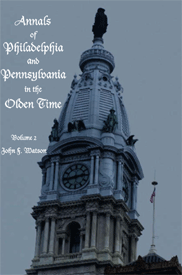
|
| Annals of Pennsylvania |
"This day my country was confirmed to me by the name of Pennsylvania, a name the King would give it, in honor of my father. I chose New Wales, being, as this, a pretty hilly country; but Penn, being Welsh for a head -- as Pennanmoire in Wales, and Penrith in Cumberland, and Penn in Buckinghamshire, the highest land in England, -- they called this Pennsylvania, which is the high or head woodlands, for I proposed (when the Secretary, a Welshman, refused to have it called New Wales), Sylvania, and they added Penn to it; and though I much opposed it and went to the King to have it struck out and altered, he said, 'twas past, and would take it upon him; nor would twenty Guineas move the under Secretaries to vary the name, -- for I feared lest it should be looked on as a vanity in me, and not as a respect in the king, as it truly was, to my father, whom he often mentions with praise."
John F. Watson, the author of what generations have called "Watson's Annuals," goes on to comment:
"If the cause was thus peculiar in its origin, it is not less remarkable in its effect, it being at this day perhaps the only government in existence which possesses the name of its founder."
Watson further makes the footnote: "Penn himself professed to have descended of the house of Tudor, in Wales, one of whom, dwelling on an eminence in Wales, received the name of John Pennunnith. He going afterward to reside in London, took the name of John Penn, i.e. John on the Hill."
The Schools of School House Lane

|
| Union School founded in 1759 |
The region of Philadelphia defined as Germantown is recorded by the last census as having about 50,000 inhabitants today, 40,000 of whom are of the black race. Germantown has always had an unusual concentration of schools of the highest quality, and here on one street alone there are four. School House Lane runs off to the West of Germantown Avenue, and was originally right at the center of town, the center of the action during the Revolutionary War. The most historic of the schools, the Union School founded in 1759, changed its name to Germantown Academy, and more recently picked up and moved to new quarters in Fort Washington. George Washington sent his nephew there, and its building served as a hospital for the wounded in the Battle of Germantown. When Germantown Academy moved out of Germantown, the Pennsylvania School for the Deaf moved into the vacated quarters. This school had been originally founded in 1820, and is one of nearly a hundred special schools for the deaf in the United States, operating as a quasi-public institution for about 170 students. A remarkable thing about all schools for the deaf is the high IQ of their students. Perhaps deaf underachievers are somehow filtered out by the struggle to adapt before they apply for admission, or perhaps there is something about being deaf that makes you smart. In any event, the average SAT scores of students from PSD, like all schools for the deaf, are always in the very highest ranks among secondary schools.
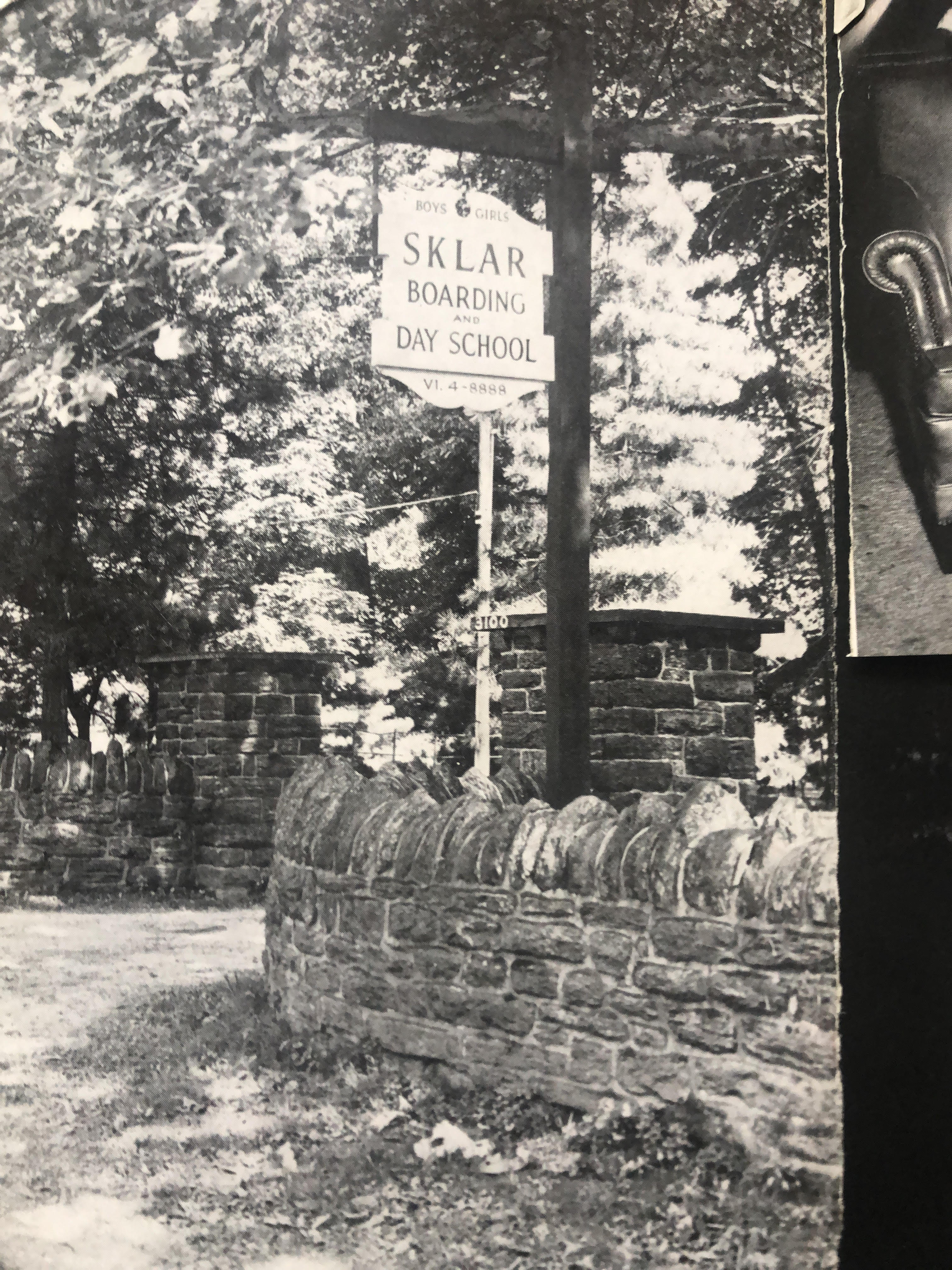
|
| Sklar School Entrance |
More or less next door to it, fronting on Coulter Street, is the Germantown Friends School(GFS), which enjoys and deserves the reputation of the most intellectually rigorous school in the Philadelphia region. There is little question about the Quakers of this school, founded in 1845, but relatively few of the students are now Quaker children. It's pretty expensive and quite uncompromising about its academic standards, but if you want to be accepted by a famous University, this is the place that can boast the most achievement of that variety. By no means all of its graduates become teachers, but alumni of this school do tend to gravitate to the top of academia. That could eventually put them on college admission committees, of course, and perhaps the admission process promotes itself. There can be little doubt that if most of a given college's admission committee happened to play the tuba, that university would soon fill up with tuba players.
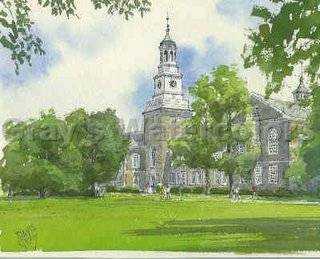
|
| William Penn Charter School |
Further West on School House Lane, is the William Penn Charter School. It's also Quaker, and while it doesn't work quite so hard at it as GFS does, it has plenty of social mission, a great deal more discipline, and plenty of competitive athletics. A minority of its students, also, are Quakers; but as a guess, most of its graduates are headed for disproportionate affluence anyway. The middle school is named for, and was donated by, the former chairman of Morgan Stanley back before Morgan Stanley sold itself to Dean Witter. This school was founded in 1689, and for a long time was located at 12th and Market Streets in Philadelphia, right where the famous PSFS building was built, the one that later converted to Lowe's Hotel .
Finally, near the crossing of Henry Avenue with Schoolhouse Lane, is the Philadelphia University. Since it was founded in 1999 it is the youngest of the schools on School House Lane, specializing in architecture and design, and seems headed for even broader curriculum. The University was formed by the merger of Ravenhill Academy for Girls, and the Philadelphia Textile School. The Textile School was itself formed during the 1876 Philadelphia Centennial, when local industrialists became concerned with how backward America seemed in its quality and design of textiles, compared with other nations which exhibited at that World's Fair. Next door, was once the home of William Weightman, a chemical manufacturer who was reputed to be the richest man in Pennsylvania. After his death, the rather grand estate became the site of the Ravenhill School for Girls, which was the school which could boast Grace Kelly for an alumna. That was natural enough since she lived just around the corner on Henry Avenue and could walk to school. The contrast between the two ends of School House Lane, Henry Avenue on one end, and Germantown Avenue on the other, is just astounding.
So there you have School House Lane. A few short blocks with three distinguished preparatory schools and a university. Plus, the site of three other famous schools which have either moved or merged. You might think Germantown was the home of myriads of school teachers, but that isn't exactly so. It's hard to say just what this complex anomalous situation proves, except to voice the opinion that it is somehow at the heart of what Philadelphia really is.
Note, kind readers have also sent me the names of six more schools on Schoolhouse Lane. Some of them may only be name changes, but the list includes Parkway Day School, Sklar School, Philadelphia Textile and Science, Germantown Stevens Academy, Germantown Lutheran Academy, Greene Street Friends School. (See Comments.)
Quakers Turn Their Backs on Power
There have been a number of excellent books about Ben Franklin lately, but all take his side in the dispute with Quakers. These authors relate Franklin struggled with the Quakers, fought with that political party, heroically overcame them with wisdom and guile. Good thing, too, or we all might still be subjects of the British crown.
Well, within the Quaker community these events are viewed differently. Around the year 1755, the Quakers who owned and ran Pennsylvania abruptly turned away from politics and left the government to their political enemies, rather than compromise religious principles. It is difficult to think of any other instance in history when a ruling party decided to become humble subjects of the opposing party, simply because they refused to do what obviously had to be done.
The background of this perplexing issue goes back to the founding of the Quaker colonies, which had lived in a real Utopia for seventy-five years. Repeatedly it had been true that if they just followed the highest principle, things worked out well for everybody. For example, they didn't need to buy the land a second time from the Indians, but they did, with the gratifying result of peaceful co-existence while other colonies experienced constant Indian wars. Penn negotiated the borders of his states with the neighbors, and although it took decades, brought peace and prosperous trade in return. Strict honesty in mercantile matters led to a reputation for trustworthiness, and that in turn led to prosperous commerce. Using a fixed price rather than haggling over price speeded up transactions, gained respect for fair dealing, led to more prosperity. Just you do the right thing, and all will be well. That includes extending freedom of religion, welcoming strangers to the colony to worship together in peace.
Toward the end of this Utopian period, some questions began to arise. More and more non-Quakers came to the colony, making the colony progressively less Quaker. That was a silent disappointment to William Penn. The founder had been a charismatic evangelist for his religion as a youth but came to grave disappointment about peaceful persuasion by the end of his life. Convincing the adherents of other religions of reasonable Quaker principles had often proved to be as intractably difficult as arguing religion with Henry VIII. The Quakers, a religion without a clergy, were appalled that so many adherents of other religions did not concern themselves with earnest reasoning, preferring to do strictly what their ministers told them to do.
Another disconcerting thought was growing within the Quaker community that success itself might be corrupting them. Worldliness seemed to grow inevitably out of wealth and prominence; all power does tend to corrupt. If you are rich, people always seem to steal from you, and that leads to violent punishments, something regrettable in itself. These were not new arguments, but by 1750 nearly a century of success in paradise had begun to stir Pennsylvania Quakers to wonder why more of their neighbors did not ask to become Members. These were troubling concerns of the day which would probably have worked themselves out, except that far-away France and England declared war on each other. The French responded by stirring up the Indians along the Western frontier. Pennsylvania settlers were soon scalped, kidnapped and burned at the stake. Something had to be done about it since protection was a duty of government, and effective protection now had to be non-peaceful. The Quakers dithered. More Scotch-Irish settlers around Pittsburgh were slaughtered. The Quaker meetings sent minutes to the Quakers in the legislature that they must not compromise their peaceful principles, and the Scotch-Irish exploded with rage. The Meetings told their representatives to resign from office, their members to retreat from politics altogether.
So Ben Franklin rose to the occasion, and General Forbes led an army to Fort Duquesne at the forks of Ohio, and Colonel George Washington was the hero of that day. The French were driven off the frontier, the English were victorious at Quebec. North America became a British continent.
Meanwhile, the Quakers retreated into tight-lipped solitude. And self-doubt, because the episode seemed to demonstrate that rigidly peaceful principles cannot govern a state or a nation if that nation contains others unwilling to be sacrificed for peaceful principles. An unthinkable logic emerged; freedom of religion led to conflict with the duty of a non-violent government to protect its citizens. It began to be clear it was the duty of government to enforce its laws, by force if necessary. Underneath the pile of documents, was a gun.
So, the Quakers proudly walked away from power and dominance, for all time. Sadly, too, because the significance was clear. Peaceful utopia may be not possible, within a dangerous world.
Keeping Lunaticks Off the Streets
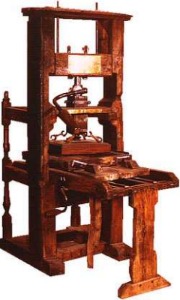
|
| Benjamin Franklin Print Press |
The Protestant Reformation provoked a wide variety of reasonings, and the Quaker position is at one extreme of them. One way of looking at it is to see the Reformation as largely a reaction to the invention of the printing press. At first, there was the impact of Latin versions of the Bible, or Vulgate, which could be read by priests like Martin Luther, and possibly interpreted by them to vary from established Church doctrine. Translation of the Bible into common languages subsequently permitted educated parishioners to read the Bible for themselves and draw their own conclusions. Fundamentalist branches of the church tend to place almost total reliance on what they can read for themselves, and consequently, authenticity is highly important to them. The Quakers go a step further, encouraging each member to come to his own spiritual viewpoint ("There is that of God in every man."), using the Bible as merely one important resource. Although others sometimes regard them as spiritually adrift, the Quaker idea is that if something is really true, everybody who thinks hard about it will eventually come around to much the same conclusion. (Related to this attitude is a strong belief in the ultimate triumph of democracy, and the essential rightness of market-set prices.) Some people try harder than others, of course, and they come to be regarded as "weighty" Friends, likely to have reached the correct conclusion somewhat sooner than others.
One very weighty Friend was Henry Cadbury, an American relative of English candy makers. Henry decided he wanted to spend his life teaching the Bible and went to Harvard Divinity School. He became in time the leading authority in the world on the Book of Acts, editing that section of the Interpreter's Bible, and rising to be Professor of Divinity at Harvard. Henry knew his stuff, so to speak.

|
| Henry Cadbury |
One fine summer day, Henry was seated in the front row of the Haddonfield Meeting. Birds twittered outside the open doors and windows, but otherwise, the gathered meeting was entirely silent. It was even beginning to look as though this meeting would be one of those occasional instances when nothing is said for an entire hour -- a "silent meeting". But, no, a visitor came through the open back door of the meetinghouse, in response to the sign found outside almost every meetinghouse, "All Are Welcome". The man was evidently a fundamentalist, and seeing a large audience all sitting silently waiting for something, he advanced boldly to the front of the meeting and began to speak.
The Bible was the Word of God. Every word in The Bible was true -- literally, and incontestably true. The theme was repeated several times, without an apparent response from the audience.
Finally, Henry Cadbury stirred himself. "Well, it has always struck me...". Oh, oh. Look out, here it comes.
"It has always seemed to me, that the most quotable parts of the Bible, are mainly based on the faulty translation."
Free Quaker Meetinghouse
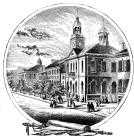
|
| Independence Hall |
Until this year, there was a Beautiful Mall stretching north from the State House (Independence Hall) to the approaches of the Benjamin Franklin Bridge. Concealing an enormous parking garage underneath it, the surface looked like a several-block lawn lined with flowering trees in the spring, framing the beautiful Eighteenth Century building (just as the mall in Washington leads up to the Washington Monument.)
Stretching from Independence Hall east to the Delaware River is another mall filled with historical buildings like Carpenters Hall , the First Bank(Girard's) and Second Bank (Biddle's), the Old and the New Custom houses, the American Philosophical Society, and others. The eastern mall was the property of the State of Pennsylvania when it was created, but it soon seemed more economical to the frugal rural legislature to turn it over to the federally funded National Park Service, joining the mall stretching northward. Well, somebody got another ton of federal money appropriated, and now we are filling the north mall with buildings which largely hide Independence Hall from the passersby. With just a few more Congressional earmarks, the imposing beauty of the mall will be submerged, but it hasn't quite reached that point yet. There is a perfectly enormous New Visitors Center, containing a couple of auditoriums and a big bookstore. Mostly the concept seems to be to provide a place to get out of the rain if you are an out of town visitor, provide public bathrooms, and a place to get a hot dog. At least the visitors center is red brick, and arched, with white woodwork. At the far northern end is an overwhelming stark granite block of a building, which will open July 4, 2003. It is a Constitution Center, claimed to be an interactive museum, and we shall see what we shall see. The looming monolith overwhelms and blocks the view to Independence Hall, and it better be good, when the insides get finished.
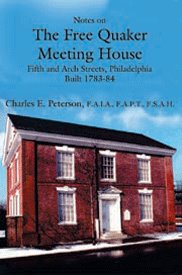
|
| Free Quaker Meeting |
If Independence Hall, which after all is a block long, is overwhelmed by the new constructions, the Free Quaker Meeting is totally hidden. This perfectly charming Eighteenths Century Quaker meetinghouse is just across Fifth Street from Benjamin Franklin's Grave, and just across Arch Street from the Constitution thing, completely in its shadow. Charles E. Peterson designed the restoration of the building, which had been added to and detracted from, over the years, but you can be sure its interior is now both beautiful and authentic. Before you go in, notice the inscription on the plaque under the northern eaves:
By General Subscription for the FREE QUAKERS. Erected in the Year of OUR LORD 1783 and of the EMPIRE 8.
The Quakers who built this building seem to have thought they were part of a new empire, but that implies an emperor, and of course, one was never created. Three years after the dedication of this building the Constitutional Convention met in the same Independence Hall, and our national form of government was somewhat strengthened from the Articles of Confederation also written here. Benjamin Franklin had a hand in both documents, but the first one was mainly composed by John Dickinson, and the second one by James Madison. If you go into the Free Quaker building, it seems to be a single large room with an interior balcony, and a couple of small staircases in the back leading down to what would presumably be restrooms. As a matter of fact, the Park Service extended the basement to include kitchen and dining room, and several offices for themselves which are a surprise if you are allowed to go down to see them.
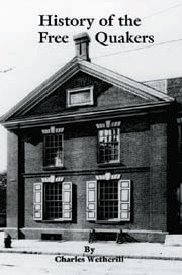
|
| History of Free Quakers |
Charlie Peterson wrote a book about the restoration, but the main book about the spiritual history of this group was written by Charles Wetherill. Quakers, as everyone ought to know, are pacifists. The American Revolution put a number of them in a quandary because they agreed that Great Britain was injuring their rights by denying them a representative in the Parliament which ruled them but resorting to violence was another matter entirely. Eventually, a group did break away from the main Quaker church to fight for independence. They were prompt "readout of the meeting", the equivalent of being excommunicated, not allowed to worship in the regular meeting houses they had helped finance or to be buried in the church graveyards. Samuel Wetherill was one of the leaders of this group, just as his descendants are the most active today in the surviving historical society. Samuel created quite a furor, demanding to use the Orthodox meeting house and burial grounds. He was, in his own view, just as much a Quaker as the others since no doctrine is absolutely fixed in that religion, and was freely entitled to speak his mind to persuade others of the rightness of his sincere positions. The main body of Quakers would have none of it, and the Free Quakers were firmly expelled, forced to hold a public subscription and build their own meeting house. Wetherill of course personally knew every one of the members who expelled him, and there may be some truth to his loud, pointed and unchallenged contention that the true division was not between pacifists and fighters, but between Tories and advocates of Independence. Whatever the truth of these accusations, it does seem in retrospect that the split was fairly divided between wealthy established merchants, and small shopkeepers and artisans. Quite a few now-famous names appear on the rolls of the Free Quakers, like Timothy Matlack the actual Scribe of the Declaration of Independence document, Biddles, Lippincott, John Bartram,Crispins, Kembles, Trippes, and Wetherills. When the meeting had dwindled down in 1830 to two lone parishioners, one was a Wetherill, and the other was Betsy Ross, herself.
A comment is submitted by a reader:
I think your description of the Free Quakers oversimplifies their origins. It is true that Samuel Wetherill was disowned by Friends for his military activities. However, other Free Quaker leaders were bounced -- often years before the Revolution -- for other reasons. Timothy Matlack, for not paying his debts. Betsy Ross, for an improper marriage. Christopher Marshall, for counterfeiting. I haven't traced everyone listed as a member in the (1907?) Stackhouse history of the Free Quakers. But I did search in Quaker records for perhaps a dozen and found no records that people with those names had ever been Quakers. I think it would be more accurate to say of the Free Quakers that the Revolution drew together people of many different types and that when some of those people had things in common -- such as Quaker background -- they united around those things. (Posted by Mark E. Dixon )
The No-Doctrine Doctrine
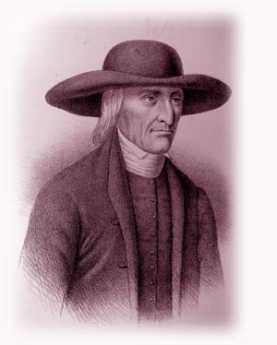
|
| quaker |
Although Quakers have long been famous for good relations with the Indians, both groups strongly prizing simplicity and keeping your word, few Indians converted to Quakerism. Indians would attend the silent meetings and listen respectfully, but in the end, Christian converts were far more likely to convert to the Moravian Church. To resist defining your common beliefs creates automatically a problem for explaining what you believe. It becomes acceptable to believe a wide range of things, but it is also acceptable to believe very little. Not surprisingly, the two great religious schisms of the Quakers have broken their unity on just this point.
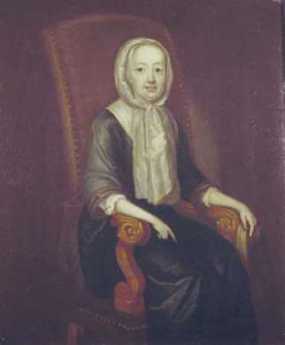
|
| A History |
The first great Quaker schism was created by one George Keith (1638-1716), who was born a Presbyterian and died an ordained Episcopalian. For several decades, however, Keith was one of the foremost leaders of the Pennsylvania Quakers, partly as a result of being just about the best-educated man of the Colony. His leadership, however, led him to crave a more defined set of Quaker doctrines, and when he carried this idea too vigorously, he eventually encountered implacable opposition which in time caused him and his considerable number of followers to be expelled from the Society of Friends. (George Keith should not be confused with Sir William Keith, whom Hannah Penn appointed as governor of Pennsylvania in 1717.)
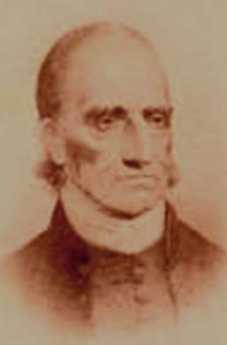
|
| Elias Hicks |
The first great schism was thus about whether there might be too little defined doctrine in Quakerism. The second great schism, by contrast, grew out of the feeling there was too much doctrine. Led by Elias Hicks in 1830, the Hick sites split off from mainstream Quakerism in a quest for more simplicity, less religiosity, more silent contemplation of the Inner Light. In a sense, the outward show of protest in the black hats, plain dress, the plain speech had provoked a reaction that these things were no longer simple, they were ostentatious. Too many people were being "eldered", too many people were being "read out of the meeting" for violating doctrinal rules.
Curiously, both rebels were cast out, but over each following century the church as a whole gradually adopted what was largely their view of things. After Keith, Quakerism became more rigid and formalized. After Hicks, it became more mystical and free-thinking.
By insisting that in spite of turmoil it caused no doctrine was to be defined, Quakers have edged into the negative position of defining what they are not. Unlike the early sects of Christianity, Quakers have discarded the hope of miraculous divine intervention as a reason to behave in a Friendly Christian way. No one is apparently going to revive your bones from the tomb, feed your multitudes with forty loaves, or descend from Heaven and drive your enemies into the sea. Neither a later reward in Heaven nor a forthcoming everlasting punishment in Hell can be regarded as either very likely or much of an incentive to good behavior. Other religions may believe these things and might even turn out to be right, but Quakers feel the unembellished Golden Rule is a sufficiently understandable motive for conduct.
And gentle indirection is often a better way to persuade others than thundering oratory. The story is told of a visitor who found himself in a Quaker gathering and made polite conversation by asking what the Quaker position was on the Trinity. A sweet old gentleman is said to have smiled and said, "We believe in the following Trinity: The brotherhood of man, the fatherhood of God -- and the neighborhood of Philadelphia."
The American Friends Service Committee
Two things uniquely characterize the work of the Friends Service Committee (AFSC): it's often both dangerous and unpopular. That's not required for relief following Indonesian tidal waves perhaps, but the work that really needs someone to do is often both dangerous and controversial.
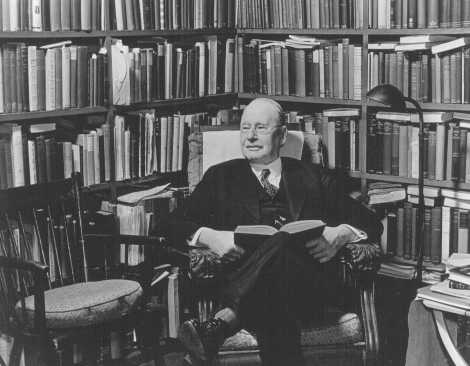
|
| Rufus Jones |
The Service Committee was founded in 1917, mostly by Rufus Jones and Henry Cadbury, as a way of helping conscientious objectors to World War I. The Mennonites, the Brethren, and the Quakers were opposed to all wars, not just that particular one, but two of those religions are of German ancestry, and lacked the same credibility of the English-origin Quakers in a war with English allies against the Huns, Boche, and Kaiser enemies. The early focus of the Committee was on the Field Service, or Ambulance Corps; which was plenty close to the action, and plenty dangerous. After the War, the defeated German population was starving, and the Quaker Herbert Hoover directed the relief effort with great credit to the Quaker name, and immense European gratitude.
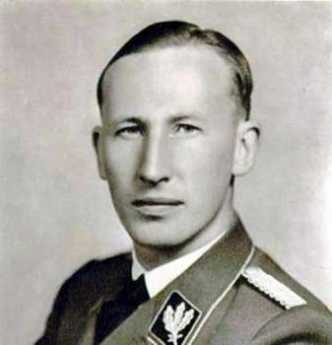
|
|
Reinhard Heydrich was the primary organizer of the mass murder of Jews in the Third Reich. |
After that, when German Jews were suffering persecution by the Hitler administration, the Quakers initially responded in a uniquely Quaker way. Rufus Jones and two other Quakers went to see Reinhard Heydrich, to tell him the world disapproved of his behavior. They fully realized they represented a pool of important world opinion, particularly within Germany, and it was time to speak truth to Power. The Germans left the room to confer, and the three Quakers bowed their heads in silent prayer. Apparently, the room was tape recorded, and when the German officials returned, they did promise some efforts to improve matters. As the situation for the Jews soon got much worse, many Quakers risked a great deal to shelter and rescue the persecuted exiles. Relief to the defeated German populace had to be repeated after that war, as well. Each effort built up more credibility to be able to switch sides for the next effort, and the sincerity has seldom been seriously questioned.
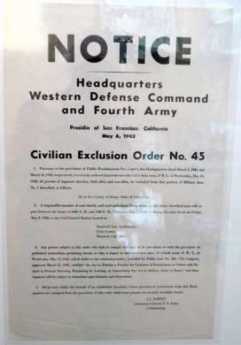
|
|
U.S. government notices to American citizens or aliens of Japanese ancestry in May 1942 that they must move to internment camps. (Photograph by Dorothea Lange.) |
The Japanese were also our hated enemies in World War II, and once more a long history helped the relief effort. Nearly 100,000 American citizens of Japanese origin were interned on the West Coast as potential traitors in 1941, often under deplorable conditions. Clarence Pickett was a director of AFSC at the time, and his sister had spent years in Japan as a missionary, so his remonstrations with the American government were prompt and credible. One of the more active workers was Esther Rhoads, sister of the famous surgeon, who had spent time in Japan earlier. One of the ingenious efforts with the Nisei was to assist 4,000 of them to get into college and find them hostels and jobs while they were away at school. Many of these college students later became prominent in various ways, greatly assisting the post-war reconciliation between the two countries.
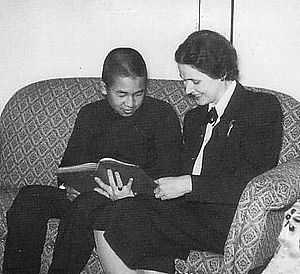
|
| Crown Prince Akihito and Elizabeth Gray Vining |
Two Quaker ladies at the AFSC made a totally unique contribution when a request was received to provide a suitable tutor for the Crown Prince, now Emperor. He didn't convert to Christianity, but he later married a Christian, and you can be sure he got a plenty good dose of Quaker style and belief from Elizabeth Gray Vining. This tall, strikingly handsome Philadelphia woman had Bryn Mawr written all over her and turned heads whenever she entered a room. When she went back home, she was followed as a tutor for seven years by, guess who, Esther Rhoads who by then was the director of the Tokyo girls school. It remains to be seen, of course, what the final outcome of this deeply emotional situation will prove to have been. At the moment, the main sufferer seems to be the immensely talented American-educated woman who married the Emperor. But we will see; these are all powerful women in a very quiet way, unaccustomed to losing. One wishes the royal family all the best in their sometimes difficult position.
And then the Service Committee did its work in Vietnam, in Iraq, in Zimbabwe, and Somalia on the unpopular side, in every case. There are stories of venturing into war zones with hundred-dollar bills scotch-taped to their torso, where every fifty feet there was someone who would cut your throat for a dime. One worker in Laos entertained a group of us tourists with tales of living for weeks with nothing to eat but grasshoppers and cockroaches. Dangerous, unpopular, and uncomfortable. It sounds like a wonderful outlet for someone who is a perpetual rebel without a cause, but if you can find one of those at the Service Committee, you must have done a lot of looking.
The Service Committee, like the Quaker school system, is mostly run by non-Quaker staff. That means that neither of them exactly speaks for the religion itself. This little religious group of 12,000 members is stretched thin to provide a vastly greater world influence than its numbers imply. Hidden in the secrets of the group is an enduring ability to attract sincere non-member adherents to their work. And a quiet watchfulness to avoid losing control to any wandering rebels without a cause.
REFERENCES
| Window for the Crown Prince: Akihito of Japan, Elizabeth Gray Vining ISBN-13: 978-0804816045 | Amazon |
Swarthmore College
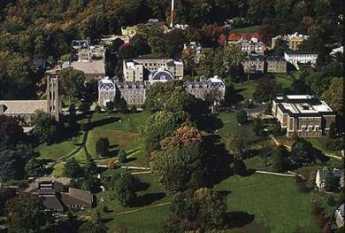
|
| Swarthmore College |
The Friends Association for Higher Education lists 17 American institutions as Quaker Colleges, Universities, or Study Centers. Four of these, Swarthmore, Haverford, Bryn Mawr and Pendle Hill, are located in the Philadelphia region. Until Haverford College recently adopted co-education, it was once possible to say Haverford was all-male, Bryn Mawr was all-female, and Swarthmore co-ed; Pendle Hill has no undergraduates. That greatly oversimplifies a very distinctive set of complexities, however. Since there is no official connection between the colleges and the church, it is a little hard even to explain the sense in which they are truly Quaker, which is by operating under a strong striving for consensus.
Swarthmore is commonly said to be the most Quaker of the three undergraduate colleges, but only 7% of its students are Quaker and only a quarter of its trustees. The most distinctive feature of the college is the so-called Honors Program, patterned after the tutorial system of Oxford and Cambridge, which was brought there in 1921 by a non-Quaker president who had experienced the system as a Rhodes Scholar. The establishment of this program was heavily supported by the General Education Board, which is to say the Rockefellers. As a reflection of the pressures of graduate schools, and possibly student preference for a greater variety of subject material, only about a third of the students elect to take the Honors Program. It is, however, the central core of the college.
The name of the college derives from Swarthmore, which was the English home of George Fox, the founder of Quakerism. Early Quakers were uncomfortable with the colleges and universities of their day, which had been founded to educate priests and ministers of various other religions, gradually enlarging their mission to include the children of upper-class families. The motto of Eton College embodies much that made Quakers wince: "Eton exists to exert a civilizing influence upon those who are destined to rule." Even the American variation of that there is scarcely an improvement since it would probably say something along the line of offering the opportunity to increase the student's future life income by 70%. It is easy to understand why Quakers wanted to have their own school system, protecting their children from attitudes and influences they disapproved of. Although the Civil War somewhat disorganized the early directions of Swarthmore, for fifty years it was a simple rural college, aimed at avoiding modern influences more than seeking a defined unique role. And then along came Frank Aydelotte.
Very likely, a major appeal underlying the Oxbridge seminar system to Aydelotte and the Quaker trustees was its modern evolution into a model for producing those unusually talented and incorruptible civil servants, who really run the British government under the nominal control of elected officials. Such ambitions necessarily imply a need to attract unusually bright students, and Aydelotte's method was to keep the student enrollment smaller than a well-financed faculty could attract. Unfortunately, as brighter non-Quaker applicants were attracted, more and more Quaker applicants had to be rejected. By 1953, the incoming new president, Courtney Smith, was prompted to make the rueful observation, "Franklin Roosevelt's record at Harvard, and Adlai Stevenson's at Princeton, and Dwight Eisenhower's at West Point, were scarcely, I am told, pace-setting." Almost every American college now faces something like the same conflicted feeling, since globalization implies that all Americans, not merely Quakers, might someday be excluded from their own colleges in order to make room for, say Orientals, who are brighter. Remaining small, however, Swarthmore does have the latitude to seek its own solutions, one of which has been to create the pre-eminent scholarly center for the study of Quakerism.
There are other quiet paradoxes atSwarthmore. From rural simplicity to suburban elegance, the physical transformation of the campus made possible by generous funding might distress only a Quaker. Indeed, Arthur Hoyt Scott of the class of 1895 donated 330 acres of ornamental garden in 1929, composed of beautiful ornamental plants, that no matter what their origin would thrive in the Delaware Valley. Not only is this garden a premier place to visit, but it is also one of the inspirations along with Longwood and Bartram's Gardens for landscaping of the entire Mid-Atlantic region.
And then there is the subsequent history of Frank Aydelotte. True, after he left Swarthmore he became a Quaker, himself. But he left to implement the educational ideas of Mr.Bamburger the department store magnate at the new Institute for Advanced Study in Princeton. That is, at that unquestionably pre-eminent intellectual center whose main achievement so far has been the development of, the atom bomb.
REFERENCES
| Swarthmore College: An Informal History: Richard J. WaltonASIN: B0006ELCO8 | Amazon |
Quaker Doctrine and Schism
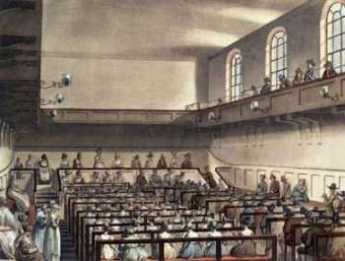
|
| Society of Friends |
The Society of Friends had never promulgated articles of religion to be subscribed, or a catechism to be taught." In this curious manner, a lack of doctrine has become the doctrine. Still more unexpectedly, a religion dedicated to peace and non-violence has mostly defined itself by resisting some proposals so violently that schism was the result. The central propositions can now be best deduced by observing the reasons why dissenters departed the Society, or why agitators were invited to depart. It can be questioned whether the early Quakers who shaped the Society really intended for non-members to define it. And so, eligibility for membership became the place where the doctrine was found, formed and enforced.
In 1691 the first serious rebellion from non-doctrine came from George Keith, who may well have had exactly this issue in mind. Aside from Thomas Lloyd the Deputy-Governor, Keith was the most learned and educated man in the colony, with a large following of admirers. It seems unfair to accuse Lloyd of jealousy, but he was probably Keith's only intellectual equal at the time, and was burdened with the responsibility of governing the colony with full respect for the interests of the then-absent proprietor, William Penn. When Keith raised the concern that unwritten Quaker principles could not be confidently explained or disputed, Lloyd remained silent for a time. However, when antagonism to what Keith was saying reached the point of prosecution and expulsion from the Society of Friends, Lloyd must certainly have been in the background. Keith eventually became an Anglican priest, taking a number of Quakers with him. It must be said on behalf of George Keith that he made the first written protest against negro slavery, sixty years earlier than the more famous actions of the Germantown meeting. His eventual spiritual direction is surely evidence that he longed for closer adherence to Biblical Christian teachings or even rituals. Lloyd, on the other hand, is thought to trace descent from the early Princes of Wales, and could well have over-reacted to ideas which might destabilize power.
Keith may have been more persuasive than he seemed, however. By 1827 the pendulum appears to have swung against excessive thee-and-thou doctrine, however unwritten it may have been. Having experienced one schism from those who wanted more doctrine,

|
| Elias Hicks |
Elias Hicks then split the Society with a return to mysticism, seeking less rigidity and doctrine where Keith had once demanded more of it. After the 1827 separation, Quakers were to remain divided into two religions, the Hicksite and the Orthodox, for a century until Rufus Jones led the two factions to reunite. The banners they waved were "the inner Christ" and the "outward Christ" and for some, the central issue was Biblical doctrine and ritual. For others, it was a matter of balance between obedience and individualism. At present, the Quaker doctrine remains unwritten, although a book called "Faith and Practice" explains what has been customary. Quakers are now a long way from wearing black hats and "plain" speech, and in fact, do come fairly close to what Hicks was striving for. In many ways, the doctrine of "the light within" is held to be sufficient to define the mystical core of Quaker belief, from which everything else may be derived, particularly when it is linked to another central belief, that "there is That of God, in every man." William Penn's famous tolerance of religious freedom, for example, can be viewed as a comfortable belief that if serious people of all religions examine the issues deeply, it can be expected they will all eventually reach about the same conclusions.
The simple formula of "not enough ritual" versus "too much ritual" arriving at its present state of "just enough ritual" must be qualified by two other schisms, however.
When the Revolutionary War came to Pennsylvania, a certain group of Quakers exemplified by Betsy Ross, Timothy Matlack and Nathaniel Greene but led by Samuel Wetherill, wanted to fight for Liberty enough to split off their own church, The Free Quakers.

|
| The Free Quakers. |
Although the surface issue was opposition to the war for any reason, in 1781 the Revolutionary War was mostly over, at least in the northern colonies. Several prominent Free Quakers had been read out of the meeting before the Revolution for reasons unrelated to it, and many other joiners to the Free Quakers had apparently not previously been practicing Quakers at all. The larger underlying political upheaval was the Quaker withdrawal from government twenty years earlier. This too was explained as a refusal to fight wars for any reason, but it can also be seen as the dilemma of all religious states, who cannot fairly govern a non-believing minority without either persecuting them or allowing them to usurp. Buying the land from underneath the Indians was one thing; living peacefully alongside the unruly Scotch-Irish of Western Pennsylvania proved to be quite another. The splitting off of a separate sect of Quakers with a different doctrine must be seen in the context of an even larger migration out of Quakerism entirely, into the Anglican, later Episcopal, church, which was favored by the wealthier segment of colonial Quakers, encouraged by some doctrinal adjustments by Bishop White. Even that synopsis fails to capture what was happening. In 1705 the Pennsylvania Assembly, composed entirely of Quakers, signed a petition to King William III ("William of Orange") which had the effect of a bargained compromise: in return for permitting affirmations instead of oaths, the King agreed to extend liberty of conscience under the English Act of Toleration of 1696 to those who subscribed to what would today be called the Apostles Creed. Through the hazy lens of intervening history, it is difficult to see why this was a useful compromise, except for what is implicit. As long as Pennsylvania was firmly Tory, the English king would do any necessary fighting on the frontier, and the pacifist Quakers could continue to control the government. Seventy years later, in 1776, that no longer seemed a workable arrangement, and in fact, the Quakers had withdrawn from the government in 1756.
After the upheavals of adjusting to a new system of government, the nation settled down to enjoy what was the main reward of Independence: vast stretches of unoccupied fertile land to the West. A selectively agrarian segment of Quaker society migrated to Ohio, Indiana, and Iowa. These scattered pioneers did not have Penn, Lloyd, and Logan to guide them, and felt a much greater need for pastoral guidance. In time, mid-western and western Quakers evolved into formal churches with ministers, and colleges to teach the ministers, while the eastern seaboard Quakers remained seated in silent worship, without ministers or music, in "unprogrammed meetings". And so, back to where we started, searching for the proper balance between mysticism and ritual. But primarily among those Quakers who remained unmoved, spiritually and physically, by the fragmentation of what had once essentially been an established religion.
Politics of the French and Indian War
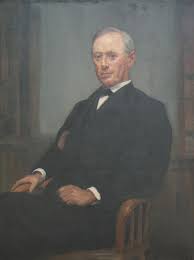
|
| Isaac Sharpless |
In the European view, the French and Indian War was a mere skirmish in the many-year conflict between France and England. But the Atlantic is a wide ocean. The local Pennsylvania politics of that war concern the land-hungry settlers striving for Indian lands, the Quaker Assembly doing its best to maintain William Penn's formula for peace ("No settlements without first buying the land from the Indians."), and William Penn's far-from-idealistic Anglican sons, focused on profit from a land rush. Western Pennsylvania belonged to the Delaware tribe, but the Delawares were subject to the Iroquois nation. The year is 1754. The following pro-Quaker description is given by Isaac Sharpless, president of the Quaker Haverford College between 1887 and 1917 (Political Leaders of Colonial Pennsylvania,
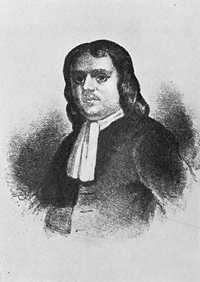
|
| Isaac Norris |
Isaac Norris was appointed to another Albany treaty with the Indians in 1754. The commission consisted of John Penn and Richard Peters representing the Proprietors, and Benjamin Franklin and himself, the Assembly. Indian relations were becoming difficult. The Five Nations still claimed the right to the ownership of Pennsylvania and insisted that no sale of land by the Delawares was permissible. In an evil hour, the government of Pennsylvania recognized this claim and this Albany meeting was for the purpose of effecting a purchase. By methods that were more or less unfair, taking advantage of the Indian ignorance of geography, they bought for 400 pounds all of southwestern Pennsylvania. When the Delawares found their land had been sold without their consent, they threw off the Iroquois yoke, joined the French, defeated Braddock's army a year later and for the first time in the history of the Colony the horrors of Indian warfare were known on the frontiers.
Although Sharpless goes directly to the unvarnished truth of the situation, he reveals the depth of his bitterness by openly discarding Franklin's cover story about being in Albany to propose political unity among the British colonies.
It was on this expedition that Franklin presented to his fellow delegates his plan for a union of the Colonies, of course in subordination to the British Crown which was a precursor of the final union in Revolutionary days. Sixty years earlier William Penn had proposed a somewhat similar scheme.
The war came, French intrigue and the unwisdom of the Executive branch of the government of the Province (the Penns) drove the Indians, who for seventy-three years had been friendly, into the warpath. Cries came in from the frontiers of homesteads burnt, men shot at their plows, women, and children scalped or carried into horrible captivity, and a growing sentiment among the red men that the French were the stronger and that the English were to be driven into the sea.
Plain Speech

|
| Goofy Cartoon |
Philadelphians don't dislike New York; to them it's like an occasional visit to Disneyland. One day, a Main Line lady dressed her seven-year-old daughter in a little hat, shiny Mary-Jane shoes, and white gloves and the two went off to Gotham. The little girl kept her nose glued to the window of the taxicab.
They passed a midtown street corner of Fifth Avenue, where a cluster of young women, all painted up and overdressed, were waving at passing cars with one hand while brandishing a cigarette with the other. The little girl said, "Mommy, what are those ladies doing?" To which her mother replied, "Why, dear, they are waiting for their husbands to come to take them home."
At this point the cabbie turned around in the front seat and snarled, "Lady, why don't you tell your daughter the truth? You know those are Ladies of the Evening."
After a little silence the little girl asked, "Mommy, do Ladies of the Evening have any babies?"
"Yes, of course, Dear " replied the mother. "Where do you suppose taxi drivers come from?"
Philadelphia and Japan
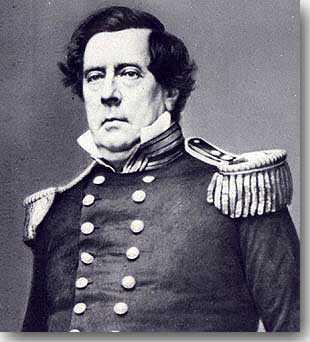
|
| Commodore Matthew Perry |
There may have been earlier contacts, but the strong relationship between Philadelphia and Japan seems to trace mainly to the 1876 Centennial Exhibition here when the awakening Japanese decided to introduce themselves to Western peoples. Japan closed itself off from the rest of the world in 1600, and Matthew Perry opened them up in 1854 by shocking them with a display of how far Western culture had pulled ahead of them. When they saw the black smoke coming out of the smokestacks of the steam battleships, and particularly when they saw all those big guns could destroy a town whose own guns could not reach them, the Japanese military government saw it had to do something drastic.
Matthew Perry, the Commodore, was Oliver Hazard Perry's younger brother and a career naval officer. It is very likely he suggested a Japanese overture to President Millard Fillmore, whose brief presidency was mostly occupied with trying to compromise his way out the coming Civil War in America. Reacting to a mixture of just enough implied force, and just enough understatement, the Japanese agreed to let American whaling ships refuel and resupply in Japan, to be hospitable to American shipwrecks, and to allow more unspecified landings. As the Japanese tell it, the Emperor had been displaced by the Shogun for several centuries and was restored to power in 1867. Essentially, forces pressing for westernization and trade had pushed aside more militaristic feudalism under the Samurai. By 1876, they were ready to show the world how far they had come.
Friends Lifecare at Home
Over thirty Quaker retirement villages scatter through America, more than twenty in the suburbs of Philadelphia -- "under the care of the Yearly Meeting", as their expression has it. But for some people, community living seems unattractive. It does not speak to their condition.
For one thing, it may not be affordable.

|
| Friends Lifecare |
Or the style of may seem too fancy, or too plain, for some tastes regardless of cost. The increasing emotional rigidity of growing older is a factor; by the time people get to be seventy-five, they had better make this decision or forget it. Plenty of people are hale and hearty at ninety, but they establish pretty firm ideas about the sort of person they want for neighbors while they are still in the workforce. Quite often it's just a habit, people have lived in their home for several generations and cannot imagine another neighborhood, lifestyle, or environment. This is home, and they intend to die there.
So, to address this need, or market, a group of Quakers conceived of a retirement village without walls. Live in your own home and someone will come to oversee things, will know what to do if there is an emergency, and may eventually make the decision for you that you absolutely must go somewhere else. All of this is wrapped within an insurance vehicle, to recognize the fixed incomes of retired people, the inevitability of terminal illnesses, and the occasional risk of monumental medical expenses. At present, about 1600 people in Philadelphia are enrolled in the unique plan of Friends Lifecare at Home, making it one of the largest retirement communities in the country. The organization receives universal praise for its imaginative responses, as well as the dependability and high quality of the people it sends out to the homes of subscribers. Friends Lifecare is a pioneer, and it is gradually weeding out the ideas that didn't work and adding new features that were not originally contemplated. One of its greatest challenges is the need to adapt to unexpected and uncontrollable changes in the Medicare program. Slashes in the Medicare program could bankrupt Friends Lifecare, and even sudden windfalls like the Medicare Drug Benefit create management problems. There can be no doubt that one element of trust exists for which there is no substitute; Philadelphians know that the invisible support of the community and its Quaker core is behind them. If anyone can possibly preserve a moral commitment to the elderly, it will be the Quakers.
Ultimately, the commitment is not so much to 1600 subscribers as to the notion of finding out what works. Life expectancy has extended by three additional years, during the past ten; that's a joy, but it's a problem to finance. The optimum size of the organization is also an unsettled question. Although this program is relatively large by comparison with individual retirement villages, it may not be large enough to have spare capacity to cope with influenza epidemics or record-breaking spells of bad weather. Since it's the only one of its kind, it is vexed by the popularity in ever-widening geographic areas. It must grow to some reasonable size in one area before it can spread its resources to another. By the same reasoning, it must have a reasonable number of prosperous subscribers if it is to accept even a limited number of poor ones.
The idea of creating a seamless partnership with the residential-type retirement villages is certainly attractive, but Friends Lifecare must be careful to avoid becoming too much of a life raft for other people's problems. When the resale price of residential housing rises in a housing bubble, people wish to cling to a rising investment. During the same economic period, the entry and rental price of residential villages also rise. With a great many uncertainties that are specific to this pioneering effort, it is hard to know what policies to develop to insulate the lifecare environment from speculation in the mortgage and housing markets. Or, right now, high-rise apartment development. All of this creates a need for clear minds in the governance, determined to see and acknowledge difficult reality. If anyone can do it, Quakers can.
The Walking Purchase
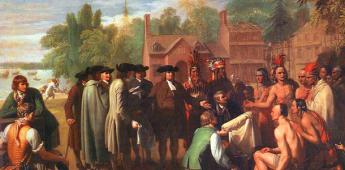
|
| William Penn and the Indians |
Any fair discussion of Quaker relations with the Indians must emphasize that almost all other colonists of the time regarded Indians as subhuman components of the local wilderness. Only William Penn was careful to treat the Indians as fellow human beings, entitled to fair play, dignity, and respect. Like a good politician, he entered into their games with enthusiasm and definitely earned their respect by outdoing them all in the broad jump contests. Even though he had bought the land from King Charles II, he took care to buy it a second time from the Indians, and for many decades was able to enforce the wise rule of never permitting settlers on the land before the Indians agreed to its purchase. After Penn's death, however, and particularly from 1726 to 1736, a major wave of German and Scotch-Irish immigration created an overwhelming population pressure on the seaboard areas, resulting in much unauthorized pioneering and settlement. Since William Penn spent only a few years in the colonies his agents chiefly James Logan, had long set the tone.
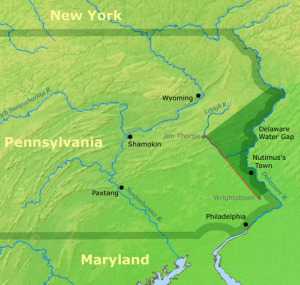
|
| Walking Purchase |
Logan had been equally famous for his many efforts to treat the Indians fairly, and the grounds of Stenton, his manor house, were often filled with Indians come to pay their respects. Against all this evidence of the benign attitudes of both Penn and Logan, there stands the episode of the Walking Purchase of 1737. No doubt about it, the Indians were treated badly.
In the triangle between the Neshaminy Creek and the Delaware River, the Delaware Indians agreed to a sale with the third side of the triangle established at a distance from Wrightstown, as far as a man could walk northward toward the Wind Gap in a day and a half. That was a common form of boundary for Indian land sales, and its distance was fairly well understood. In anticipation of pacing out the distance, the colonists sent out explorers to find the easiest path, then sent out woodsmen to clear a path in the forest, and selected three of the fastest runners in the colony to do the running. The pace was so fast that two of the runners had to drop out, and the third one nearly did so. The resulting boundary was nearly twice as far into the wilderness as was commonly accepted for the measurement, taking advantage of the sharp bend in the river which widened the land in question by a great deal. The Indians were so disgusted they refused to leave the territory. Logan had already made an agreement with the Iroquois nation, to whom the Delawares were subject, and the Delawares only surrendered the land when the Iroquois began to look as though they really would act as enforcers for the bargain. Although serious Indian warfare did not break out for another twenty years, the Walking Purchase went a long way toward convincing the Delaware tribe that the Quakers were no more trustworthy than the settlers in other colonies, and is said to have been on their minds when twenty years later they helped the French decimate General Braddock's army.
There will probably never be a clear resolution of the paradox of Quakers, particularly Logan, behaving in this reprehensible manner within a very long history of the unusually honorable treatment of the Indians. With William Penn now dead and gone, no doubt Logan was caught in a squeeze between the two rather dissolute sons of William Penn, neither of them Quaker, who had over-indebted themselves with high living and were pressing their agent to make land sales to pay for it. Then there was the pressure of the new German and Scotch-Irish immigrants, brought to the New World by real estate promises, and stranded in the seaport unable to complete their land purchases. Under this pressure, Logan may have been unduly persuaded that the 1684 treaties with the Indians, along with many other treaties and understandings, were all the legal justification he needed. Whatever the specifics of the situation at the time, it is now clear the Walking Purchase was a blot on the Quaker record that can never be entirely justified within the Quakers' own standards of fairness. Within the Society of Friends, whatever other English colonists might have done in their position, let alone what French and Spanish regularly did to the Indians, doesn't matter in the slightest.
Benjamin Franklin: Chronology

|
| Ben Franklin on the cover of Time magazine |
January 17, 1706 Born in Boston, the thirteenth child of a candle maker; only went through 2nd Grade, Apprenticed to his brother as a printer, ran away to Philadelphia age 17 .
1723 Arrived in Philadelphia penniless, readily found work as a printer.
1725-26 First trip to England. Researched printing equipment, but probably lived a riotous life.
1726-1748 Returned to Philadelphia to found his own print shop and bookstore. Wrote and printed Poor Richard's Almanack organized local tradesmen into the Junto, formed partnerships with sixty printers throughout the colonies, obtained the print business of local governments, became postmaster. Able to retire at the age of 42 by selling his business for 18 annual payments, which offered him comfort and ease for considerably longer than his life expectancy.
-------------------------------------------------------------------------------
1751 Helped found Pennsylvania Hospital. Entered the legislature.
1751-1757 Active in legislature, rising to leadership during the French and Indian War, Pontiac's Rebellion and the uprising of the Paxtang Boys.
1754Took a noteworthy carriage trip to the Albany Conference, accompanied by fellow delegates Proprietor Penn and Isaac Norris at which he proposed unification of the thirteen colonies to fight against the French. Composed the first political cartoon "Join or Die" for that purpose. Notes for the trip on the blank pages of "Poor Richard's Almanac", now at Rosenbach Museum. The other delegates rejected the plan.
1757-1762 Second time in England. Acted as representative of both Pennsylvania and Massachusetts. After his electoral defeat, he returned to England for a total of eighteen years, suggesting hidden British sympathies may have been present. .
1762-1764 Returned to Pennsylvania Legislature, where his unpopular agitation for replacing the Penn Proprietors with direct Royal government led to his electoral defeat and the end of his elective career. The defeated but determined Quaker party sent him to England to lobby against the Penn family and for the rule of Pennsylvania by the King.
1764-1775 Third British visit. Although unsuccessful in his lobbying, his fame as a scientist made him welcome among the famous members of the Enlightenment, like Hume, Adam Smith, Mozart. Meanwhile, the colonies became considerably more rebellious than he was. His blunder with the publication of some letters gave the British Ministry an opportunity to humiliate and disgrace him in public, probably as a warning to the mutinous New England leaders. It irreconcilably alienated Franklin, who sulked, then packed up and joined the Continental Congress the day he arrived back home.
March, 1775-October, 1776 Brief but fateful return to America. Decisions were made in London to put down the colonists by as much force as necessary. Meanwhile, Franklin persuaded the Continental Congress they must declare independence from England if they expected help from the French.
July 4, 1776, Independence is declared within days after the arrival of a massive British fleet in New York harbor. Franklin dispatched to France to secure the assistance he was confident he could get.
1777-1785 France. Franklin served admirably as American ambassador, his wit and charm persuading the French to overextend themselves with ships, supplies, and money, and very likely contributing to the French Revolution by popularizing the American one.
1785-1790 Returning as a national hero for his final five years of life, Franklin loaned his personal influence to the constitutional convention, became President of Pennsylvania, worked for the abolition of slavery.
April 17, 1790 Died, probably of complications associated with kidney stones.
Logan, Franklin, Library
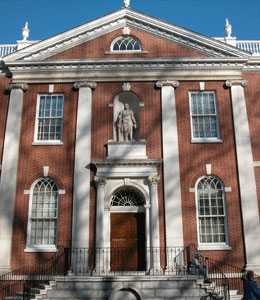
|
| The Library Company of Philadelphia |
Jim Greene is the librarian of the Library Company of Philadelphia, and one of the leading authorities on James Logan, the Penn Proprietors' chief agent in the Colony. Since Logan and Ben Franklin were the main forces in starting the oldest library in America, knowing all about Logan almost comes with the job of Librarian. We are greatly indebted to a speech the other night, given by Greene at the Franklin Inn, a hundred yards away from the Library.
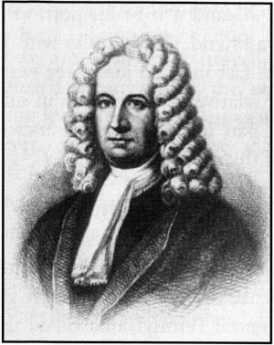
|
| James Logan |
Logan has been described as a crusty old codger, living in his mansion called Stenton and scarcely venturing forth in public. He was known as a fair dealer with the Indians, which was an essential part of William Penn's strategy for selling real estate in a land of peace and prosperity. Unfortunately, Logan was behind the infamous Walking Purchase, which damaged his otherwise considerable reputation. Logan must have been a lonesome person in the frontier days of Philadelphia because he owned the largest private library in North America and was passionate about reading and scholarly matters. When he acquired what was the first edition of Newton's Principia, he read it promptly and wrote a one-page summary. Comparatively few people could do this even today. It's pretty tough reading, and those who have read it would seldom claim to have "devoured" it.
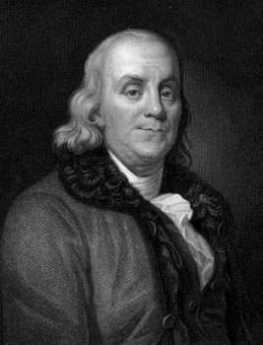
|
| Benjamin Franklin |
Except young Ben Franklin, who never went past second grade in school. The two became fast friends, often engaging in such games as constructing "Magic Squares" of numbers that added up to the same total in various ways. For example, Franklin doodled off a square with the numbers 52,61,4,13,20,29,36,45 (totaling 260) on the top horizontal row, and every vertical row beneath them totaling 260, as for example 52,14,53,11,55,9,50,16, while every horizontal row also totaled 260 as well. The four corner numbers, with the 4 middle numbers, also total 260. Logan constructed his share of similar games, which it is difficult to imagine anyone else in the colonies doing at the time.
Logan and Franklin together conceived the idea of a subscription library, which in time became the Library Company of Philadelphia in 1732. The subscription required of a library member was intended to be forfeited if the borrower failed to return a book. Later on, the public was allowed to borrow books, but only on deposit of enough money to replace the book if unreturned. We are not told whose idea was behind these arrangements, but they certainly sound like Franklin at work. More than a century later, the Philadelphia Free Library was organized under more trusting rules for borrowing which became possible as books became less expensive.
Logan died in 1751, the year Franklin at the age of 42 decided to retire from business -- and devote the remaining 42 years of his life to scholarly and public affairs. He first joined the Assembly at that time, so he and Logan were not forced into direct contention over politics, although they had their differences. How much influence Logan exerted over Franklin's plans and attitudes is not entirely clear; it must have been a great deal.
Quaker Gray Turns Quaker Green
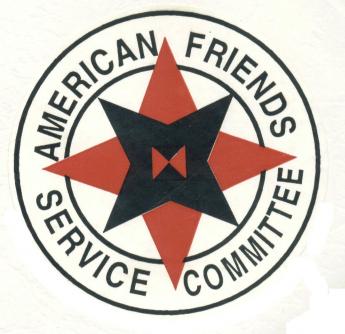
|
| American Friends Service Committee Logo |
Miriam Fisher Schaefer, at one time the Chief Financial Officer of the American Friends Service Committee, had to cope with the economics of renovating the business headquarters complex for various central Quaker organizations. They're housed in a red-brick building complex, naturally, located on North 15th Street right next to the Municipal Services Building of the Philadelphia City Hall complex. The original building within the complex is the Race Street Meetinghouse, funds for which were originally raised by Lucretia Mott. The Quakers needed to expand and renovate their offices, a nine million dollar project. Miriam, a CPA, calculated that the job could be made completely environment-friendly for an extra $3 million. The extra 25% construction cost explains why very few buildings are as energy-efficient as they easily could be. However, in the long run, a "green" building eventually proves to be considerably cheaper. Not only would a green Quaker headquarters be a highly visible "witness" to environmental improvement, but it would also pay for itself in reduced expenses after about eight years. That is, if friends of the environment would provide $3 million in after-tax contributions, they would provide a highly visible example to the world, and reduce the running expenses of the Quaker center by a quarter of a million a year, indefinitely. Effectively, this is a charitable donation with a permanent tax-free investment return of 12%, quite nicely within the Quaker tradition of doing well while doing good.
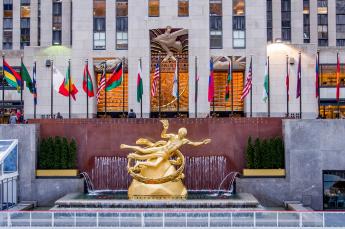
|
| Rockefeller Center |
Energy efficiency isn't one big thing, it is a lot of little things. If you dig a well deep enough, its water will have a temperature of 55 degrees, and only require heating up another 15 degrees to be comfortable in winter, or cooling down thirty degrees to be comfortable in the summer; that's described as a heat pump. Then, if you plant sedum, a hardy desert succulent plant, on the roof it will insulate the building, slow down rainwater runoff, and probably never have to be replaced. Rockefeller Center, you might be interested to learn, has a "green roof" of this sort, which has so far lasted seventy years without replacement. The Race Street Meetinghouse was built in 1854 and has so far had many roof replacements, each of which created a minor financial crisis when the need suddenly arose.
The ecology preservation movement is full of other great ideas for city buildings because buildings --through their heating, ventilating and air conditioning -- contribute more carbon pollution to the atmosphere than cars do. For another example, fifty percent of the contents of landfills originate in dumpsters taking construction trash away from building sites. What mainly stands in the way of more recycling of such trash is the extra expense of sorting out the ingredients. Catching rainwater runoff allows its reuse in toilets, eliminating the need to chlorinate it, meter it, and transport it from the rivers. And so forth; you can expect to hear about this sort of thing with great regularity now that the Quakers have got stirred up. You could save a lot of air conditioning cost by painting your roof white. At first, that would look funny. But do you suppose oddness would bother the Society of Friends for one instant? No, and you can expect them to make it popular, in time. People at first generally hate to look funny, but with the passage of time they grow to like looking intelligent.
A lot of people want to save the planet. So do the Quakers, but they have come to the view that the public is more easily persuaded to save money.
Unexpected Benefits of a Lurid Past
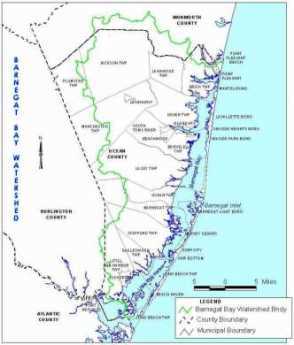 |
| Map of Barnegat Bay |
Centuries came and centuries went, while a Quaker shipyard went on about its business along the shore of Barnegat Bay. Next door there was a notable roadhouse after the second World War, rumored to have formerly been a secret speakeasy during the days of Prohibition. In time, the only occupant of the roadhouse was a wealthy widow, who mostly minded her own business and grew to be an affable neighbor to the Quakers next door. As rowdy days of Prohibition faded into the background of decades past, the old lady felt free to recall some of the less tawdry features of her past, to the Quakers who in turn felt free to chuckle about them. Ancient history, perhaps a little varnished and polished up. It was, however, a little disquieting to hear her say that the liquor for the speakeasy was often supplied by sailors from the Coast Guard, who routinely diverted 20% of the cargo of rum Runners they had captured, into commercial channels. Exciting times, those were.
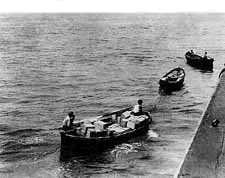 |
| The Coast Guard out looking for Rum Runners |
One day when the widow was ninety-six years old, the lights of her house stayed on, without other signs of activity. The neighbor eventually walked over to the back door and looked through the window, where it could be seen that the old lady was lying on the floor, rather motionless. He might have called the police, or broken into the house, but there was another option.
He went down to the basement, entering a rather dusty but quite elaborate barroom. Following old directions, he walked to a closet and climbed up a stepladder leading into another closet on the floor above. Stepping out, he found the lady was still breathing, called her relatives, and watched her be taken off to a nursing home to end her days. No one seemed to ask very many questions.
Quakerism and the Industrial Revolution
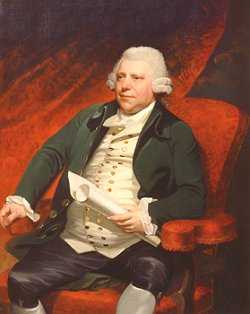
|
| Richard Arkwright |
The Industrial Revolution had a lot to do with manufacturing cotton cloth by religious dissenters in the neighborhood of Manchester, England in the Eighteenth Century. What needs more emphasis is the remarkable fact that Quakerism and the Industrial Revolution both originated about the same time, in about the same place. True, the industrializing transformation can be seen in England as early as 1650 and as late as 1880. The Industrial Revolution thus extended before Quakerism was even founded, as well as long after most Quakers had migrated to America. No Quaker names are much mentioned except perhaps for Barclay and Lloyd in banking and insurance, and Cadbury in candy. As far as local history in England's industrial midlands is concerned, the name mentioned most is Richard Arkwright, whose behavior, demeanor and beliefs were anything but Quaker.
He seems to have invented nothing, stealing the patents and ideas of others freely, while disgustingly boasting about his rise from rags to riches. Some would say his skill was in the organization, others would say he imposed an industrial dictatorship on a reluctant agricultural community. He grew rich by coercing orphans, convicts and others he obviously disdained into long, unpleasant, boring and unwelcome labor that largely benefited him, not them. In the course of his strivings, he probably forced Communism to be invented. It is no accident that Karl Marx wrote the Communist Manifesto while in Manchester visiting his friend Friedrich Engels, representing reasonably well the probable attitudes of Arkwright's employees. What Arkwright recognized and focused on was that enormous profits could flow from bringing piecework weaving into factories where machines could do most of the work. Until his time, clothing was mostly made by piecework at home, with middlemen bringing it all together. The trick was to make clothing cheaper by making a lot of it, and making a bigger profit from a lot of small profits. Since the main problem was that peasants intensely disliked indoor confinement around dangerous machines, the industrial revolution in the eyes of Arkwright and his ilk translated into devising ways to tame such semi-wild animals into submission. For their own good.
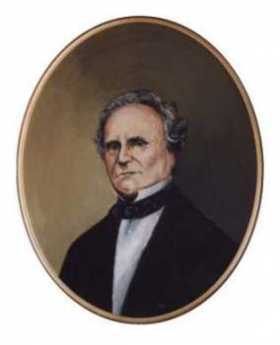
|
| Charles Babbage |
Distinctive among the numerous religious dissenters in the region, the Quakers taught that it was an enjoyable experience to sit indoors in quiet contemplation. Their children were taught to submit to it at an early age, and their elders frequently exclaimed that it was a blessing when everyone remained quiet, enjoying the silence. Out of the multitude of religious dissenters in the first half of the Seventeenth century, three main groups eventually emerged, the Quakers, the Presbyterians, and the Baptists. Only the Quakers taught that silence was productive and enjoyable; the Calvinist sects leaned toward the idea that sitting on hard English oak was good for the soul, training, and discipline was what kept 'em in line.
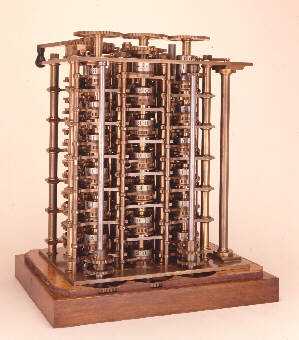
|
| babbagemaq.jpg |
The Quaker idea of fun through daydreaming was peculiarly suitable for the other important feature of the Industrial Revolution that Arkwright and his type were too money-centered to perceive. If workers in a factory were accustomed to sit for hours, thinking about their situation, someone among them was bound to imagine some small improvement to make life more bearable. If such a person was encouraged by example to stand up and announce his insight, eventually the better insights would be adopted for the benefit of all. Two centuries later, the Japanese would call this process one of continuous quality improvement from within the Virtuous Circle. In other cultures, academics now win professional esteem by discovering "win-win behavior", which displaces the zero-sum or win/lose route to success. The novel insight here was that it has become demonstrably possible to prosper without diminishing the prosperity of others. In addition, it was particularly fortunate that many Quaker inhabitants of the Manchester region happened to be watchmakers, or artisans of similar trades that easily evolved into the central facilitators of the new revolution -- becoming inventors, machine makers and engineers.
The power of this whole process was relentless, far from limited to cotton weaving. When Charles Babbage sufficiently contemplated the punched-cards carrying the simple instructions of the knitting machines, he made an intellectual leap to the underlying concept of the tabulating machine. Using what was later called IBM cards, he had the forerunner of the stored-program computer. There were plenty of Arkwrights getting rich in the meantime, and plenty of Marxists stirring up rebellion with the slogan that behind every great fortune is a great crime. But the quiet folk were steadily pushing ahead, relentlessly refining the industrial process through a belief in welcoming the suggestions of everyone.
Pennsylvania Prison Society
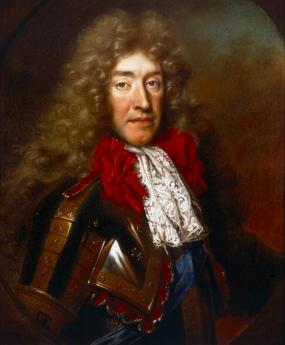
|
| Duke of York |
William Penn, who spent considerable time in British prisons, established a penal code for his new colony which largely swept away the draconian punishments established by the code of the Duke of York. Until as late as 1780, jails were mainly confinement hotels for debtors, prisoners awaiting trial, and witnesses. For actual punishment, the methods were execution and flogging. Penn's Code for Pennsylvania restricted execution to the crime of murder, and flogging to sexual offenses; everything else was punished by fines and imprisonment. Hidden in this code, of course, was the need to invent and construct prisons to service the imprisonment. It would take over a century to address this need, and Philadelphia still has not completely caught up with the need for more prison cells. Without a prison system, the Penn code was impractical, and the colonial penal code retrogressed toward floggings, pillories, and hangings after Penn's death.
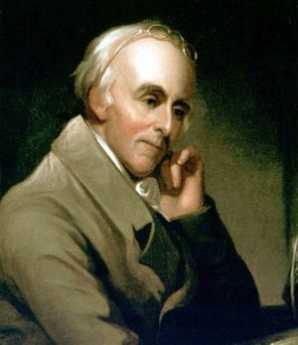
|
| Dr. Benjamin Rush |
In colonial Philadelphia, the main prison was on Walnut Street, with sixteen cells. A neighboring Quaker, Richard Wistar, started a soup kitchen in his own home, taking the soup over to prisoners. By 1773, he had established the Pennsylvania Society for Assisting Distressed Prisoners, which was unfortunately disbanded by the occupying British Army in 1777. In 1783, Dr. Benjamin Rush with the assistance of Benjamin Franklin, Bishop White, and the Vaux family, founded the Philadelphia Society for Alleviating the Miseries of Public Prisons, which after a century changed its name to the Pennsylvania Prison Society. The Prison Society believes it is the oldest continuous non-profit society in America.
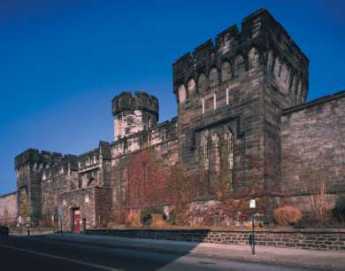
|
| Eastern State Penitentiary |
The Prison Society has had several major changes in direction. The original concept was to substitute public labor for imprisonment, a less costly arrangement than imprisonment while avoiding a return to floggings and dismemberment. However, the degrading sight of prisoners in chain gangs caused a public outcry, and the approach was abandoned. In the spirit of the French and American revolutions, loss of liberty was seen as the greatest punishment conceivable. Added to this was the Quaker concept of inspiring remorse through silent meditation, and the eventual outcome was the construction of the Eastern State Penitentiary on what was then called Cherry Hill. In 1823, it was ominous that Eastern State Penitentiary was the largest structure in America. Although the concept was widely admired and imitated, the prolix Charles Dickens took a violent dislike to the idea of never talking to anyone, and led a reversion away from penitentiaries back to simple prisons. In the days before Alzheimers and schizophrenia were well characterized, the spectacle of massive recidivism was added to the rumor that protracted solitude led to insanity.

|
| Catherine Wise |
From Catherine Wise the Communications Director of the Pennsylvania Prison Society, the Right Angle Club recently learned that the current evolution of the American penal system has led to a steady state, but a troubled one. There are 2.2 million inmates in American prisons today, more than any other nation including Russia and China. Of these, 75,000 are confined in Pennsylvania, 9,000 in Philadelphia. Recidivism is 67%, the cost is $31,000 per year per inmate, the majority of inmates have been involved with illicit drugs, a growing number are infected with HIV and Hepatitis C, mental illness runs around 20%. The cost of incarceration is growing faster than the cost of either education or healthcare for the community. Prison overcrowding is extremely serious, the programs for managing parole and integration back into society are weak and underfunded. Eighty percent of the inmates are non-white, most prisons are located in remote regions too far for easy visiting, medical care in prison would not seem at all acceptable in general society. The Prison Society has no difficulty finding projects which are urgently needed. Just for an example, take the peculiar prison statistics; it really seems improbable that only 9,000 of the 75,000 Pennsylvania prisoners are in Philadelphia. Then reflect, NIMBY, that no one wants a prison or its visitors near his home, except areas of rural poverty welcome the employment a prison brings. Reflect for a moment that "jails" are paid for by local county taxes and contain prisoners with less than two years to serve. "Prisons" are paid for with state taxes, and contain those sentenced to longer than two years. Finally, add the fact that nonvoting Philadelphia prisoners in rural prisons are counted by the census as residents of the rural area for the purpose of distributing legislative and congressional seats. The rural politicians love the system, the urban neighbors love to be rid of the prison environment, but the prisoner families can't visit the prisoner. Who cares? Who even notices?
During the first World War, Quaker interest in prison matters was greatly stimulated by the imprisonment of many Quaker conscientious objectors to the wartime draft; since that time prison conditions have again become a central interest of the religion. It's hard to prove but is confidently asserted, that violence and mistreatment of prisoners are appreciably less in Pennsylvania than the rest of the country, California for example. In any event, The Pennsylvania Prison Society is a particularly effective advocate for humane treatment because of credibility achieved over two centuries, with newspaper editors on its board, and sympathetic affiliations with the legislative judicial committees. It knows what it is talking about, as a result of over 5000 annual prison visitations, and it has served the prison administrative corps by performing volunteer work, accepting contracts for parole projects, arranging bus trips for prisoner families to remote prisons, and working for improved funding for prisons. At the moment, there are six highly imaginative bills before the Pennsylvania Legislature, devised and researched by this outside organization with credibility, and political clout. Although the Society takes an occasional contract for a project, it is itself entirely funded by outside contributions, and because of occasional adversarial situations, asks for no funds from the state. Even the contract funds have been questioned, and are only accepted when the working relationships fostered are more useful for the prisoner clients than any co-option which might result.
One final word about medical care in prison. It's not as good as medical care for non-prisoners, and unfortunately it probably never can be. The remote rural location of prisons makes it difficult to obtain physicians and nurses, regardless of wage levels. It's dangerous to be around prisoners, as any guard will tell you, and it's more dangerous to be in control of narcotics amidst a population of addicted convicts. Malingering is nearly universal, both to obtain desired drugs and to spend "easy time" in the infirmary. Many prison escapes are engineered around the necessarily weakened security of the medical system. The prison budgeting system has all the rigidity and weaknesses of any governmental medical system, and in this case, it's run far out of sight of the public. Even the bureaucrats in charge are victimized by other bureaucrats. The average duration of incarceration in Pennsylvania is longer than in most other states; the prisons have to keep mental patients because the mental hospitals have all been closed. Fifty years ago, when there was no place to put a non-criminal with tuberculosis, he was put in jail. The parole system is underfunded, there is not nearly enough community support to absorb ex-con. Behind all this is a shortage of prison facilities. The legislature has got itself into a position that if it moved more prisoners into the outside, more prisoners would just fill the vacancies, costs would go up, and things wouldn't look much better. Only after the backlogs have been absorbed, would there be much visible effect.
Fernery
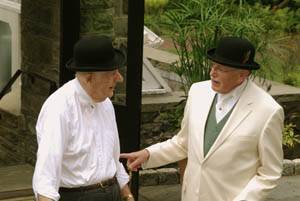
|
| Gardeners |
As explained by the curator of The Morris Arboretum, there are a few other ferneries in the world, but the Morris has the only Victorian fernery still in existence in North America. That doesn't count a few shops that sell ferns and call themselves ferneries; we're talking about the rich man's expensive hobby of collecting rare examples of the fern family in an elaborate structure. That's called a Victorian fernery. The one we have in our neighborhood is really pretty interesting; worth a trip to Chestnut Hill to see it.
Although our fernery was first built by the siblings John and Lydia Morris, it was rebuilt at truly substantial cost by the philanthropist Dorrance Hamilton. It is partly above ground as a sort of greenhouse, and partly below ground, with goldfish and bridges over its pond. Maintaining an even temperature is accomplished by a complicated arrangement of heating pipes. The temperature the gardener chooses affects both the heating bill and the species of fern that will thrive there. You could go for 90 degrees, but practical considerations led to the choice of 58 degrees. The prevailing humidity will affect whether the fern reproduction is sexual or asexual, a source of great excitement in 1840, but survivors of Haight-Asbury are often more complacent on the humidity point.
There are little ferns, big ferns, tree ferns, green ferns, and not-so-green ferns; the known extent of ferns runs to around five hundred species. Not all of them can be found in Chestnut Hill, what with humidity and all, but there are enough to make a very attractive and interesting display. For botanists, this is a must-see exhibit. For the rest of us, it's probably the only one of its kind we will ever see, a jewel in Philadelphia's crown, and shame on you if you pass it by.
Quaker Efficiency Expert: Frederick Winslow Taylor 1856-1915

|
| F.W. Taylor |
For at least seventy-five years after Fred Taylor turned it down, any rich smart Philadelphia Quaker attending Phillips Exeter would have been automatically admitted to Harvard. We don't know why he did it, but instead F.W. Taylor just walked a few blocks down the hill from his Germantown house and got a job at the Midvale Steel Company as an apprentice patternmaker. During the twelve years, while he rose to become chief engineer of the company, he took a correspondence course for a degree in mechanical engineering at Stevens Institute and invented a process for making tungsten steel, called high-speed steel. That made Midvale Steel rich, but Taylor was going to make Philadelphia rich, and after that, he was going to make America rich. When he died, he was widely hated.
Evidently his lawyer father greatly admired German efficiency, having sent little Freddy to a famous Prussian boarding school where he was in attendance at the time of the
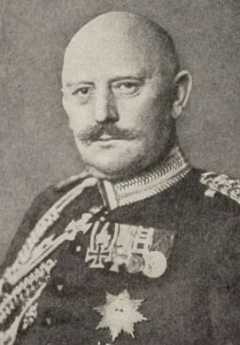
|
| General von Moltke |
Battle of Sedan. General von Moltke had used Prussian efficiency and discipline to defeat those indolent lazy French, and Fred Taylor evidently absorbed and retained these stereotypes for the rest of his life. Whatever he was looking for at Midvale Steel, what shocked him most was to find workers "soldiering on the job". That's a Navy term, by the way, invented by sailors to describe the useless shipboard indolence of any Army they were transporting. Taylor later went to Bethlehem steel, reduced the number of yard workers from 500 to 180, and was promptly fired. It seems that most of the foremen at the plant were owners of local rental houses, which were emptied of tenants when Taylor reduced the workforce. Even management came to mistrust Taylor. When the railroads wanted a rate increase, Louis Brandeis defeated them with the argument that they wouldn't need higher rates if they adopted Taylor's system of efficiency. In his later years after he became enormously rich, he toured the country giving speeches without fees, promoting the doctrine of finding the one best way and then doing everything that way.
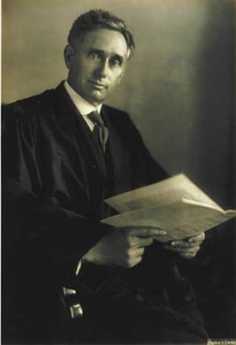
|
| Louis Brandeis |
Over time, Frederick Taylor had come to see that the industrial revolution had proceeded to the factory stage by merely bringing craftsmen indoors, each one treasuring his little trade secrets. Bringing the point of view of the company's owners onto the shop floor, Taylor could see how vastly more profitable the steel company would be if all those malingering tradesmen would stop soldiering on the job. No doubt the young Quaker soon learned that little was to be accomplished by remonstrating with workers, just as bellowing foremen had learned that bullying was also useless. Out of all this familiar scene emerged Taylorism, the idea of paying financial incentives to those who produced more, splitting the rewards of efficiency with the management. It sort of worked, but it didn't work enough to satisfy F.W. Taylor. When he walked around with a stopwatch, he collected the data showing how much more might be produced if the workers were perfectly efficient. Not only did that create the stereotype of the stop-watch efficiency expert, but it also provoked Congressional hearings and federal law against stopwatches which stayed on the books from 1912 to 1949. Although management responded by forming dozens of Taylor Societies to honor the approach, the unions invented the term "Taylorism" and bandied it about as the worst sort of epithet. Curiously, the Taylor approach proved to be enormously appealing both to Lenin and Stalin, who applied it as a central part of their five-year plans and general approach to industrialization. As we now all recognize, the Communist approach was a two-tier system instead of the three-tier system that was needed. It isn't enough to have a class of comrades called planners and another called workers; you need a layer of foremen, sergeants and chief petty officers in the middle. In addition to the elaborate time and motion studies leading to detailed written procedures, there needs to be an institutional memory for the required skills of the trade. In a funny sort of way, Fred Taylor the Quaker may have organized the downfall of the communist state before it was invented.

|
| Herbert Hoover |
Another peculiar outgrowth of Taylorism may be the partisan lines of our own political parties. If you trace the American ideological divide to the 1932 election of Franklin Roosevelt, you can see we are still fighting the battles of the depression. It happens that Herbert Hoover, another Quaker, was totally captivated by Taylorism. Not only that, he was adamant that to get rid of the depression all the country needed was to return to self-reliance, individual responsibility, and hard work. Those were qualities Hoover himself had in superabundance. One telling remark that he probably regretted saying but nonetheless firmly believed was, "If a man hasn't made a million dollars by the time he is forty, he can't amount to much." Franklin Roosevelt had the million all right, but his family had given it to him. The Cadburys and Clarks could have given it to Fred Taylor, too, but he chose to make it himself.
www.Philadelphia-Reflections.com/blog/1296.htm
Gardening Survives
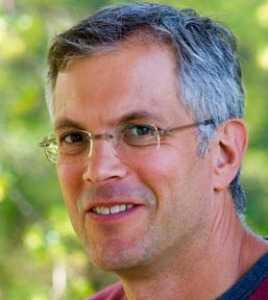
Adam Levine, the author of a new book about the Philadelphia public garden scene was recently the featured guest speaker at the Franklin Inn. He's a charming person, and has given us a great book.
He draws to our attention that the Philadelphia region is pre-eminent in the garden world, and has been so for several centuries. While it is true that Philadelphia has a mild enough climate to be suitable to two climate zones, the early settlers came from a region of middle England that has been a garden center since Roman times. And they were Quakers, uncomfortable with the outward show in buildings and furnishings, but flowers were innocent instruments of the display. Although Chanticleer was created by a Pennsylvania German family, the great centers of public gardens are mostly traceable to the influence of Quakers, and the du Pont family. Since one or two years of neglect will ruin almost any garden, the essence of great gardens lies in the ability to survive.

|
| The Horticultural Society |
In fact, the Philadelphia area contains hundreds of gardens which have decayed and virtually disappeared. The Horticultural Society is at the heart of garden preservation, financed in large part by the annual flower show, but even that thriving organization is hard pressed to do justice to the vast areas that need tending. Woodlands would be an example of an area needing tending, and Friends Hospital is an object lesson. When that venerable institution was sold to sharp pencil types from out of town, the Azalea gardens on the grounds were closed to visitors, except for two hours a year. It makes you tremble to imagine how long this famous azalea collection will probably survive. Meanwhile, Germantown's famous gardens are maintained in a minimal way, stretching the resources of the owners who have more urgent demands to meet in their buildings and furniture. Indeed, it is hard to name a really outstanding garden within the city limits, with the exception of the Morris Arboretum, which barely makes it within city boundaries. The area back of the Art Museum along Boathouse Row makes a brave attempt in the spring, but it's a pale reminder of the glory which used to be seen in East Fairmount Park, especially at Lemon Hill, Stenton, and Cliveden. Stotesbury is just a relic.
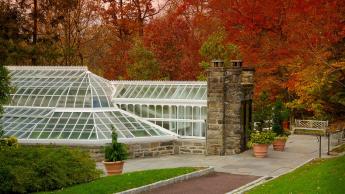
|
| Morris Arboretum |
Gardens have moved to the suburbs. Chanticleer, the Morris Arboretum, Longwood Gardens, Nemours, the Scott Arboretum at Swarthmore, West Laurel Hill, The University of Delaware in Newark, Cabrini College in Villanova, Haverford College Arboretum, Temple University's Ambler campus, and the Trenton Sculpture Gardens on the old fairgrounds -- all would demand mention in any list of outstanding gardens in America. But only a few of them aspire to the standards of an outdoor sculpture garden, where the goal was to surround each piece of sculpture with a garden in such a way that only one sculpture could be seen at a time. Now, that was gardening on the grand scale.
Hidden in a regional garden scene is the seed merchants, starting with John Bartram and famous under the Burpees, which make gardens possible. After all, there has to be a place to find these things. Perhaps the catalog stores, like Wayside Gardens, are the hope for the future. Every shrub or tree transported from a nursery takes up a ball of topsoil along with the specimen, and the appearance of nurseries around the periphery of a city is usually the first step in the development of housing projects. If there is an investment of topsoil in every garden, perhaps we ought to think a little bit about the way we let the investment dry up and blow away.
REFERENCES
| Gardens of Philadelphia and the Delaware Valley William Klein Jr. ISBN-10: 1566393132 | Amazon |
July 4, 1776: Patients in the Pennsylvania Hospital on Independence Day
According to the records of the Pennsylvania Hospital, the following 48 persons were patients in the hospital on July 4, 1776:
| Richard Brinkinshire (Admitted 11/15/1775) | John Ridgeway (Admitted 12/26/1775) |
| James Chartier (Admitted 1/6/1776) | patient (Admitted 1/6/1776) |
| patient (Admitted 1/20/1776) | patient (Admitted 1/20/1776) |
| Mary Yell (Admitted 2/7/1776l) | John Beckworth (Admitted 2/7/1776) |
| Bart. McCarty (Admitted 2/10/1776) | John King (Admitted 2/10/1776) |
| Robert Alden (Admitted 2/17/1776) | William Patterson (Admitted 3/6/1776) |
| Elizabeth Hanna (Admitted 3/9/1776) | John McMahon (Admitted 3/13/1776) |
| Mary Burgess (Admitted 3/23/1776) | Mary Anderson (Admitted 4/10/1776) |
| John Hatfield (Admitted 4/15/1776) | Eliza Haighn (Admitted 4/17/1776) |
| Charles Whitford (Admitted 4/24/1776) | patient (Admitted 5/8/1776) |
| Susanna Carrington (Admitted 5/8/1776) | patient (Admitted 5/8/1776) |
| William Johnson (Admitted 5/13/1776) | Lazarus Chesterfield (Admitted 5/22/1776) |
| Mary Spieckel (Admitted 5/22/1776l) | William Edwards (Admitted 5/22/1776) |
| patient (Admitted 5/23/1776, Lunatic) | Jane White (Admitted 5/25/1776) |
| Charles McGillop (Admitted 5/29/1776) | ---Fitzgerald (Admitted 6/1/1776) |
| Michael Rowe (Admitted 6/6/1776) | patient (Admitted 6/6/1776) |
| John Hughes (Admitted 6/12/1776) | Joseph Smith (Admitted 6/15/1776) |
| Esther Munro Lunda (Admitted 6/15/1776) | Mathew Coope (Admitted 6/19/1776) |
| Anne Patterson (Admitted 6/19/1776) | Thomas Savoury (Admitted 6/20/1776) |
| Rebecca Winter (Admitted 6/26/1776) | Elizabeth Manning (Admitted 6/26/1776) |
| Negro (Admitted 6/24/1776) | Elex. Scanvay (Admitted 6/24/1776) |
| Fanny Stewart (Admitted 6/24/1776) | Peter Barber (Admitted 6/29/1776) |
| Catherine Campbell (Admitted 6/29/1776) | Ann McGlauklin (Admitted 7/3/1776) |
| Elizabeth Lindsay (Admitted 7/3/1776) | Ann Jones (Admitted 7/3/1776) |
The records indicate the following diseases were the reason for admission of those patients. Although in Colonial times there was no medical delicacy to avoid offending readers, present privacy standards require that we strip the diagnoses from the name of the patient and list them independently. There is some overlap, sometimes making it difficult to judge which disorder caused the admission.
- Sore, poisoned or ulcerated legs: 16 cases
- Lunacy, mind or head disorders: 10 cases
- Syphilis: 7 cases
- Fever and Rheumatic fever: 7 cases
- Dropsy: 5 cases
- Gunshot: 4 cases
- Diabetes: 1
- Blindness with clear pupil: 1
- Spitting blood: 1 case
- Dislocated arm: 1 case
- Inflammation of face: 1 case
- Scurvy: 1 case
- broken arm: 1 case
The following physicians were elected at the Managers Meeting dated 5/13/1776:
- Dr. Thomas Bond
- Dr. Thomas Cadwalader
- Dr. John Redman
- Dr. William Shippen
- Dr. Adam Kuhn
- Dr. John Morgan
Nation's First Hospital, 1751-2016
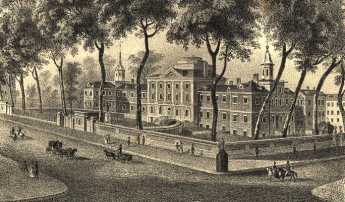
|
| Pennsylvania Hospital |
As commonly stated in medical history circles, the history of the Pennsylvania Hospital is the history of American medicine. The beautiful old original building, with additions attached, still stands where it did in 1755, a great credit to Samuel Rhoads the builder and designer of it. The colonial building on Pine Street stopped housing 150 patients around 1980, supposedly at the demand of the Fire Marshall, although its perpetual fire insurance policy still owes the hospital several thousand dollars a year as an unspent premium dividend. There may have been one small fire during two centuries of use, but its true fire hazard would be difficult to assert. It was just out of date. The original patient areas consisted of long open wards, with forty or so beds lined up behind fluted columns, in four sections on two floors. The pharmacy was on the first floor, the lunatics in the basement, and the operating rooms on the third floor under a domed skylight. It was entirely serviceable in 1948 when I arrived as an intern doctor. Individual privacy was limited to what a curtain between the beds would provide, but on the other hand, it was possible for one nurse to stand at the end of the award and recognize any distress among forty patients immediately. In this trade-off between delicacy and utility, the utility was certain to be preferred by the Quaker founders. Visitors were essentially excluded, and if a patient recovered enough to be unnaturally curious about neighboring patients, well, he had probably recovered enough to go home.
Located between two large rivers, South Philadelphia up to ten blocks away was essentially a swamp until the Civil War. So, there were seasonal epidemics of malaria, yellow fever, typhoid, and poliomyelitis at the hospital until the early twentieth century. Philadelphia was a port city, so sailors brought in cases of venereal disease, scurvy, even an occasional case of anthrax or leprosy. During the Industrial Revolution of the nineteenth century, tuberculosis, rheumatic fever, and diphtheria were part of clinical practice. But underlying the ebb and flow of environmental effects, there was a steady population of illness which did not change a great deal from 1776 to 1948. These patients were all poor, because the rules in Benjamin Franklin's handwriting restricted service to the "sick poor, and only if there is room, for those who can pay." In 1948 there was a poor box for those who might feel grateful, but no credit manager or official payment office. The matter had been considered, but the cost of collection was considered greater than the likely revenue. When Mr. Daniel Gill was offered the position as the hospital's first credit manager, it was suggested that he be given a tenth of what he collected. To his lifelong regret, Dan Gill regretted that he refused an offer that he had felt he could not afford to accept.
So, the wards were filled with victims of the diseases of poverty, punctuated by occasional epidemics of whatever was prevalent. And a second constant feature of the patients was their medical condition forced them to be housed in bed. For centuries, physicians dreaded the news that a new patient was being admitted with "dead legs".
Volunteerism Needs a Business Plan
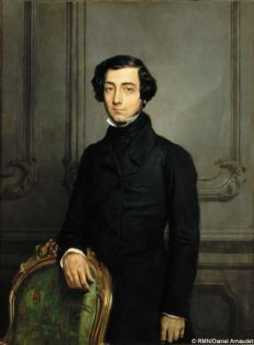
|
| Alexis de Tocqueville |
The visiting Frenchman Alexis de Tocqueville was struck most by the volunteerism he found everywhere in the young American nation; in his view, the first reaction of 19th Century Americans to a problem was to create a volunteer organization to fix it. Benjamin Franklin, who created dozens of such initiatives, was held up as its great exemplar. But de Tocqueville visited us at the beginning of the Industrial Revolution, and we are now well past that into the Information Revolution; volunteerism has noticeably declined. Not only have the great volunteer organizations like the Masons and the Red Cross suffered, but it is far more difficult to enlist the help of others to form a pick-up group to attack some issue or other. It is in that sense the general spirit of volunteerism has declined. The likely difficulty is not selfishness, but the helplessness of people to control their own time.
When volunteer groups to assemble, they are mostly composed of self-employed people like plumbers and dentists, free to be somewhere else during "normal business hours", which although shorter than they once were, seem extended by commuting time and by chores pushed aside during workplace confinement. To some extent longer commuting distances make it physically impossible to do personal chores in the vicinity of the workplace. But constrained personal time is also related to increased control behavior by management. A successful big business has to employ strategies to get employees with cell phones to stick strictly to business while the employer is paying for their time. Now that so many women are going out to work, the family unit needs to struggle to coordinate everyone's work time so there will be some remaining opportunity to conduct family life. When a working couple shares the home tasks and babysitting, the preempted time now extends to two working partners, and what is left is called "quality time". A probably temporary elaboration of this time competition is the need to chauffeur teenagers to their resume-enhancing activities. For the time being, you don't pick a college, the college picks you, and parents desperately labor to assist their children on a career path. Quite obviously, America needs to evolve better ways of trading work at home for more flexibility in the actual workplace, and we also need to build more first-rate colleges, but those issues are not the present topic. To summarize: It's awfully hard to assemble a group of volunteers simultaneously because employers have so successfully assembled their time. Failing to appreciate the tradeoffs inherent in commuting time is a secondary but still important factor, somehow related to the recent housing/schools mania.
Consequently, volunteer organizations increasingly tend to regard their chores as something you hire someone else to do if it proves impossible to dump them on someone who is retired or unemployed, or too timid to refuse. Even nominal volunteers are reluctant to step forward. This leads to recruitment lectures along the line that naturally you must sacrifice if you really truly believe in the goals of the dear old Whatsis Association, surely just a coercive speech pattern. That claptrap was never heard during the age of universal volunteers; volunteering was just one of those things everyone expected to do to get community activities accomplished. We're losing something important if we continue to endorse this attitude. Sometime during the first twenty-four hours in military service, for example, someone will surely advise the new recruit -- never volunteer.
For a penniless non-profit to adopt the solution of hiring staff when there is no revenue stream to pay them, is the first step toward the dissolution of the organization. Essentially, the non-volunteers are ordered to contribute money if they choose to be draft-evaders, and eventually, the officers and staff begin to look back at the organization members as cows to be milked. A class of people who are only making a living is substituted for those who understand and promote the goals, and it just goes downhill from there.
Instead, all volunteers really must each do some unpaid work, and the officers and directors must set an example of it. What an organization does next is crucial. Individual members, either anonymous or hoping to remain anonymous, must be approached with the suggestion they accept responsibility for a task. The wild-eyed response to this approach is quite familiar, like the lame excuse that there is no time. A counter response that I'm busier than you are, does not improve the conversation because it suggests the refuser is merely a selfish shirker. Instead, initial requests must take the following form: They should be for a simple, limited task without any obligations stretching to infinity. Almost everyone will be glad to bake a cake for a party, but almost no one will agree to be chairman of the cake-baking department unless the boundaries of that commitment are more reliably limited than they usually are.
In modern times, any major undefined volunteer responsibility is seen as potentially leading to an unthinkable conflict with gainful employment or else its ill-considered outgrowths like commuting. Since that's the basic problem, all-volunteer invitations must respect the true issue and devise workable ways to circumvent it. Role models certainly help if you have any.
www.Philadelphia-Reflections.com/blog/1448.htm
Line Dividing East from West Jersey
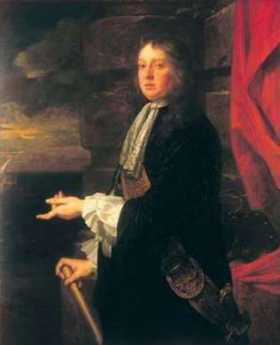
|
| William Penn |
At this point William Penn entered the picture as one of three Quaker trustees for Byllinge, who had gambling debts. A tenth of this share was given to John Fenwick, the 1675 settler of Salem, to settle his part of the disputes with Byllinge; the rest of it constituted what was to become the oldest American stockholder corporation, The Proprietors of West Jersey. The arrangement up to this point was firmly settled for the southern half of New Jersey by a Quintipartite Deed of July 12, 1676, , signed by the three Quaker trustees plus Byllinge and Fenwick. Aside from establishing the Proprietorship, the main point of this deed was the separation of West Jersey from East Jersey (the Carteret part) by a North-South line which still persists as the upper border of Burlington County. The right to govern this land was fully restored in 1680 by a Confirmatory Grant from James, probably after considerable lobbying in London by William Penn.
Presumably in pursuit of this final confirmation, Penn had negotiated a hundred-page agreement with prospective settlers which outlined his plans for governing, called the Concessions and Agreements of March 14, 1677, . Although its original purpose was mainly a real estate marketing tool, this landmark document seems not only to have persuaded the Duke of York but so shaped the thinking of the English colonies that many of its features are readily recognized in the American Constitution of 1787.
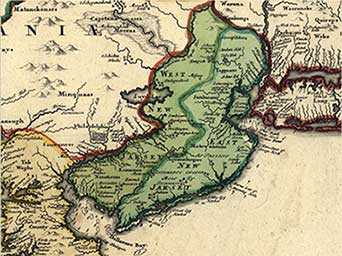
|
| The line dividing West and East NJ |
The land mass between the North and South Rivers (Hudson and Delaware) only came completely and legally into the hands of Quakers in 1681. At that time Carteret's widow, Lady Elizabeth, sold the northern half (East Jersey) to twelve Quaker proprietors, while the southern half (West Jersey) was already held by thirty-two other Quaker proprietors under the effective leadership of William Penn. It is somewhat uncertain who orchestrated this final consolidation, but there is a strong presumption that it was Penn. Since the main purpose of these business proprietorships was to sell land to immigrants, it was vital to minimize land disputes with accurate records and accurate surveying. With a history behind them of fifteen years of bickering, everybody concerned was surely ready for some peaceful organization. Both groups of proprietors, East and West, found it useful to delegate authority to a council of nine executive proprietors, whose main agent under the circumstances was logically the Surveyor General. For the next three hundred years, the surveyor generals were the men running things in New Jersey. The right of the Proprietors to govern was revoked by Queen Anne in 1702, but their land rights remain undisturbed to the present day, notwithstanding the intervening transfer of national power to the United States of America in 1776-83. Underneath all of this hustling and arranging, with exquisite attention to details, seems to be found the hand of William Penn. Almost immediately after New Jersey was packaged and delivered, King Charles paid off his family debt by turning over the far larger combined land mass of Pennsylvania and Delaware to William Penn, urging him to make himself a vassal king in the process. The Quaker instantly declined such a thing, but the power continues to reside in the final Royal Charter. It's only a conjecture, but it might help explain the strange acquaintance between a dissolute king and an abstemious Quaker to notice that the New Jersey tour de force astoundingly demonstrates how Penn was a man who really could be trusted to get complicated things done with dispatch.
Today, for practical purposes it all amounts to a company named Taylor, Wiseman, and Taylor; but we are getting a little ahead of ourselves. To go back to 1684 a surveyed line was clearly needed between the two proprietorships, as declared by the following resolution:
"Award we do hereby declare, that [the line] shall run from ye north side of ye mouth or Inlet of ye beach of little Egg Harbor north northwest and fifty minutes more westerly according to natural position and not according to ye magnet whose variation is nine degrees westward."
To clarify those quaint words, the survey was not to make the mistake made in the layout of Philadelphia, whose streets had intended to be true north and south but by using Magnetic North are actually twelve degrees off from that. Another important point is probably unclear to modern readers, who know the town of Egg Harbor on the mainland of Barnegat Bay but are largely unaware that the "beach of Egg Harbor" was what we now call Long Beach Island, on the east side of Barnegat Bay. The southern anchor of The Line was in what we now call Beach Haven, on the north side of the inlet, although beach erosion has put the southern anchor about two miles out to sea, locating a temporary marker in Beach Haven. Hardly anyone seems to be aware of it, but reread the sentence and observe the meaning is actually quite clear. The intent of the northern end of The Line (? the Delaware Water Gap ?) is buried in the obscurity of compass markings, but comes out slightly above Trenton on the Delaware River, extending beyond the river into Pennsylvania until it reached the river again in a crook on the far side of the Delaware Water Gap. Word of mouth has it that William Penn wanted to have both sides of the river although this triangle of Pennsylvania was eventually surrendered. It seems fair to say, the line was roughly intended to run from the Beach Haven ocean inlet to the Delaware Water Gap.
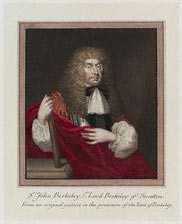
|
| John, Lord Berkeley |
For its time, the survey of The Line was also a significant engineering achievement. The general plan was to lay out the course of the line in the wilderness until it hit a big boulder or anything else that was large and heavy. This became a marker along a line of 150 markers which could be used for local surveys and boundaries. After several less accurate attempts, the West/East line was surveyed by John Lawrence in 1743 and stands as the Official Province Division Line. A few years ago, a group of volunteers tried to locate all of the original markers and found 55 of them. The historical project took ten years.
All of the deeds of property in the State of New Jersey still depend on the original survey and the meticulous notes kept by the Surveyors General of these two Quaker organizations, without whose private records every title to every property would be clouded. With the passage of time, and especially the warfare of the Revolution, other copies of the surveys have disappeared. So, without the need to get ugly about it, these soft-spoken courteous folks retain a form of power it would be hard to match with sticks and stones, guns, threats or legalisms -- the only surviving record of everyone's title to his land. There is little reason to inquire further why these Proprietorships durably survived the revolution which overthrew King George III, and why no one has seen fit to enter the serious challenge to their claim of owning the whole state except for what they had already specifically sold.
Let's go back to a point made earlier. In all the complexities of the English Royal Court and uncertainties of uncharted wilderness, how did a little band of Quakers find themselves with uncontested ownership of a whole American colony? Some of the chaos of the age probably helped. King Charles unleashed his brother's armies in 1664. Also in 1664, Parliament passed the Second Conventicle Act, which provided that not more than five persons were permitted to worship together otherwise than according to the established ritual of the Anglican Church of England. This act might be described as an improvement on the First Conventicle Act of Queen Elizabeth, which provided that no one at all could so worship. However, this prohibition was so extreme it was ignored, whereas the Second Conventicle probably had some popular support. It thus can be imagined why Quakers were suddenly interested in leaving England, and not hard to understand how young William Penn was propelled into leadership by successfully overturning that Act in the Haymarket Case. Penn was both the defendant in the case and the defense lawyer, inventing the common law principle of jury nullification that has so confounded tyranny ever since. To go on with events current at the time, the Great Plague took place in 1665, making London an undesirable place for anybody to live. And finally, George Fox, the founder of Quakerism, took a journey to the new world in 1672, noting that the place now called Burlington, New Jersey was "a bravest country". Taken altogether, it is not hard to suspect this group of fairly wealthy, fairly well-educated people developed a collective resolve to buy up the pieces, assemble the parcel, and go away to live on it. Their organization into monthly local meetings, quarterly regional meetings, and annual national meetings was surely great assistance. From what we know of the broader vision of William Penn, it is fair to speculate his enthusiasm for this communications network first suggested by George Fox, or at least he's having a pretty quick recognition how it would assist the emigration venture.
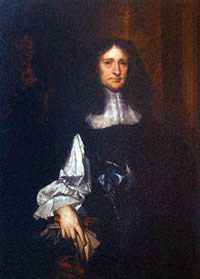
|
| George Carteret |
George Carteret's widow was the last to sell out her land parcel to the East Jersey Proprietors, presumably drawn from the 1400 immigrants who had arrived in Burlington on five or six ships between 1678 and 1681. In particular, the ship Kent sailed from the Thames in 1677, bearing 230 Quakers, half from Yorkshire, the other half from London settling further south in West Jersey. Before that, Lord Berkeley had sold his half for a thousand pounds to John Fenwick and Edward Billynge, who arrived in Salem on the ship Griffin in 1674. These two soon fell out, with Fenwick taking a tenth of the land and settling around Salem. Billynge got into unspecified difficulties, probably gambling, and turned his property over to his three main creditors, William Penn, Gawen Lawrie, and Nicholas Lucas, who assembled the Proprietorship of West Jersey. Penn's remarkable talent for leadership again emerged in his statement of "Concessions and Agreements" with the Indians and new inhabitants. In another place, we discuss the reasons for thinking this document created the effective basis of the U.S. Constitution. By infusing it with the unspoken word of compromise, Penn created the main model explaining why the ratification of the Constitution remains the only time in history when thirteen independent nations voluntarily gave up sovereignty for the purpose of creating a larger vision -- which then held together for two centuries. But the voluntary union of East and West Jersey certainly has a claim to being earlier, although its claim to sovereignty is weaker.
Perhaps so, but since their interest in power was weaker, their achievement in peaceful negotiation with a secretly Catholic King was surely much greater. If some small group of religious dissidents should today emerge as having quietly and systematically bought up an entire state, however legally, the word conspiracy would be on every tongue. In this case, however, the reaction was peaceful consensus.
Concessions and Agreements
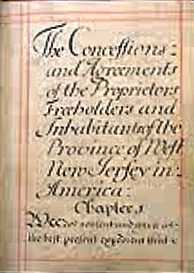
|
| Concessions and Agreements |
The United States Constitution is a unique achievement, but it had significant precursors, many of which James Madison had studied at Princeton. In the days of difficult ocean travel, almost all colonies were bound by an agreement to maintain loyalty to their European owners in spite of receiving latitude to govern themselves. Charters and documents defining these roles were generally written by the owners, and the colonists could pretty much take them or leave them. In the case of New Jersey in 1664, however, a very formidable lawyer and friend of the King named William Penn was drawing up agreements to his own conditions of sale, taking care that the grant of governing authority he received was favorable. Penn's relationship to the King was unusually good, to say the least. He had more reason to be wary of nit-pickers in the King's administration, trying to anticipate every conceivable disappointment for some successor King.
For his part, Penn wanted to make colonial land attractive to re-sell to religious groups who had experienced harsh government oppression; he wanted no obstacles to his announcing there would be no religious oppression in New Jersey. He was offered the role of sub-king although he hastily rejected any such title, and needed to repeat the formalities of the Charter to define his role and reassure his settlers about that matter. Furthermore, he was dealing with the heirs of Carteret and Berkeley, active participants in North and South Carolina. So Penn's method of achieving basic rights was influenced by prior thinking in the Carolinas, as the thinking of John Locke secondarily influenced matters in Delaware and Pennsylvania. These ideas were incorporated in a New Jersey document called "Concessions and Agreements." The concepts were not wholly the ideas of William Penn, but he did write it, and it does contain many ideas that were uniquely his. Understandings about limits were set down, argued about, and agreed to. The owner risked money, the colonist risked his life. Neither would agree unless a reasonable bargain was struck in advance of any dispute. Furthermore, the main value of a colony was beginning to shift from trading rights to real estate rights. Carteret and Berkeley had not only been principals in both the Carolinas and the Jerseys but had been involved in a number of such investments in Africa and the West Indies; New Jersey was just another business deal. It was conventional for documents of this type to define the method of selection of a governor, the establishment of an assembly of colonists, and some sort of council to attend to day to day affairs. In that era, few colonists would cross the ocean without a guarantee of religious freedom, at least for their own brand of religion. Standard clauses which may sound strange in today's real estate world, were then necessary because it was a transfer of not merely land, but also the terms of government. In the case of the Quaker colonies, many of these stipulations were included in the earlier charter from the King. It seems very likely that Penn hovered around and negotiated these points which he wished to have the King agree to; and then once the land was safely his, Penn repeated and expanded these stipulations with the colonists in his Concessions and Agreements . It wasn't exactly a Constitution, but it reads a lot like the one America adopted a century later.
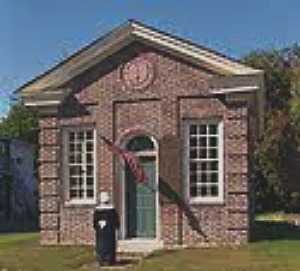
|
| Proprietors House |
Quakers had suffered persecution and imprisonment, and knew exactly what they feared; on the other side, it seems likely Carteret and Berkeley were less interested. So this real estate transfer document conceded almost anything the colonists wanted and the King would stand for, couched in conciliatory phrases. For example, no settler was to be molested for his conscience, and liberty was to be for all time, and for all men and Christians. Elections, by the way, must be annual, and by secret ballot. While law and order must prevail, nevertheless no man is to be imprisoned or molested except by the agreement of twelve men of the neighborhood. On the matter of slavery, no man was to be brought to the colony in bondage, save by his own consent (that is, indentured servants were to be permitted). And in what proved to be a final irony for William Penn, there was to be no imprisonment for debt. Almost all of these innovative ideas survived into the U.S. Constitution a century later, but the most innovative idea of all was to set them all down in a freely-made agreement in writing. This was not merely how a government was organized, it defined the set of conditions under which both sides agreed it would operate.
It was, of course, more than that. It was a set of reassurances to settlers who had been in New Jersey before the English arrived that they, also, would be treated as equals. It was a real estate advertisement to the fearful religious dissenters back in England that it was safe to live here. And it was a reminder to future Kings and Parliaments that this is what they had promised.
The pity and a warning, is that the larger vision of a whole continent governed fairly by common consent may have been too grandiose for a little band of New Jersey Quakers, surrounded as they were by an uncomprehending world. All utopias are helpless when stronger neighbors reject the basic premise. However, it was the expansion of the pacifist concept to the much larger neighboring territory of Pennsylvania that proved to be just too much for such a small group of friends to manage by consensus, particularly when unbelieving immigrants began to outnumber them. But the essential parts of it certainly remained in the minds of delegates to the Constitutional Convention in 1787. When the minutes of the Constitutional Convention speak of the "New Jersey Plan", the Concessions and Agreements was what they had in mind.
REFERENCES
| Concessions and Agreements of New Jersey 1676: William Penn | New Jersey State Library |
| Camden After the Fall: Decline and Renewal in a Post-Industrial City: Howard Gillette Jr.: ISBN-13: 978-0812219685 | Amazon |
Burlington County, NJ
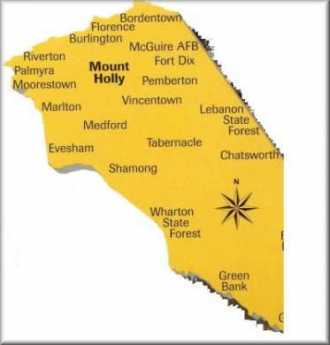
|
| Burlington County Map |
Burlington County used to be called Bridlington. It contains Burlington City, formerly the capital of West Jersey, which is how they styled the southern half of the colony, the part controlled by William Penn. In colonial times, the developed part of New Jersey was a strip along the Raritan River extending from Perth Amboy, the capital of East Jersey, to Burlington. To the north of the fertile Raritan strip, extended the hills and wilderness mountains; to the south extended the Pine Barrens loamy wilderness. The Raritan strip was predominantly Tory in sentiment, while the remaining 90% of the colony consisted of backwoods Dutch farmers to the north, and hard-scrabble "Pineys" to the south, except for the developments farmed by Quakers. The Quakers had ambiguous sentiments during the Revolution, leaving conflicts between pacifism and self-defense to individual discretion. The real fighting mostly went on between the Episcopalian Tories and the Scottish-Presbyterian rebels, both of which were sort of newcomer nuisances in the minds of the Quakers. The warfare was bitter, with the Tories determined to hang the rebels, and the rebels determined to evict or inflict genocide on the loyalists. Standing aside from such blood-letting of course inevitably led to a loss of Quaker political leadership. When East and West Jersey were consolidated by Queen Anne into New Jersey in 1702, the main reason was ungovernability, with animosities which endure to the present time in the submerged form. Benjamin Franklin's son William was appointed Governor through his father's nepotism, but when he turned into a rebel-hanging Tory, his father extended his bitterness about it into a hatred of all Tories. The later effect of this was felt at the Treaty of Paris, where Ben Franklin would not hear of leniency for loyalists, striking out any hint of reparations for their property losses. In a peculiar way, the factionalism resurfaced at the time of the Civil War, where the slave-owning Dutch in the North came into conflict with the slave-hating Quakers in the South. The problem would have been much worse if the Jersey slaveholders had been contiguous with the Confederacy, but it was still bad enough to perpetuate local sectionalism. A few decades ago, it was actually on the ballot that Southern Jersey wanted permission to secede.
Under the circumstances, when James K. Wujcik wanted to work for progress in his native area, he avoided any ambition to enter State politics and concentrated his efforts on Burlington County. He is now a member of the Board of Chosen Freeholders of Burlington County, along with four other vigorous local citizens. Most notable among them is William Haines, the largest landholder by far in the area, whose family still controls the shares of the Quaker Proprietorship. Membership on the Burlington County Board of Freeholders is a part-time job, so Mr. Wujcik is also president of the Sovereign Bank. We are indebted to him for a fine talk to the Right Angle Club avoiding, with evident discomfort, many mentions of state politics or sociology.
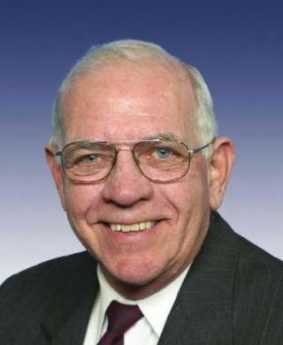
|
| Congressman Saxton |
Burlington is the only New Jersey county which stretches from the Delaware River to the Atlantic Ocean, including the Pine Barrens occupying 80% of the land mass in the center; fishing and resorts dominate near the ocean and former industrial areas along the river. Much of the area has been converted to agriculture for the Garden State, but about 10% is included in a National Preserve. The population has doubled in the past fifty years, so urbanization is replacing agriculture, which had earlier displaced wilderness. The county includes Fort Dix and Maguire Air Force Base, strenuously promoted for decades by now-retired Congressman James Saxton.
Somewhere in the past few decades, Burlington became quite activist. Although many tend to think of real estate planning as urban planning, this largely rural county went in for planning in a big way, deciding what it was and what it wanted to be. Generally speaking, its decision was to replace urban sprawl with cluster promotion. The farmers didn't like an invasion by McMansions or industries, while the towns lost their vigor through tax avoidance behavior of the commuter residents. Overall, the decision was to push urban development along the river in clusters surrounding the declining river towns, while pushing exurban development closer to logical commuting centers, leaving the open spaces to farmers. Incentives were preferred to compulsion, with a determination never to use eminent domain except for matters of public safety. To implement these goals, two referenda were passed with 70% majorities to create special taxes for a development fund, which bought the development rights from the farmers and -- with political magic -- re-clustered them around the river towns. The farmers loved it, the environmentalists loved it, and the towns began to revive. The success of this effort rested on the realization that exurbanites and farmers didn't really want to live near each other, and only did so because developers were looking for cheap land. Many other rural counties near cities -- Chester and Bucks Counties in Pennsylvania, for example -- need to learn this lesson about how to stop local political warfare. Corporation executives don't want to live next to pig farms, but pig farmers are quite right that they were living there, first. When this friction seeps into the local school system, class warfare can get pretty ugly.

|
| Burlington Bristol Bridge |
In Burlington County, they thought big. The central project was to push through the legislature a billion-dollar project to restore the Riverline light rail to the river towns, along the tracks of the once pre-eminent Camden and Amboy Rail Road. It was an unexpected success. During the first six months of operation, ridership achieved a level twice as large as was projected as a ten-year goal. Along this strip of the Route 206 corridor, the old Roebling Steel Works are becoming the Roebling Superfund Site, now trying to attract industrial developers. The Haines Industrial Site originally envisioned as a food distribution center was sold to private developers who have created 5000 jobs in the area. Commerce Park beside the Burlington Bristol Bridge is coming along, as are the Shoppes of Riverton and Old York Village in Chesterfield Township. As Waste Management cleans up the site of the old Morrisville Steel plant across the Delaware River, a moderate-sized development project is becoming an interstate regional one.
No doubt there will be bumps in these roads; the decline of real estate prices nationally is a threat on the horizon, because it provokes a flight of mortgage credit. It works the other way, too, as banks decide to deleverage by reducing outstanding loans; this is the way downward spirals reinforce themselves. And anyone who knows anything about all state legislatures will be skeptical about political cooperation in a state as tumultuous as New Jersey. The Pennsylvania Railroad destroyed the promise of this state once; some other local interest could do it again. Nevertheless, right now Burlington County looks like a real winner, primarily because of effective leadership.
Hidden River
.jpg)
|
| Schuylkill River |
In Dutch, Schuylkill means "hidden river", thus making it redundant to speak of the Schuylkill River. As soon as you become aware of this little factoid, you start to come across Philadelphians who do indeed speak of the Schuylkill in a way that acknowledges the origin of the term. To give it emphasis, it is common to speak of the "Skookle". The point comes up because cruises have started to leave from the dock at 24th and Walnut Streets, where it becomes quite noticeable that the Schuylkill really is rather hidden as it winds seven miles south to the airport, in contrast to the wide-open vista we all are accustomed to seeing from the Art Museum northwards.
The bluff at Gray's Ferry, where the University of Pennsylvania's new buildings now dominate the scene, was originally the beginning of dry land, or the end of the rather large swamp, through which the river winds its way essentially shaded by trees along the riverbank. Never mind the junkyards and auto parks you happen to know lurk behind the trees on the west side or the oil tanks which loom above the trees on the south bank. As evening closed in on the riverboat, the gaily lit towers of center city were looming in the stern, but some fishermen along the bank proudly held up a respectable string of six or seven rather large catfish. If you are there in the evening, the river has the same feeling of wilderness that the Dutch traders would have experienced three hundred years earlier. No swans, however. There were many reports in the Seventeenth Century of large flocks of swans sailing around the entrance of the Schuylkill into the Delaware River. A noted local ornithologist on the recent cruise remarked that forty or fifty species of birds are found there. Even a flock of owls still live within the city limits. You don't see owls, even if you are an ornithologist; their presence is made known by taking recordings of the sounds of the night.
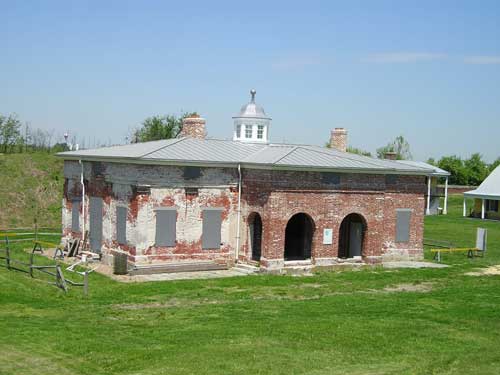
|
| Fort Mifflin |
The geography of swampy South Philadelphia was created by the abrupt bend in the Delaware River at what is now thought of like the airport region. As the river flows at the bend, sediment is deposited in mud flats that once created Fort Mifflin of Revolutionary War fame, and later Hog Island of the Naval Yard, home of the hoagie. Swans are beautiful creatures, but they seem to like a lot of mud. The lower Schuylkill is tidal, and the industrial waste of the region is cleaned out of the land by cutting drainage ditches laterally from the river, flooding the lowlands as the tide rises, and draining it again as the tide falls. This cleansing seems to be working, as judged by the return of spawning fish. And maybe mosquitos, as well, but it would seem rude to inquire.
The Bartram family seems to have known how to make use of river bends and riverbanks, placing the stone barn and farmhouse higher up the bank, but below the bluff of Gray's Ferry forces a bend in the Schuylkill, below which of course flatlands were created. It's a peaceful place, now made available for tours and excursions by placing a landing dock on metal pilings so that it can ride up and down with the tides. The great advantage is that riverboat landings are no longer restricted to two a day, at high tide, with limited time to visit before the tide falls again. Bartram recognized how popular strange plants from the New World would be in England, and his exotic plants were quite a commercial success. Nowadays the big sellers are Franklinia Trees, available the first week in May. The last Franklin (named of course for his friend Benjamin) ever found growing in the wild, was the one John Bartram found and nurtured. Every Franklinia is thus a descendant of this one. They look rather like dogwood but bloom in the early fall. If it suits the fancy, a dogwood next to a Korean dogwood which blooms in June, next to a Franklinia, can make a continuous display of bloom from May to October. And best of all, no one will appreciate it, unless they are in the know.
Quaker Carillon
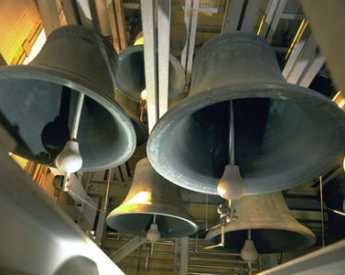
|
| Carillon Bells |
A carillon is a graded series of bells in a belfry, to play tunes. Quakers avoid bells and belfreys, but instinctively grasp the concept of a carillon. Why is that so?
Spoken messages at an unprogrammed meeting, like ringtones of a carillon, are followed by persisting vibrations of varying intensity. Care must be taken, no matter how pure the next message may be, to preserve harmony with the ring decay of the tone it has just followed. Not too soon, not too unrelated.
Overly long delays between messages may be discordant, breaking up the tune unless the message is harmonious. Lacking a tune, the messages fall apart. A silence of even longer length may restore the tune for a gathered meeting, or the next speaker may gently rebuke the interrupter. Sometimes the difference is distinguishable only when you know the personalities. A meeting without a tune is a disappointment, pointing toward individual experience instead of group unity. But death or other catastrophes can have its message destroyed by trite commentary. Rising above triteness can be one way a "weighty" meeting rises above its rank to demonstrate the fearlessness of leadership; failing to rise to an occasion is a way of demonstrating ordinariness.
Mississippi Carillons
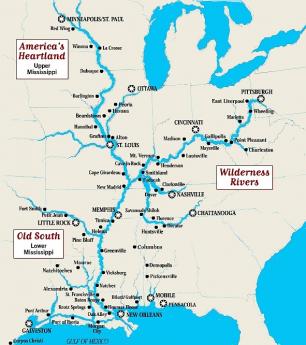
|
| Mississippi River |
The Mississippi River runs over a fifty-foot ledge in the city of Minneapolis, its waterfalls providing power to mill flour, but definitively ending northward navigation on the river. In the eddies and side streams around the rapids, great swarms of Canada geese paddle about, quacking, right in the center of the city. A church with a carillon of shiny bells stands on the bank above this scene, its many bells ringing at once in clashing sounds quite evocative of the gaggles of geese on the river below. Likely, the effect is intentional, although at first encounter it strikes many as dissonance. Acknowledged to be artistic, it is still not music. But others think it is.
At the far opposite end of the Mississippi, in New Orleans, jazz was born. A group of musicians plays together in an aimless way, until one soloist strikes up a melody, with variations. In time, another musician and then still another, take up the melody, playing different variations on different instruments. Sometimes the whole group joins together in a minor patch of a symphony. In time, one musician wanders off on another theme, or the whole group seems to agree on when to stop.
There's a small Quaker meeting in Minneapolis, but most of the Quakerdom branches off to the west of St. Louis up the Missouri River, or to the east of St. Louis up Ohio. There's less overt religious music in the Quaker meetings up Ohio, but there is some. Either way, there is usually a sense of timing and harmony in the verbal messages. Some congregations are like a Belgian carillon, interweaving themes as exquisitely as Bach's Jesu, Joy of Man's Desiring. Others interact directly like a game of volleyball. Only a few seem to find pleasure in independent vocal ruminations resembling a jazz performance, and those are usually meetings too small to organize a carillon effect. Three hundred years ago, it was an important question for Quakers whether to worship together in a group. No minister, no ceremony, no sacred music; just sitting silently together in a gathered meeting. Naturally, the question arises, if you intend to sit quietly in a chair, why not do it at home, alone. Robert Barclay seems to have settled the issue; the purpose of a gathered meeting is to discover and maintain consensus. Robert Barclay had no thought of composing jazz music, and often it does not emerge. But sometimes, and in some places, that's what it resembles.
Mercantilism Dies Hard
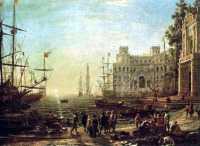
|
| Mercantilism to Americans |
Whatever mercantilism was supposed to mean can be debated by captive college students; mercantilism to Americans is and was just a bad thing having to do with economics, mentioned only when the speaker is searching for an epithet. Our present understanding of the mercantilist term is that brutal government action, even war, was employed to benefit favored citizen merchants, while the economics of a whole nation of consumers was subverted toward enhancing state power. All of this rapacity was for the betterment of one nation at the expense of its neighbors, and at the expense of its colonies. The surprisingly vague but more modern term of fascism is often substituted, to denote evil uses of government to promote the interest of combined military and industrial elite, to the general disadvantage of everyone else. Because so many opponents of mercantilism were upset about specific forms of mercantilist activity, Adam Smith is associated with the idea that mercantilism was the opposite of international free trade, and the American founding father are associated with the idea that mercantilism embodied everything we disliked about colonialism. Some prominent 18th Century leaders constructed a body of theory to defend mercantilism and firmly established the idea that the whole approach was founded on long-discredited sophistry. In recent times, the only reputable economist to defend parts of mercantilism was John Maynard Keynes, who approved of the idea of emphasizing third-world exports in order to assist developing countries into a modern economy. Whatever is the underlying idea behind this mercantilist idea that has caused so much trouble, and includes so many disconnected features?
Allow an amateur theory. In my view the fundamental misconception underlying mercantilism was the idea that economic relations between individuals and nations are a zero-sum game; what I gain must be at the expense of someone else's loss. Almost every child believes that many or even most everyday transactions seem to confirm it, and vast multitudes of mankind believe it to the end of their days. But as part of the Industrial Revolution, the counter-intuitive realization began to spread that cooperative behavior, within limits, could sometimes result in all participants becoming better off, harming no one. Perhaps it was even a universal idea. Adam Smith popularized the idea that when two parties freely participate in the free trade of a marketplace, each one can come away from the trade feeling better off; one party would rather have the goods, the other party would rather have the money, and they trade. Multiplied millions of times, the expansion of free trade would enrich whole nations, even the whole world. George Washington may not have understood all that, but he did know that England was injuring him with rules about insisting British subjects must conduct all foreign trade in British sailing vessels, must not manufacture locally, must do this, must not do that.
Exporting was good, importing was bad, manufacturing was to be concentrated in the mother country, consuming was to be discouraged -- what was the unifying theory behind all this? It would seem to have been the gold standard. Gold was durable, and its supply was limited. It had certain undeniable advantages, but its overall effect was to restrain industrial progress. If the economy is constantly expanding, but the supply of gold is relatively limited, the price or value of everything will go steadily down over time. In George Washington's time that was particularly irksome with regard to the value of his plantation, and his vast land holdings of Ohio land. It was also true of everything else that was reasonably durable. If everything is measured in gold, and gold is limited, then the accumulation of gold is ultimately the only way to accumulate wealth. The English nobility who were profiting from the system might not perceive it, but the colonists could perceive it in their bones. Small wonder that modern banking, economics and innovative finance took root in the American colonies. If not first, at least most vigorously. Small wonder we had a revolution men would die for, while the British were merely annoyed and mystified.
Vast areas of Asia, Africa and the Middle East are still committed to the idea that the only way to get rich is to steal from others; since everyone wants to get rich, everyone steals. Someone has reduced this idea to a simple game theory called the Prisoner's Choice. If two prisoners tattle on each other, both will be severely punished. If both prisoners refuse to testify, both will go free. If one tattles and the other remains mum, the tattler will go free and the loyal comrade will get hanged. Reduced to its simplest level in a series of repeated games, the theory states that it's better for everybody to cooperate most of the time, but you must be willing to play tit for tat if the other party cheats. Be cooperative as much as you can, but never forget to wallop a cheater, and then forgive him later so he can have a chance to play nice. Lots of people will think you are a sucker if you play nice, so, unfortunately, it is necessary to retaliate -- swiftly and painfully -- when someone cheats. Centuries of American history are explainable with this simple game theory.
And not just with tribesmen and Nazis. When Winston Churchill finally realized that the Bretton Woods Conference was going to mean the end of the British Empire, he was almost tearfully plaintive with his friend Frank Roosevelt, but he said he understood.
And six years later, when Churchill's protege Anthony Eden invaded Egypt over the Suez Canal, Dwight Eisenhower the hero of the Normandy Invasion that saved England, suddenly turned nasty. England would immediately abandon that invasion, or Eisenhower would foreclose on British debts and ruin them.
That was the end of British colonialism, and in a sense, it was the final end of the Revolutionary War.
A Quaker Carillon
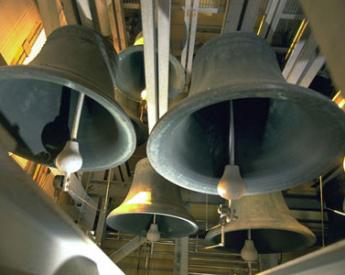
|
| Carillon Bells |
A bell in a belfry tolls the same note, over and over. A carillon is a collection of bells, each a different size and shape, producing a different note. If they all toll together, they make a jangling noise. If tolled in a certain sequence, with a certain timing -- they play a tune.
Carillons were first and best devised in the low countries of Holland and Belgium. The oldest one, and the finest ones are found there, perhaps because some were re-used. When wars approached, they were taken down and melted into cannons. When the war was over, the cannons could be melted into an improved carillon. Those who hate war-- can sometimes go forward, even from war.
Like a tuning fork, a large bell sounds its tone for several seconds. When a second note follows closely, it must be in the same key or register, harmonious, or it will clash. But a second note which waits its turn -- is a companion, and the two then stand together, inviting a third to join them.
Small bells last longer than big ones. Big ones must be struck harder, eventually wearing a flat spot, which produces a flatter tone. In time, the off-key vibration causes the bell to crack -- right at the place that once began as its sweet spot.
The Whole Town as a Retirement Center
THE automobile changed American living habits. A few suburbs had once organized around railroad commuting, and even earlier a few had organized around steamboat commuting. But universal auto ownership was what triggered wholesale flight to the suburbs, completely reorganizing metropolitan living patterns. As suburbs tumbled into neighboring farmland, they seemed to obey a rule that 30-minute commuting was normal. Extremes of regular two-hour commuting do exist, but they conflict with a second hidden rule of suburbs, that some adult must be available when the kids get out of school. A third rule is that most young families move from town to distant suburbs when the first child reaches fourth grade. The unspoken reason this is true is pretty obvious, and I had hoped the election of Barack Obama would focus the Presidential leadership on fixing the inner-city schools, as only a black President would be uniquely qualified to do. Instead, his focus was on reforming the medical system, where he was probably uniquely unqualified. Suburban parents eventually seek a different lifestyle when their last child graduates from high school. For American families attracted by the schools, automobile commuting makes suburbs attractive, while empty nests largely end that interest. And social unrest at school makes parents flee to the exits no matter where they live.
 Remaining in your own home after retirement requires administration. 
|
Although it takes one extra logical step to get there, this insight suggests suburban retirement patterns surprisingly might be changed by improving the inner-city school system. Upgrade the quality and safety of inner-city schools, the rush to the suburbs will slow down, and suburbs become less expensive places for elderly folks to live. That's because school taxes are now the most expensive component of suburban living. Two-earner families are also more likely to be three-car families when they have high school children, so driving would become easier for retirees without so much overconfident competition for the roads if we could find ways to reduce the concentration of high schools in suburbs. If suburbs become a more natural place for retirees to live, they become more natural places for retirement villages to locate, which is the main point of this article.
The concentration of high schools in suburbs is a somewhat artificial response to urban disorders. My local suburban school system acquired a reputation for outstanding quality in a couple of decades. It did so by pouring money into the system, bragging about the schools somewhat unrealistically, usually stopping considerably short of demanding the academic rigor found in private boarding schools. The process was abetted by the local real estate industry, who shrewdly recognized that a popular product was high school glamor, not necessarily discipline and homework. This maneuver uncomfortably transformed a town which, fifty years earlier, found two thirds of the houses owned by families without children in public school. By contrast, just about every house in town today houses nearly two school children, and the school taxes have been driven uncomfortably high. Meanwhile, four or five neighboring suburbs actually developed shortages of children, two school districts even have closed. It seemed clear that families were moving into the "good school" suburb, willingly paying higher taxes while there were children to educate, but eventually moving back to low-tax neighboring suburbs when school quality no longer mattered to them. This recirculation was economically rational, although not necessarily the most efficient use of community resources.
Retirees now have difficulty living in my town, because school taxes are prohibitively high for residents without children in school. Long-time residents regularly sell half-empty houses to newcomers with lots of kids, and then those old-timers move a mile or so away to a low-tax suburb, often into a house as large as the one they just left. Others respond to the situation by moving to a CCRC. Is this a rational way to make rather basic life decisions? Is a suburb dominated suburb by teen-agers really the best place to locate a retirement village? Is a locality created by universal automobile ownership a good place to put an age group with cataracts and slow muscle reflexes?
So retirement villages are located in or nearby to suburbs because potential clents want to live there. The answer they usually give when asked is they want to retain the local medical system they had grown accustomed to. Since every one of them is covered by Medicare, that seems a strange answer, which more specifically means they want to keep the same cluster of doctors, pharmacies and hospitals they got accustomed to when their kids were in high school. They formed those habits at a stage in life when health care was a less dominant feature of their lives, so the connection is not strong. But they were young enough to experiment, and now they are old enough to quit experimenting. The politicians who continue to monkey with the payment system seem strangely unaware of this affiliation. Or the irritation these people will feel if they are coerced into changing.
Among the various reasons given to move to a retirement community, a chief one advanced by many people is that it is cheaper. Alternatively moving back into the center of a neighboring city might be more suitable, substituting a richer cultural and educational environment for a monastic one. In either case, retirement moves imply making a new set of friends, not particularly easy for old people to do. Commuting is no longer a price retirees are willing to pay; hardly anyone without children is willing to commute. Safety from crime, and nearness to medical care beat cultural richness most of the time; sadly, even golf and bridge games usually beat culture, which is more a European ideal than an American one. Although most retirees have forgotten how to enjoy what a city has to offer, center-city life really seems like a more natural attraction for retirees. Although the soccer moms seem to be having a fairly good time at the PTA, teenage cultural dominance of suburbs warps the livability for almost everyone else. Even for teenagers, commuting seems a rather high price to pay for six or seven years of high school excitement, particularly if note is made of the disconsolate loneliness of most adolescents. Inner city schools should improve, dissuading many from moving to the suburbs in the first place; inner city crime and taxes should be controlled to entice a return of the empty-nesters. At the very least, the suburban merchants and real estate agents should be squelched for their constant bad mouthing of neighboring cities. The present sociology of suburbs is a rather fragile thing.
If it becomes financially and socially possible for retirees to continue living in their lifetime homes, is it wise for them to do so? There is, first, the potential need for making financial provision for nursing, convalescent, or hospice care. Long-term care insurance aims at covering this need, but because these costs are high, the premiums for coverage are also high. It is difficult to know whether these prices are reasonable, because they must contain a margin of error against inflation, risk selection, and moral hazard. The technical insurance terms refer to the fact that the client almost certainly knows more about his impending health risks than the insurance company does, and secondly the mere existence of the insurance presents a temptation to use it. Someone living in the residential area of a retirement village surely has less temptation to move to its nursing facility than some other person still living in a house but potentially able to sell it and cash in his long term care insurance. There is also the danger lurking in the insurance that a client may get tired of paying premiums and drop the insurance shortly before needing it. Some types of insurance, notably term life insurance, actually pay claims to less than ten percent of clients; the rest drop the policies prematurely and receive no benefit. The tentative conclusion has to be reached that entering a CCRC is probably a better concept than buying long term care insurance, at least when both members of a marriage couple are comparatively healthy. Once the first one gets impaired or dies, the plight of the survivor definitely gets more precarious, without a volunteer caregiver or at least an in-house alert system.
One thing is pretty clear. At the present time, almost everyone is strongly advised to get on the waiting list of some CCRC, without hesitating to consider whether that is a final best decision. The deposit is ordinarily rather small, typically around a thousand dollars (returnable if unused). It at least eliminates that dreadful situation of urgently requiring admission, only to find the waiting list is years long. Even paying a deposit on several of these facilities at once can be justified if children move around enough to make a specific choice hard to make. An estate lawyer who was my patient was on the waiting list of five CCRCs for many years before he made a final choice; in his profession, he had many opportunities to see the wisdom of this approach. A less advisable choice made by many people is to enter the community before they need to. Comparatively few of these CCRCs permit you to sell out and move elsewhere without a penalty.
Nevertheless, why should you go, why should you disrupt your life this way? The answer seems to lie in the organization and its administration. When life choices are complex, unforeseeable and largely undesirable, and when your abilities may be slipping away, you may want some help without knowing it, or knowing where it get it. Maybe all you need is a new lawyer or tax accountant, or a different type of doctor, but have a little trouble telling a good one from a bad one. A tightly-knit little town can sometimes supply this service, but somehow it must be supplied. For that purpose, a Quaker organization in Philadelphia called Friends Lifecare at Home will manage an annual reassessment and call in the help necessary to remaining in your own home. It is a noble experiment, steadily growing in success. In a way, it supplies the function of the absent spouse, part caregiver, part watchman, and with a large Rolodex. Its main difficulties have come from Medicare, when seemingly capricious program changes change the assumptions in the yearly premium. Lifecare supplies service when Medicare doesn't; what happens when Medicare stops providing something? Lifecare helps you get a new doctor; what if the old doctor doesn't like that very much? The network of specialists and institutions may be just as important as the doctor, but the network changes when you change doctors. Many nursing care agencies refuse to allow their employees to have a key to the house, on advice of a lawyer who senses liability. Sometimes there is an emergency, no one can get in the door, and the fire department must be summoned to break in. There are problems with any arrangement, and there are problems with any alternative arrangement. This one works best when it is selected, not because it is cheaper, but because living at home is strongly preferred.
There's an architectural problem. Most suburban houses are built for families with children. If you plan to live in that house as a frail old pensioner, you had better fix the stair problem. One-story houses are certainly best, and even one-story houses often have stairs at the front door. Installing a home elevator is often prohibitively expensive, but would not be at the time the house is built. Most of the cost of an elevator lies in the construction of a shaft which has not been anticipated. If an elevator is added to a new house, the shaft is little more than two matching closets on two floors. The cab and motor are surprisingly inexpensive, and need not be added when the house is built. It's the design of closet over closet that makes it inexpensively feasible; what house could not use two extra closets? There are a lot of less defensible requirements in most building codes. While you are at it, be sure the doorways are wide enough to admit a wheelchair, the toilet seats low enough to permit wheelchair use, at least one walk-in shower is available, and handlebars provided near the bathtubs. These are things to think about, before you break your hip. If you don't it may add many thousands of dollars of unwelcome expenses at a rehab center, nursing home, or whatever. And not only expense; your roommate in a semi-private room may enjoy raunchy television channels.
There's also a local government problem, I'm afraid. The local volunteer ambulance service, often but not always run by the police or fire department, has its rules. If you are counting on this service to take you to a hospital or other medical service, you'd do well to check with them to see if they will take you to the place of your choice, if that ever becomes necessary. That's particularly true if you have enrolled in some "medical home" or home care service. If the local ambulance service won't take you there, you better know that in advance. If that's the case, don't argue with them. Either take effective political steps to get them to change their rules, or make other plans to get where you might want to go, at that unknown time in the future when you want to go there. If you live in a little town, drop in and visit with the Mayor or Commissioner, who might be unaware of your problem and easily able to fix it. If you live in a larger town, you may not be able to puzzle out where you could appeal. One easy way to work this particular system is to join the ambulance service as a volunteer, and make inquiries when you are on the inside. As a final last resort, if you live in a big city, go see the local ward leader who can fix things. Some of them will want money, but more likely they will only want your vote at the next election. If you are a member of a very large family, you will get more attention, because there are potentially lots of votes in your family. It's all rather sad, but the fact is that local politics usually control local ambulances, and their allowed destinations. A solution to the problem more directly available, is to talk with some of your neighbors who have cars. All that's needed except for unusual circumstances is transportation. You need not, and in fact usually should not, speed. Whenever I have put someone in an ambulance, my parting words to the driver are, "Don't go through any red lights!" Most of the cumbersome rules hampering ambulance use are imposed by insurance companies because of the high rate of accidents from those sirens and flashing red lights on the roof. If not insurance rules, it's lawyers, watchful for, or against, all the lawsuits which have been induced by Section 1983, a Reconstruction-era statute more recently reinterpreted to encourage citizens to sue local officials for just about anything at all, not just Jim Crow abuse.
And finally, there's a neighbor problem. It was first illustrated to me by my own 90-year old mother, who found everybody in her address book had died, so she threw the book away. One day when she needed a plumber, she just dialed zero and asked for "central", which in this case amazingly called the local police, who took care of it. But don't count on being that lucky. Portable cell phones help a lot with the problem of summoning assistance, providing you know someone to call. In a suburb, a lot of people move away for various reasons, and eventually an elderly pensioner living there is marooned in a neighborhood of strangers, never mind living in the same house for seventy years. The television and the Internet can be a great comfort to a hermit, but when help is needed, some familiar name should be pasted to the refrigerator door. Meals on wheels are nice, but they don't come when your sink is plugged up. A friendly local plumber is nice, but he won't help if the roof leaks. Everybody builds up a local network of friends and vendors, but older people need to watch out that it doesn't get out of date. They badly need what many of them don't think they need, a circle of friends.
Robert Barclay Justifies Quaker Meetings
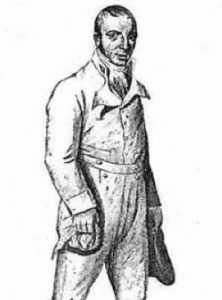
|
| Robert Barclay |
As part of the dissidence and Civil War of 17th Century England, Robert Barclay the Scotsman emerged with a point of view which was structured and reasoned in detail. What was almost unique was his reduction of it to a handful of pithy "Sound Bites". Coupled with membership in a prominent family, these abilities made him a particular friend of James, Duke of York, later King. Barclay became a Quaker at an early age.
The whole point of the Reformation was revulsion against the corrupt Catholic clergy, shielded behind some impossibly convoluted legalisms of doctrine. But for the governing establishment, any reform was going too far if it led to anarchy and chaos; combating disorder was then in many ways the central mission of the Catholic faith. The establishment did recognize that public revolt against universal micromanagement led to the scaffold for Kings who insisted on it. But in their view, the need for law and order still demanded some legitimacy, if not organized law. The Rangers, who paraded about stark naked and lived in ways resembling the hippies of the 1960s, were beyond the pale. Quakers, who professed no formal doctrine except silent meditation, might be possible just as threatening. After all, silent meditation could lead you anywhere including regicide. But the Quakers at least were quiet about it.
George Fox the founder of Quakerism had already provided one basis for containing fears of anarchy, by organizing local monthly meetings for worship within regional quarterly meetings; quarterly meetings, in turn, were within an overall framework of a yearly meeting. Occasional monthly meetings might develop a consensus for wild and antisocial behavior, indeed often did so, but would have to persuade the quarterly meetings whose members naturally outnumbered them. In extreme cases, the whole religion assembled in a yearly meeting. The innate conservatism of the meek would usually silence the extremism of the rebellious few. Very few kings would deny they could go no further toward despotism themselves, without the public behind them. The Quaker problem was to demonstrate what their consensus really was.
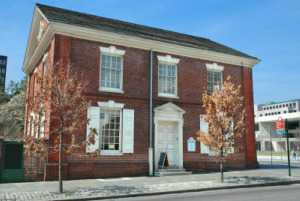
|
| Free Quaker Meeting House |
Essentially, the answer emerged that any religion which renounced a priesthood, which even renounced having a written doctrine, still needed some sort of institutional memory. If every Quaker began with a clean slate, to develop his own organized set of moral principles, then most of them would never get very far. Even if they did, they would have no time left for milking cows and weaving cloth. Single silent meditation was inefficient, particularly if you had faith that everyone was eventually going to arrive at the same convictions as the Sermon on the Mount. The founders of Quakerism took a chance, here. To assume the same outcome, you have to assume everyone starts with the same instincts and talents; even 21st Century America has private doubts about that one. Feudal England would have rejected it contemptuously. Carried to an extreme, it was a claim that everyone was as good a philosopher as Jesus of Nazareth, as good a person, as much a Son of God. That seemed like an arrogant claim. A more humble claim was that collectively, listening respectfully to one another in a gathered meeting, the whole world would over time reach the same truths as the Creator. If not, that still was as about as close as you were going to get to an oral memory, slowly building on the insights of the past.
Like all the early Quakers, Robert Barclay spent some time in jail. He did visit America in 1681, but it is doubtful if he spent any time here while he was Governor of East Jersey, from 1682 to 1688. The King insisted on his appointment, because he seemed the most reasonable man among the most reasonable sect of dissenters, and therefore the rebel he chose to deal with.
First Amendment: Separation of Church and State
 Amendment 1 Congress shall make no law respecting an establishment of religion, or prohibiting the free exercise thereof; or abridging the freedom of speech, or of the press, or the right of the people peaceably to assemble and to petition the government for a redress of grievances. 
|
| The First Amendment |
Simplified histories of America often declare that other Western Hemisphere colonists mostly came to plunder and exploit; whereas English Protestant colonists came with families to settle, fleeing religious persecution. That's a considerable condensation of events covering three centuries, but it is true that before the Revolutionary War, eleven of the thirteen American colonies approximated the condition of having established religions. Massachusetts and Virginia, the earliest colonies, had by 1776 even reached the point of rebelliousness against their religious establishments. The three Quaker colonies (New Jersey, Pennsylvania, and Delaware) were late settlements, in existence less than a century before the Revolution, and still comfortable with the notion they were religious utopias. While differing in intensity all colonials respected the habits of thought and forms of speech, natural to utopians residing in a religious environment.
Once Martin Luther had let the Protestant genii out of its religious bottle, however, revisionist logic was pursued into its many corners. Ultimately, all Protestant questers found themselves confronting -- not religious dogmatism, but it's opposite -- the secularized eighteenth-century enlightenment. Comparatively few colonists were willing to acknowledge doubts openly about miracles and divinity. However, private doubts were sufficiently prevalent among colonial leaders to engender restlessness about the tyrannies and particularly the rigidities of the dominant religions. To this was added discomfort with self-serving political struggles observable among their preachers, and alarm about occasional wars and persecutions over arguably religious doctrines. Arriving quite late in this evolution of thought -- but not too late to experience a few bloody persecutions themselves -- the Quakers sought to purify their Utopia by eliminating preachers from their worship entirely. Thus, the most central and soon the most prosperous of the colonies made it respectable to criticize religious leaders in general for the many troubles it was believed they provoked.

|
| London Yearly Meeting |
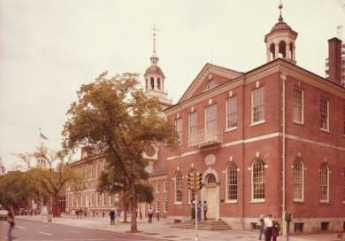
|
| Congress Hall |
In all wars, diplomatic arts and religious restraints get set aside as insufficient, if not altogether failures for an episode of utter barbarism. In the Revolution, some Quakers split from pacifism and became Free Quakers, many more drifted into Episcopalianism, never to return to pacifism. The Constitutional Convention of 1787 was eventually held in this persisting environment; the previous service in the War counted for something, and the great goal was to strengthen the central government -- for more effective regional defense. A great many leaders were Masons, holding that much can be accomplished by secular leadership, independent of religious reasonings. Neither Washington nor Madison revealed much of their religious positions, although Washington the church attender always declined communion; Franklin and probably Jefferson were at heart deists, believing that God might well exist, but had wound up the universe like a clock to let it run by itself. The New England Calvinist doctrines have since evolved as Unitarianism, which outsiders would say theologically is not greatly different from deism. Physically surrounding the Philadelphia convention was a predominantly Quaker attitude; entirely too often, preachers get you into trouble.
When the first Congress finally met under their new constitution, they immediately confronted over a hundred Constitutional amendments, mostly submitted from the frontier and fomented by Jefferson and Patrick Henry, demanding a bill of rights. The demand within these amendments was overwhelming that the newly-strengthened central government must not intrude into the rights of citizens. Recognizing the power of local community action, states rights must similarly be strengthened. Just where these rights came from was often couched in divine terms for lack of better proof that they were innate, or natural. From a modern perspective, these rights in fact often originated in what theologians call Enthusiasm; the belief that if enough people want something passionately enough, it must have a divine source. The newly minted politicians in the first Congress recognized something had to be done about this uproar. Congress formed a committee to consider matters and appointed as chairman -- James Madison. Obviously, the chief architect of the Constitution would not be thrilled to see his product twisted out of shape by a hundred amendments, but on the other hand, a man from Piedmont Virginia would be careful to placate the likes of Patrick Henry. The ultimate result was the Bill of Rights, and Madison packed considerably more than ten rights into the package, in order to preserve the cadence of the Ten Commandments. The First Amendment, for example, is really six rights, skillfully shaped together to sound more or less like one idea with illustrative examples. Overall freedom of thought comfortably might include freedom of speech (and the press), along with freedom of religion and assembly, and the right to petition for grievances. But what it actually says is that Congress shall not establish a national religion. Since eleven states really had approximated a single established religion, the clear intent was to prohibit a single national religion while tolerating unifications within the various states. Subsequent Supreme Courts have extended the Constitution to apply to the states as well, responding to a growing recognition that religious states had the potential to get so heated as to war with each other. No matter what their doctrines, it seemed wise to deprive organized religions of political power as a firm step toward giving the Constitution itself dominant power over the processes of political selection.
At first however it was pretty clear; one state's brand of religion was not to boss around the religion of another state. Eventually within one state, Virginia for example, the upstate Presbyterian ministers were not to push around the Episcopalian bishops of the Tidewater. Madison and Jefferson saw well enough where political uprisings tended to start in those days, in gathered church meetinghouses. In this way, an Amendment originally promoted to protect religions had evolved into a way to ease them out of political power. The idea of separation of church and state has grown increasingly stronger, to the point where most Americans would agree it defines a viable republic. No doubt, the spectacle of preachers exhorting the same nation in opposite directions during the Civil War, settled what was left of the argument.
For Quakers, the most wrenching, disheartening revelation came when they were themselves in unchallenged local control during the French and Indian War. The purest of motives and the most earnest desire to do the right thing provided no guidance for those in charge of the government when the French and Indians were scalping western settlers and burning their cabins. Yes, the Scotch-Irish settlers of the frontier had unwisely sold liquor and gunpowder to the Indians, and yes, the Quakers of the Eastern part of the state had sought to buffer their own safety from frontier violence by selling more westerly land to combative Celtic immigrant tribes. A similar strategy had worked well enough with the earlier German settlers, but reproachful history was not likely to pacify frontier Scots in the midst of a massacre. The Quaker government was expected to do what all governments are expected to do, protect their people right or wrong. To trace the social contract back to William Penn's friend John Locke was too bland for a religion which prided itself on plain speech. Non-violent pacifism just could not be reconciled with the duties of a government to protect its citizens. The even more comfortably remote Quakers of the London Yearly Meeting then indulged themselves in the luxury of consistent logic; a letter was dispatched to the bewildered Quaker Colonials. They must withdraw from participation in a government which levied war taxes. And they obeyed.
Although the frontier Scots were surely relieved to have non-Quakers assume control of their military duty, the western part of the state has still neither forgotten nor forgiven. In their eyes, Quakers were not fit to be in charge of anything. Quaker wealth, sophistication and education were irrelevant; only Presbyterians are fit to rule. A strong inclination toward pre-destination lurks in that idea. Once more, the attractiveness of clear separation of church and state is reinforced.
The French and Indian War in fact had turned out fairly well; most of its victories were located on the European side of the Ocean, anyway. But twenty years later the Revolutionary War turned into a reassertion of the British conquest of all of North America, not merely the part to the west of the Appalachian mountains. To Americans, this came in the form of a demand for taxes to help pay off the costs of a war which greatly benefitted them. The Quaker colonies did not fully sympathize with rebellion, but they had once given up control of a territory larger than England rather than pay war taxes, so they were resistant to both sides in the dispute. Many prosperous and educated Quakers solved their dilemma by fleeing to Canada, but the ardent Quaker proposal for dealing with a coercive British government was not at all impractical. John Dickinson, in particular, argued that since the British motives were economic, success was most likely to come from economic counter-pressure, adroitly leveraged by three thousand miles of intervening ocean. That was shrewd and potentially effective. But the Scots-Presbyterian position was simpler and more direct. If you want us to fight your war, you are going to have to fight to win. The Virginia Cavaliers were probably more likely to win a conventional war if put in charge, but the blunt and almost savage frontiersmen were ideally suited for what has come to be called guerrilla warfare. Washington was a leader, French money was welcome and Ben Franklin was a diplomat, but the clarion call to this particular battle was the voice of Patrick Henry. All in all, the issue of established religion was far more complicated than merely the affirmation of a right to free exercise of religious belief. What united all the colonies was a recognition that, using the church, an arm of the government was just as likely to cause trouble as conducting the state as an instrument of church interests. Eventually, considering how religious America was at the time, there was remarkably little resistance to the firm separation of Church and State in its Constitution.
Puritan Boston & Quaker Philadelphia
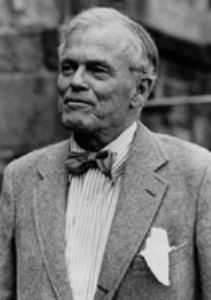
|
| Professor Digby Baltzell |
Digby Baltzell had something of the defiant rebel in him. He surely didn't imagine his employer, the University of Pennsylvania, was pleased to have him a document that Harvard is a better college than Penn. Nor were fellow members of the Philadelphia Club pleased to confront scholarship that his city's gentry was too devoted to money-making to accept the ardors of public leadership. Nor would his relatives in the Society of Friends enjoy accusations their religion impaired the pursuit of excellence in all fields of the city's endeavor. Later articles will here take up some unfair assaults, and defend Quaker simplicity and Peace Testimony. Some blame must, of course, be shared, some mitigating circumstances acknowledged. And let it be said in Baltzell's support that it truly is remarkable how many cultural features do get passed down for ten or more generations. Or even longer; look at the persistence of ancient Chinese, Indian, Esquimo, Viking, Roman, Christian and other cultural heritage. The Quakers got to Pennsylvania early, they are now vastly outnumbered. Many Quaker ideas continue to influence present inhabitants, some ideas probably hold us back. Substitute "Puritans of Boston" for "Quakers" in the foregoing sentence, and conclude by saying "some of those ideas probably give Bostonians an edge". Those two rather unexceptional declarations summarize a controversial book, although they do not completely capture its overall censorious flavoring.
To a certain extent, Digby is his own worst enemy. While alive, he was one of the world's most charming raconteurs, a walking encyclopedia of local lore. Like a good docent in a museum, he could walk into a room hung with portraits, and charm any audience for an hour; presumably, his sociology lectures at Penn held the same magnetism for his classes. In a book for popular readers, however, it is overdone to go on about the same point for six hundred pages. He needed a better editor, or perhaps he needed to permit a better editor to make him restrain his tendency to multiply illustrations beyond the point where the reader loses the thread of the argument. Not all readers will agree with his argument; they can only be legitimately defeated by focused argument. That's perhaps unrequired of college professors holding the power of grade-point averages over nineteen-year-olds, but it is expected of conversation with other adults. If an editor wants to sell books to a general bookstore audience, he should induce authors to overcome the take-it-or-leave-it habit.
As a general reaction to this book, Baltzell seems to think Quakers do not want to be rich and that consequently, latecomers into the region tend to share this feeling. My own view is that Quakers see they can have almost all of the value of being moderately rich -- by disdaining the trivial luxuries of the middle classes. They do not exactly renounce fame and power but are unwilling to gamble much or sacrifice much, in order to enjoy the comparatively small exhilaration of being very rich. They are now no longer surrounded by junior versions of themselves, but by bank-robbing Willie Suttons who readily attack Quakers for being where the money is, and appear to be pushovers at that. When Quakers then promptly demonstrate they are not pushovers at all, they are treated like outsiders in their own town. In many ways and at most times, the populist crowd gives up trying to understand Quakers and decides they must somehow always behave in ways that others would not. It's hard to achieve much deference in such an environment.
Many of Baltzell's important insights grew out of his position as a Philadelphia and academic insider; he personally knew many of the people he described. However, such an infiltrator runs the constant risk of being viewed as a tattle-tale, so a cover is required. Batzell's technique involved frequent use of quotations from others, not so much to prove a point as to rephrase it. This is another feature of the book which might have benefited from a hard-nosed editor. However this is how he wanted it, and in a post-publication revision, here is a condensation of how he summarizes his argument:
When studied with any degree of thoroughness, the economic problem will be found to run into the political problem, the political problem, in turn, run into the philosophical problem, and the philosophical problem itself to be almost indissolubly bound up at last with the religious problem.
--Irving Babbitt
In the South, ....left-wing Quakers came to the fore in the pine barrens of North Carolina-- to this day, North Carolinians speak of their state as "a valley of humilities between two mountains of conceit."
--E. Digby Baltzell
The world is only beginning to see that the wealth of a nation consists more than anything else in the number of superior men it harbors.
-- William James
I believe that ambitious men in democracies are less engrossed than any other with the interests and judgments of posterity; the present moment alone engages and absorbs them...and they are much more for success than for fame. What appears to me most to be dreaded, that in the midst of the small, incessant demands of private life, ambition should lose its vigor and its greatness.
-- Alexis de Tocqueville
Our rulers today consist of a random collection of successful men and their wives. ....They have been educated to achieve success, but few of them have been educated to exercise power. Nor do they count with any confidence upon retaining their power, nor of handing it on to their sons. They live therefore from day to day, they govern by ear. Their impromptu statements of policy may be obeyed, but nobody seriously regards them as having authority.
--Walter Lippmann
Equalitarians holding...extreme views have tended to believe that men of great leadership capacities, great energies or greatly superior aptitudes are more trouble than they are worth.
--John W. Gardiner
In the Jacksonian era in this country, equalitarianism reached such heights that trained personnel in the public service were considered unnecessary...Thus, in the West, even licensing of physicians was lax, because not to be lax was apt to be thought undemocratic.
--Merle Curti
In the late eighteenth century we produced out of a small population a truly extraordinary group of leaders-- Washington, Adams, Jefferson, Franklin, Madison, Monroe, and others. Why is it so difficult today, out of a vastly greater population, to produce men of that character?
--John W. Gardiner
It is nevertheless certain that the high quality of Virginia's political leadership in the years when the United States was being established was due in large measure to those very things which are now detested. Washington and Jefferson, Madison and Monroe, Mason, Marshall, and Peyton Randolph, were products of the system which sought out and raised to high office men of superior family and social status, of good education, or personal force, of experience in management: they were placed in power by a semi-aristocratic political system.
--Charles S. Syndor
Another clue to the relationship between hierarchy and leadership is suggested by Gardner's list of the Founding Fathers. All of these men were reared in Massachusetts or Virginia; none was reared in the colony of Pennsylvania, though Philadelphia was the largest city in the new nation and contained perhaps the wealthiest, most successful, gayest, and most brilliant elite in the land. Not only had Pennsylvanians little to do with taking the lead in our nation's founding, but the state has produced very few distinguished Americans throughout our history...I shall concentrate here on the commercial cities of Boston and Philadelphia, whose great differences in leadership and authority were far more likely to reflect differences in ideas and values.
--E. Digby Baltzell
Whatever else ...America came to be, it was also an experiment in constructive Protestantism.
--H. Richard Niehbur
All this is only to say that man is a product of his history, where nothing is entirely lost and little is entirely new.
--E. Digby Baltzell
For the wine of New England is ...more like the mother-wine in those great casks of port and sherry that one sees in the bodegas of Portugal and Spain, from which a certain amount is drawn off each year, and replaced by an equal volume of the new. Thus the change is gradual, and the mother wine of 1656 still gives bouquet and flavor to what is drawn in 1956.
--S.E. Morison
New Englanders, ambitious beyond reason to excell.
--Henry Adams
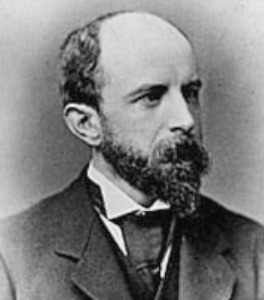
Henry Adams Pennsylvania became the ideal state, easy, tolerant and contented. If its soil bred little genius, it bred less treason. ... To politics, the Pennsylvanians did not take kindly. Perhaps their democracy was so deep an instinct that they knew not what do to with political power when they gained it; as though political power was aristocratic in its nature, and democratic power a contradiction in terms.
--Henry Adams
The reproach I address to the principles of equality is that it leads men to a kind of virtuous materialism, which would not corrupt, but would enervate the soul, and noiselessly unbend its springs of action.
--Alexis de Tocqueville
In our egalitarian age of mistrust, trustworthy men of great ability are increasingly refusing to run for public office or to serve in positions of authority and leadership in our society...In the rest of this book, I shall try to show how and why the Quaker city of Philadelphia, in contrast to Puritan Boston, has suffered from that virus of virtuous materialism for almost three centuries and how its best men, on the whole, have seldom sought public office or positions of societal authority and leadership outside business.
--E. Digby Baltzell
REFERENCES
| Puritan Boston and Quaker Philadelphia: E. Digby Baltzell. ISBN-13: 978-1560008309 | Amazon |
William Penn, Excellent Lawyer, Terrible Businessman
Richard Dunn, who with his wife Mary Maples Dunn stand as the two core authorities on the life of William Penn, merely smiles when asked to describe what Penn was really all about. "What we need is to have one good biography emerge," said he, "but it isn't easy to guess what it will say". For the present, let's just sketch a few paradoxes which somehow need threading together.
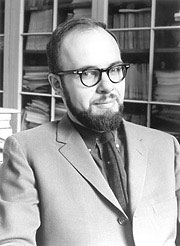
|
| Richard Dunn |
In the first place, the wealth of William Penn can only be described as prodigious. His father had played a central role in restoring the Stuart monarchs, and in the course of it had conquered for the Crown the enormously valuable property of the Island of Jamaica. For these efforts, the father had been rewarded with extensive properties in Ireland and a highly influential position at Court. To all of this was overgenerously added as debt repayment, the American territories which have now become the states of Delaware, New Jersey, and Pennsylvania. Actual ownership of some of this was shared with others, but all of it was quite effectively controlled by young William. No one else stands even close as the largest private landholder in American history. But to appreciate the immensity of his wealth, it should be understood that he treated this property as a sort of hobby. Over the course of his lifetime, the colonies lost money, and Penn subsidized them rather seriously from his other assets.
At the same time, Penn lived vastly beyond his income in ordinary ways, becoming heavily indebted, eventually going to debtor's prison. It probably was not necessary; his sons renounced Quakerism and made a profit on the colonies after they inherited them. Although he could display remarkable organizational talent, particularly in the organization of New Jersey, his management was mostly slack, his judgment of agents often proved too trusting, and he permitted himself to be exploited by poorly-designed contracts to his eventual financial ruin. Even that might not have been serious; he displayed a towering legal mind in the devising of the doctrine of jury nullification and was the winner in a great many lawsuits. He even demonstrated he was capable of winning dubious lawsuits, soundly defeating Lord Baltimore in a border dispute over Maryland which others have said showed Baltimore had the stronger case. We know he had influence at Court, and such legal victories suggest he might on occasion have taken full advantage of it.
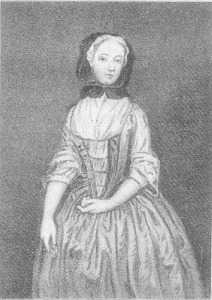
|
| Gulielma Maria Springett Penn |
From the sound of things, some have concluded Penn was so rich and powerful he grew careless about his own best interests, which essentially needed very little defense. In particular, he gave this impression to his fellow Quakers, who concluded he did not need nor likely would stoop to collecting what he was owed in taxes and property sales. This cavalier attitude encouraged the early Quaker merchants to follow their own advantage without shame, and as it happened with great vigor. The Constitutions he devised for the colonies are frequently cited as the brilliant cornerstones of fairness and stability, ultimately the models for much of our present Constitution. Penn really was sincere in wanting to provide a better life for the working people than they could have at home in England. But in the Seventeenth Century, the modest role he devised for the Proprietor commanded little respect and was not one his aggressive clients would have chosen for themselves in his position. Perhaps the most generous description of their passive aggression would be that he taught power and governance to be the collective possession of the whole Quaker meeting, so the leaders of the meeting simply took him at his word. For their part, there can be little doubt of their commercial talents; trade and industry immediately thrived in the colony. However, sharp, aggressive trade and commerce were not things a gentleman would himself want to associate with.
Unfortunately, the historical records of the early colonies are not good; for the most part, we have to surmise the struggles and frictions between a rich, financially careless, and sincerely earnest theologian in his contention with a group of poorly educated strivers who had been told he regarded each of them to be his equal. As the saying goes, he was rich beyond denying. And therefore, he was probably arrogant beyond his own ability to see it as a flaw.
Equal before the law, perhaps, and equal in the prayers of First-day Meeting. But everything about his upbringing, his social circle in London, and his staggering wealth suggested that even a saint would have trouble believing, deep in his heart, that these were truly his equals. And even if perchance he did believe it, they would not have believed it for a moment, had their positions been reversed. Penn certainly acted as though he believed in religious freedom, serene in the idea that if every person earnestly thought hard about ethical issues, everyone would eventually reach about the same conclusion. The elders of the meeting, however, behaved in ways which suggested they would personally prefer non-Quakers to settle somewhere else, and given half a chance would create Quakerism as an established church. There seemed to be those who felt that Friend William was perhaps a little too trusting. And anyway there were some obvious paradoxes. William Penn kept personal slaves.
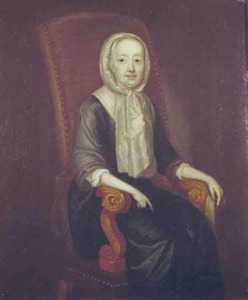
|
| Hannah Callowhill Penn |
With two wives, William Penn had thirteen children. Among them was considerable diversity of opinion, along with the same tendency to rebellion found in any two generations. Early illnesses and chance led to the emergence of those children who renounced Quakerism and showed no shame at all about wanting to have money in order to spend it recklessly. One would have supposed that a man of Penn's intellectual stature would have been able to control his family better, but his own reckless youth had been so extreme that he had few arguments available when, as seems virtually certain, rebellious children defended themselves by reminding him of his own indiscretions. William Penn displayed absolutely no sense of humor; a touch of it would have been useful in mastering a family and friends who were undoubtedly having a little trouble knowing what to make of this apparition in their midst. Some equally pompous Pennsylvania merchants might have had difficulty denying that in their passive aggression, they occasionally resembled the spoiled brats with whom he found he had ample family association.
REFERENCES
| Remember William Penn, 1644-1944: A Tercentenary Memorial : Edward Martin: ISBN-13: 978-1258369934 | Amazon |
Foot of Arch Street
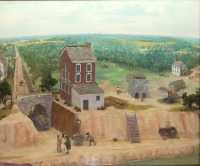
|
| The Foot of Arch St. |
What we now call Arch Street in Philadelphia was originally named Mulberry Street. Just when that change officially occurred could be argued about, but it took its new name from the fact that a road was cut through the high river bank for easier access to riverside shipping, and an overhead arch connected the two cut ends of Front Street at the point of crossing. A model which is still on display in the Friends Meetinghouse at 4th and Arch depicts this arch in place in 1684. The model displays Thomas Holme, Penn's surveyor, and map-maker, pointing up at the arch. It is a matter of record that Thos. Holme owned the property at the corner of Front and Mulberry, so presumably, the red brick house stranded by the newly excavated street was Holmes. By the time of the Revolution, the Arch Street wharf had become the center of Delaware River commerce. The model depicts that even in 1684, Arch Street led straight to the Schuylkill.

|
| The Free Quaker Meetinghouse |
The cemetery at 4th and Arch, set aside as early as 1684 as a burying yard, is known to contain at least 40,000 unmarked graves, many of them from the yellow fever epidemics of the late 18th Century. The meetinghouse was built right on top of them, a fact which may now offend some visitors. But it was in keeping with the ancient tradition of burying the dead in the consecrated ground of a churchyard, more or less as a sanitation measure. It is also in keeping with the tradition of early Quakers not to allow their pictures to be displayed, or even their names to be placed on tombstones.
When disputes arose about warfare in the Revolutionary War, and many non-Quakers who had been expelled for one reason or another joined with non-Quakers to form the Free Quaker Meeting, it ended up where it is now, at 5th and Arch. The Friends Center, home to the administrative focus of Quakerdom, is at 15th and Cherry, just a partial block from Arch Street. At the time of the construction of the 4th and Arch Meeting, many Quakers moved into the area to be within walking distance, giving rise to the original meaning of the term "North of Market".
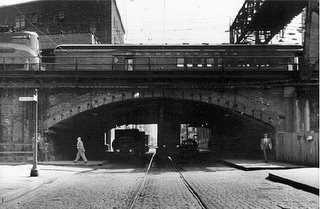
|
| Chinese Wall |
By the time of the Revolution, the Arch Street dock was the commercial heart of town, and the London Coffee House at Front and Market was the thriving center of international gossip. Tradition has it that it was Bradford, the owner of the London Coffee House, who first got the news of the Stamp Act, and started the agitation which famously resulted. The construction of the elevated "Chinese Wall" of the Pennsylvania Railroad along what is now John Kennedy Boulevard, sliced off the Northern side of town as a quiet fashionable place to live for nearly a century. And while the Benjamin Franklin Parkway was intended to correct this situation, it actually finished "North of Market" as even inhabitable. Things are gradually improving, particularly with infusions of public money, but it takes a long time for such urban scars to heal.
Three Revolutions at Once, Maybe Four
The rise of the Tea Party movement in 2010 reopens a lifetime question in my mind. What was the American Revolutionary War all about; surely, a tax on tea isn't outrageous enough to go to war over, is it? It only aggravates curiosity to learn this particular law passed by the British Parliament, actually lowered the price of tea.
A somewhat different importance for the 21st Century is, of all the dozens or even hundreds of little civil wars that have popped up in the past two centuries, this American one seems to have had the biggest impact on the thoughts and behavior of the civilized world. The French Revolution comes close, but we meant to speak of persuasive influence on serious minds, not merely bloodiness and lasting grievance. Here are three suggestions, maybe four.
In retrospect, we can see the outlines of three major revolutions, coming together at the end of the 18th Century. The first is the Industrial Revolution, which had its beginnings in England around the city of Manchester. That was a region of major Quaker concentration, many of whom migrated to William Penn's social experiment in seeing what peace could do. The Industrial Revolution flourished in Great Britain far more readily than in France, and in a sense more than in America. But of the three major countries, America had the largest amount of unsettled land and the greatest natural resources of the three major countries. America was able to think bigger and broader, necessarily requiring broad support from an immigrant population. Diversity was often later to prove a mixed blessing, but in the Industrial Revolution it was vital.
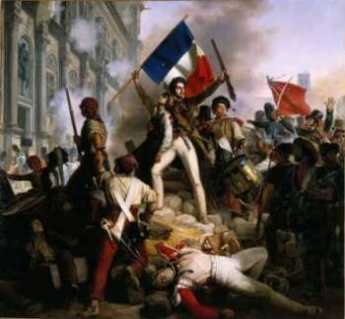
|
| Dissent, French Style |
The second major revolution taking place at that time concerned the place of property in the life of every citizen. Up until that time, the King owned all the land and could redistribute it to suit his political needs. What critically mattered was not who formerly owned the land, but rather what was the latest King's latest word on who owned it right now. The American system gravitated to the notion that when the King or any other owner sold the land, it was no longer his; we now think that's quite self-evident. Each successive owner can sell it to his neighbor or bequeath it to his heirs, and at that moment it is no longer his, either. This idea of private property spread throughout the world, but in America, it was a clean sweep. Adopting the rather brutal rough justice of the frontier, the Indian prior ownership just didn't count. They had sided with the British in our revolution and were insistently resistant to assimilation. And anyway, Pope Nicholas in the 13th Century had established the notion of first discovery, which applied to Christians, only, and so Indians didn't count. Fair or unfair, this was going to be the way it was, from that point forward from 1787 when the Constitution was enacted. The longer the situation lasted, the more unlikely it became that it would ever change. America had so much land and so little coinage, that land itself became a sort of monetary standard. The particular American advantage was there was so much land that early settlers and landed gentry could not monopolize it; from meaning land at first, property soon meant any valuable possession. No King, particularly not George III, was going to take this away from the whole population on this side of the Atlantic. England could do as it pleased with its land and its King. If we needed Independence to preserve a general right to hold private property, plenty of men were willing to die to achieve it. And the whole Western world soon followed our example.
The third revolution was the one you read about, Lexington and Concord, Bunker Hill and the Tea Act. That whole chain of events chronicles how America came to be Independent but somehow fails to explain why we wanted Independence. The Industrial and the Property revolutions explain it better, but such theorizing would certainly mystify the Revolutionaries themselves.
And finally, one begins to wonder if we aren't toying with a reversion to the ideas underlying monarchy when we examine some currently widespread views. There's a notion going about that everybody owns everything, which if carried to an extreme means no one owns anything. When you can notice people who live on the 70th floor of a Manhattan apartment building, proclaiming a right to tell Alaskans whether or not they can drill for oil, you behold this monarchy of the many. And when you see prosperous educated adults shouting at rallies, you can see Alaskans, for example, want to tell New Yorkers to mind their own business. This land, they seem to say, isn't everybody's at all, it is mine.
It never really was entirely the King's, either. The King was a single person, sometimes a rather brutal one who wasn't likely to tolerate advice from his subjects. At times of crisis, somebody has to make a decision, any decision, and act on it. But most of the time, kings seemed to be in the position of that Czar. The one who said, "I don't rule Russia. Ten thousand clerks rule Russia."
Lumpers In Constant Combat With Splitters
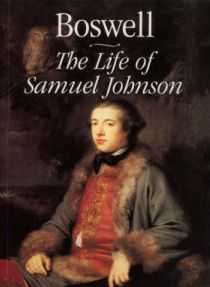
|
| James Boswell's Book |
Some colleges produce managers by teaching management theory, but in certain Ivy League colleges it is thought to be more useful to teach how to dominate a committee, eventually perhaps a board of directors, or a board of trustees. The handbook of instruction is James Boswell's Life of Johnson which is a rather large book of verbatim notes that Boswell took of his many lunches at a London club in the 18th Century. Boswell was a quiet mouse privileged to sit in the company of the great Dr. Samuel Johnson, surrounded by the most eminent intellects of the Enlightenment. Boswell carefully manages the background of each episode, describing the issue and the various arguments, and then -- Sam Johnson's booming voice settles the matter. After he speaks, the meeting is over.
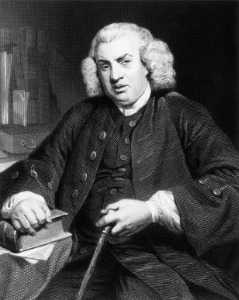
|
| Dr. Samuel Johnson |
"Why, sir", says Johnson, and then look out for the one-liner to follow. We get the impression that Dr. Johnson used that "Sir" signal to indicate he had enough of these dumb arguments, and soon would come the growled epigram that scatters any token resistance. Boswell may have neglected to record instances where the great Johnson was defeated in debate, who knows. We are left with the distinct impression that if you engaged in lunch table conversation with Sam, you were almost certain to lose. So that's what Ivy League students are being taught: how to win a debate at a committee meeting, in the expectation they would spend much of their lives in committees, boards, and even cabinets. That's how the English-speaking world gets its work done and its decisions made. That's what lunches at the Franklin Inn Club, or the club tables of the Union League, are trying to do for the education of neophytes.
As the goggle-eyed student of the great Chauncey Tinker, who gave young Pottle his start in life, it was an awesome performance for me to watch. But the rules of this game never became entirely clear to me, I'm afraid, until the other evening when I listened to Peter Nowell describe in a half-dozen brief paragraphs how he had revolutionized prevailing theories of the cause of cancer. The Franklin Institute then followed the award ceremony by putting on an all-day symposium of notables who run elaborate enterprises in cancer research, essentially funded by the National Institutes of Health, your tax dollars at work again. Last year, the NIH dispensed thirty billion -- you heard me -- dollars in research grants to internationally known research entrepreneurs, and if you can stay awake during their talks, there must be something the matter with you. So far as I could see, they were painstakingly describing every grain of sand on the beach, whereas Peter Nowell made the whole beach electric and clear in ten minutes. Essentially, he was saying that each patient's cancer is caused by a long chain of events, starting with a single mutation within a single cell. All the other cancer cells of a patient are descendants of that first one, which triggered the cascade of chemical events now repeated by the descendants. To stop the process, you probably only have to find a way to break the chain at one vulnerable point. Then you have a cure, without necessarily understanding every other link in the chain.
Peter Nowell described himself as a "lumper", admitting that most scientists are "splitters". A splitter quite reasonably attacks a complex problem by isolating one small piece of it at a time; that's really a pretty good way to address overwhelming complexity when you encounter it. But you can be sure that people of that mindset should not be found in a President's cabinet, deciding how to save the world from impending disaster. Whether by their own genetic predisposition or as a result of peer pressure in their profession, they are habitual splitters. And it suddenly occurred to me why Sam Johnson's one-liners always won the argument; he was a lumper. Usually right, sometimes wrong, never in doubt. Witty as a Frenchman, but as quick as a rattlesnake. Cordial, perhaps, unless you disagreed with him.
We need more lumpers. If they get that way from the likes of Chauncey Tinker, we need to print more copies of The Life of Johnson. If they are born that way, maybe we need a breeding farm for lumpers, which is what the Assembly Ball amounts to. But don't get me wrong, we need more splitters, too. They just have to learn their place at the table.
Franklin's Codicil to His Will: Strange Afterthoughts
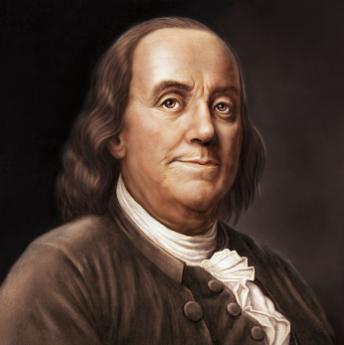
|
| Benjamin Franklin |
"I would have my body buried with as little expense or ceremony as may be. I revoke all former wills by me made, declaring this only to be my last.
I wish to be buried by the side of my wife, if it may be, and that a marble stone, to be made by Chambers, six feet long, four feet wide, plain, with only a small molding around the upper edge, and this inscription:
Benjamin And Deborah Franklin 178-
to be placed over us both.
The king of France's picture, set with four hundred and eight diamonds, I give to my daughter, Sarah Bache, requesting , however, that she would not form any of those diamonds into ornaments either for herself or daughters, and thereby introduce or countenance the expensive, vain, and useless fashion of wearing jewels in this country; and those immediately connected with the picture may be preserved with the same.
My fine crab-tree walking stick, with a gold head curiously wrought in the form of the cap of liberty, I give to my friend, and the friend of mankind, General Washington. If it were a Sceptre, he has merited it and would become it. It was a present to me from that excellent woman, Madame de Forbach, the Dowager Duchess of Deux-Ponts, connected with some verses which should go with it. I give my gold watch to my son-in-law Richard Bache, and also the gold watch chain of the Thirteen United States, which I have not yet worn. My timepiece, that stands in my library, I give to my grandson, William Temple Franklin. I give him also my Chinese gong.
To my dear old friend, Mrs. Mary Hewson, I give one of my silver tankards marked for her use during her life, and after her decease, I give it to her daughter Eliza. I give to her son, William Hewson, who is my godson, my new quarto Bible, and also the botanic description of the plants in the Emperor's garden at Vienna, in folio, with colored cuts.
My picture, drawn by Martin, in 1767, I give to the Supreme Executive Council of Pennsylvania if they shall be pleased to do me the honor of accepting it and placing it in their chamber."
Religion at Girard College:Spiritual But Irreligious
According to Cheesman A. Herrick, "After Girard had dictated that famous section of his will excluding clergymen and William J. Duane had written it down, Girard asked Duane what he thought of it. Duane, being quite unprepared for the question, and somewhat at a loss to interpret the section, answered, ' I can only say now, Mr. Girard, that it will make a great sensation.' To this Girard replied, ' I can tell you something else it will do -- it will please the Quakers.'"
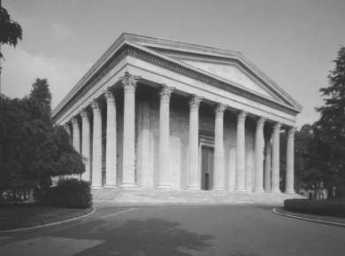 |
| Stephen Girard College Founders Hall |
In the Western part of America, Quaker meetings sometimes do have paid ministers, but the Philadelphia Yearly Meeting and it is component monthly meetings have held steadfastly to the tradition of "unprogrammed meetings"-- without ministers. Girard was not a Quaker, but he greatly admired them, and three of the five executors of his will were Quakers. It, therefore, seems likely, at a minimum, he hoped that Quaker sentiment would fortify his intended banishment of clergymen from his school for orphans, and he might well have got the basic idea from them. Quakers have long noted with disapproval that paid ministers have often publicly supported wars, and Quakers notice that governments waging wars have typically sought to stir up warlike feeling by persuading ministers to help them do so. Another behavior which is almost inherent in the clergy is for ministers to feel that they are measured by the size of the congregation they attract, and hence almost invariably proselytize for new membership. Girard had firm ideas about influencing impressionable orphans, and he did not wish to have outside ideologies capture the administration of the school. 1830 was an evangelical time, and Girard could easily imagine some highly charismatic minister captivating the school.
Other motives may, of course, be imagined. This is what is actually in the will:
Prohibiting any ecclesiastic, missionary or minister of any sect from holding or exercising any station, no such person should ever "be admitted for any purpose or as a visitor, within the premises occupied by the College...I do not mean to cast any reflection upon any sect or person whatsoever, but inasmuch as there are such a multitude of sects, and such a diversity of opinion amongst them, I desire to keep the tender minds of the orphans free from the excitements which clashing doctrines and sectarian controversy are so apt to produce." As matters were to turn out, religious meetings have been conducted by laymen almost every day at the College, and the custom grew up that the boys themselves were often called upon to conduct religious meetings. A great many graduates of Girard College eventually went on to careers in religious ministry, so it even seems likely that their experience at the school had the effect of interesting them in the ministry by giving them a taste of it.
In 1844, the numerous relatives of Stephen Girard tried to break the will. No one has seriously proposed their grievance was anything but financial. However, they sought the services of the most noted lawyer, orator, and statesman of his day, Daniel Webster. Webster would have been wise to refuse to take the case since he could think of no better argument to use than that -- the exclusion of ministers demonstrated the school for orphans was not a true charity, and only a true charity would be allowed to exclude ministers. Several days of oratory enveloped this preposterous argument, which today reads like pure bombast and humbug. The U.S. Supreme Court in time unanimously rejected his brief, with the generous comment that the law was not on his side. Other lawyers have privately remarked that such oratory was never intended to persuade a court, but to impress a rich client.
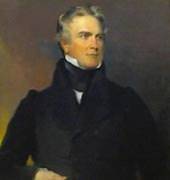 |
| Horace Binney |
Horace Binney, the lawyer son of another Horace Binney who established an enduring reputation for calmness in midst of a religious storm during the Hogan Schism, was the successful defender of Girard College. In contrast with the flowery reverberations of Webster's voice, Binney confined himself to short words in short sentences, sticking strictly to the point without appeal to emotion. In fact, one wonders why Webster stooped to it. Historians credit him for the arguments that later inspired the defenders of the Union with enough conviction to win the Civil War. Essentially, he convinced Unionists that the Constitution had not created a confederacy, but a Union, which implicitly must have all the powers needed to preserve itself. Half the nation would not accept his reasoning, however, and his willingness to proclaim nonsense in the Girard case confirmed many Southern suspicions that the Union argument was also specious. Fifteen years later, Philadelphia was quite slow in coming to the Union side, for a variety of reasons. His attacking a cherished Quaker belief in a Quaker city was certainly not useful. In time, it would be possible to hear a quiet parody of the Union's marching song, that "He died to make men holy -- we will kill to make men free."
 |
| Advice to Young Men and Boys |
It is unfortunate that the one thing most people think they know about Girard College is that religion is excluded. Far from it, there is more attention to morals and ethics than in public schools. Indeed, Girard College compares well with Phillips Exeter Academy, Webster's prep school and perhaps his model. One of the great concerns about orphans is that they may be easily led into a life of crime; there is no doubt that Girard College makes unusual efforts to keep that from happening. In fact, the school may be said to have written its own prayer book during the late 19th Century. Books of devotion were written and then organized by committees of laymen, eventually published by the Chairman, Benjamin B. Comegys. Entitled Advice to Young Men and Boys", Comegys notes that the book was published "in the hope that it may be the means of helping some boys and young men other than those to whom the Addresses were made." It would have to be observed that Girard College inspired an unusual interest in the ministry among the boys, by encouraging them to lead in the ceremonies themselves. And by having the Board of Trustees participate in the construction of books of moral principles, they no doubt similarly evoke a high sense of fidelity within the businessmen trustees. Since those entrusted with huge amounts of money are faced with huge temptations, the Trustees quite possibly need the stimulus as much as the students do.
REFERENCES
| Girard College It's Semi Centennial of Girard College: George P. Rupp ASIN: B000TNER1G | Amazon |
Fort Wilson: Philadelphia 1779
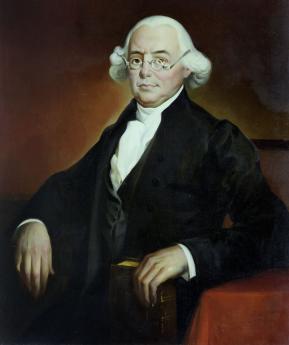
|
| James Wilson |
OCTOBER 4, 1779. The British had conquered then abandoned Philadelphia; an order was still only partially restored. Joseph Reed was President of the Continental Congress, inflation ("Not worth a Continental") was rampant, and food shortages were at near-famine levels because of self-defeating price controls. In a world turned upside down, Charles Willson Peale the painter was a leader of a radical group of admirers of Rousseau the French anarchist, called the Constitutionalist Party, leaning in the bloody direction actually followed by the French Revolution in 1789. Peale was quick to admit he had no clue what to do with his leadership position and soon resigned it in favor of painting portraits of the wealthy. Others had deserted the occupied city, and many had not yet returned. The Quakers of the city hunkered down, more or less adhering to earlier instruction from the London Yearly Meeting to stay away from any politics involving war taxes. About two hundred militia roamed the city streets making trouble for anyone they could plausibly blame for the breakdown of civil order. Philadelphia was as close to anarchy as it would ever become; the focus of anger was against the pacifist Quakers, the rich merchants, and James Wilson the lawyer.
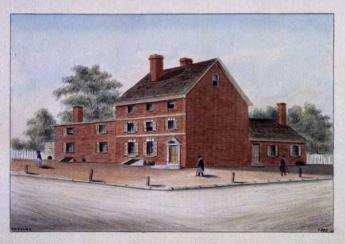
|
| Fort Wilson |
Wilson had enraged the radicals by defending Tories in court, much as John Adams got in trouble for defending British troops involved in the Boston Massacre; Ben Franklin advised Wilson to leave town. It is still possible to walk the full extent of the battle of Fort Wilson in a few minutes, and the tourist bureau has marked it out. Begin with the Quaker Meeting at Fourth and Arch. A few wandering militiamen caught Jonathan Drinker, Thomas Story, Buckridge Sims, and Matthew Johns emerging from the Quaker church, and rounded them up as prisoners. The Quakers were marched down the street for uncertain purposes when the militia encountered a group of prominent merchants emerging from the City Tavern. Unlike the meek Quakers, Robert Morris and John Cadwalader the leader of the City Troop ordered the militia to release the prisoners, behave themselves, and disperse; Timothy Matlack shouted orders. It was exactly the wrong stance to take, and about thirty prominent citizens were soon driven to retreat to the large brick house of James Wilson, at the corner of Third and Walnut, known forever afterward as Fort Wilson. Doors were barred, windows manned, and Fort Wilson was soon surrounded by an armed, shouting, mob. Lieutenant Robert Campbell leaned out a third story window and was soon dropped dead by a lucky bullet. It remains in dispute whether or not he fired first. Crowbars were sought, the back door forced open, but the angry attackers scattered after fusillades from inside.
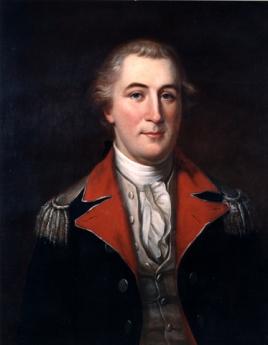
|
| Joseph Reed |
Down the street came President Reed on horseback, ordering the militia to disperse, with Timothy Matlack at his side; both men were well-known radicals, here switching sides to maintain law and order. The City Troop arrived, an order was given the cavalry to Assault Every Armed Man. The radicals were finally dispersed by this makeshift cavalry charge, cutting and slashing its way through the dazed militia. When it was over, five defenders were dead and about twenty wounded. Among the militia, the casualties were heavier but inaccurately reported. Robert Morris took James Wilson in hand and retreated to his mansion at Lemon Hill; Wilson was the founder of America's first law school. Among other defenders huddled in Fort Wilson were some of the future framers of the Constitution from Pennsylvania: General Thomas Mifflin, Wilson, Morris, George Clymer. Equally important was the deep impression left on radical leaders like Reed and Matlack, and Henry Laurens, who could see how close the whole war effort was to dissolution, for lack of firm control. Inflation continued but the center-productive price control system was abandoned and never revived; the Patriots had a bad scare, and the heedless radicals forced to confront the potentially disastrous consequences of their own amateur performance when entrusted with the power and responsibility they had just been demanding. It was one of those rare moments in a nation's history when the way suddenly opens to previously unthinkable actions.
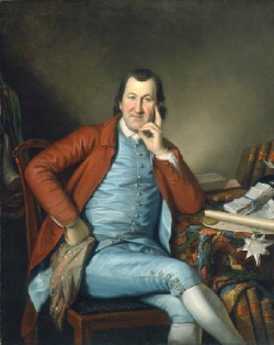
|
| Timothy Matlack |
The Battle of Fort Wilson was the only Revolutionary War battle fought within Philadelphia city limits; a revolution within a revolution, every participant was a Rebel patriot. Reed and Matlack were the two most visibly appalled by the whole uproar, forced by circumstances to attack the forces of their own political persuasion. But it seems very certain that Robert Morris and the other prosperous idealists were also left with an indelible conviction that even a confederation must maintain central command and discipline with an iron will, or all might be lost. A knowledgable French observer estimated that Robert Morris then owned assets worth eight million dollars, an almost unimaginable sum for the time. But he would lose every penny if effective political control could not be restored. A few days later in the October election, he and all the other Republican (conservative) officials lost their seats. It did not matter; Morris then knew what to do, and his opposition didn't.
Quakers and Indians
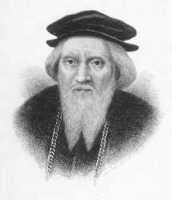
|
| John Cabot |
The concept of paganism was even extended to Protestant sects. Henry VII of England was given ownership rights to the rest of the undiscovered Western Hemisphere when John Cabot explored the coast of North America. Although matters were clouded somewhat when Henry VIII separated England from the Catholic Church, the principle of conferring undiscovered land to the first discoverer was continued under Protestant rule, and continued to include the proviso that there must be no Christian settlement if the land was to be claimed by a discoverer. This was a central element of the dispute between Lord Baltimore and William Penn over the ownership of what is now the State of Delaware. Penn acquired title to this area from the Duke of York, who had taken it from the Dutch. The argument went on for years as to whether wandering Dutch fur traders counted as Christian settlers, and therefore whether the Duke of York's title took precedence over the earlier grant of land south of the 40th parallel, given to the first Lord Baltimore by the first King Charles. What all these silly wrangles seem to prove is that ownership of land has always been a difficult and vague concept, filled with unfairness and judicial experience. The change from feudal, nomadic culture to a fixed agricultural one required that rules of ownership must be devised and held to, even though the logic and justice of them was rather easily challenged. One of the main functions of the modern state is to minimize and permanently settle boundary disputes, often with no sensible basis to work with.
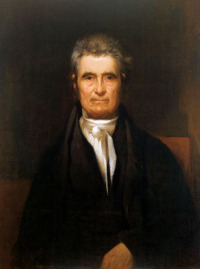
|
| Chief Justice John Marshall |
In the United States, the creation of an entirely new nation by the forcible defeat of the previous British owners became a settled matter at the Treaty of Paris in 1783. The United States owned the land within its boundaries and was within its rights to redefine or reassign property as it pleased. The fine details of relations with the native tribes were settled in 1823 by the decision of Chief Justice John Marshall in Johnson v. M'Intosh. Marshall made the clear pronouncement that the tribes lost their sovereignty at the moment of discovery. However, his meaning is less clear when he went on to say the tribes had a right of occupancy, but not a right of ownership. The passage of two hundred years under this legal concept has created a legal situation of stare decisis and a practical problem that judicial questioning of the authenticity of millions of land titles after this long interval would bring the nation close to armed rebellion.
There is also a problem pointed out by the historian Edmond Morris, that after all these years we may not entirely understand the problem we are dealing with. Although there are individual exceptions, particularly in the Quaker states and Oklahoma, there are no documented instances of any Indian tribe being assimilated. There are literally hundreds of Indian languages, reflecting tribal differences as wide as between the Aztecs and the Esquimos. And attempts to assimilate have been as varied as the Spanish attempting slavery, the French favoring intermarriage, the English trying boarding schools for Indian children. But in five hundred years of colonization, the amount of assimilation has been trivial. Even the discovery of oil and the establishment of gambling casinos have created pockets of real wealth among the native Americans without any great sign of a willingness to assimilate. Looking backward, it would appear that five hundred years of experience were based on the assumption that the Indians would surely see the superiority of our culture, and wish to adopt it. For reasons no one understands, that premise does not seem to be correct and is certainly an arrogant one. But North America is now largely settled from ocean to ocean; to go back to dual existence, dual cultures in the school system, dual legal systems intermingled -- and dual sovereignty -- does not have the sound of a practical, peaceful solution to what is clearly a mixture of injustice and blundering.
Too Much Money
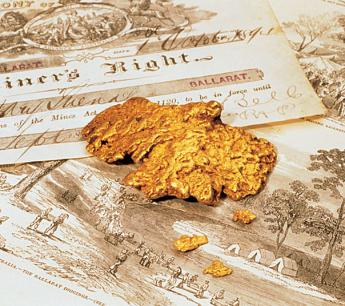
|
| The Gold Rush |
Globalization may well have created a thousand billionaires, but its benefits to poor people were greater. As a guess, five hundred million desperately poor people were lifted out of poverty, and eventually, it may be several billion. For certainty, we will soon need a new definition of poverty, which only a few years ago was to subsist on less than a dollar a day. Rich or poor, these lucky people were not the objects of charity, but the visible beneficiaries of enormous wealth creation, surely the greatest gold rush in human history.
If they buy guns and bombs (or narcotics) with their new money, we may not be so happy about its unintended consequences. So far, however, the major unintended consequences have been benign upheavals, like the rapid spread of the computer and internet revolutions, the extension of life expectancy and literacy. These reasonably benign side-revolutions have bounced back as accelerators of the boom. The unit cost of transactions has plummeted; nerdy mathematicians have advanced into the murky mist of derivatives. No one doubted self-seeking bosses would abuse the extraordinary insights of their intellectual superiors, and they did, indeed. It's probably true that wise observers predicted this would all end in tears. And it did.

|
| Credit Default Swaps |
We are now in the midst of the usual witch-hunt for perpetrators because we have a national election every four years. Both political parties are planning to spend a billion dollars accusing each other, so the accusations will surely get louder before they calm down. But in the spirit of directing the anger toward more productive targets, it should be remembered that harm to the public usually originates as incompetence, rather than greed. About five years before the crash, for example, I found myself adrift in a convention of bank officers. Within fifteen minutes, I satisfied myself that not one vice-president in the room could offer a coherent definition of a derivative. The general public still cannot define it, but everybody thinks he can recognize greed: it's someone with more money than you have. A few weeks before the initial crash in August 2007, I was made aware that things called Credit Default Swaps were in circulation in the amount of twenty-five trillion dollars. It was impossible for me to find anyone or any search engine which could tell me what these confounded CDS things were, even though their quantity exceeded what I understood to be the national debt of the United States. And their quantity was doubling every few months. A few months later, indeed, it was made clear that the national debt was far larger than anyone thought. There's a great temptation in a situation like this to demand that Congress pass a law to slow things down. Yes, and while they are at it, they might as well sweep back the ocean with a broom.
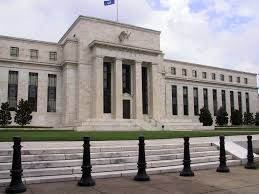
|
| Federal Reserve |
To a certain extent, the recent cluelessness of banks has to do with expanding their size, computerizing the deposit and payments systems, and reducing the average branch bank to a single manager with either computers or new hires to help him. The information you need is available, but often in the home office a thousand miles away. Changes of this sort are hard to keep up with, and the bank officers dislike it, too. But the plaintive defense was recently given to a Committee of Congress, seen on television. "As long as the music keeps playing, we have to keep dancing."
Over in the investment banks, there are hundreds of very smart, very aggressive young fellows sitting at desks crowded together with three electronic monitors apiece, talking excitedly on the phones with their new best friends in foreign countries. Their job is not to know everything, but to know how to do something, and perform it very rapidly. Much of their knowledgable talk is just bluffing; no one is sure what the other fellow knows. They all know the situation can't last; perhaps they can get promoted before some changed premise catches up with them. This isn't exactly greed, it's called high pressure. At any unexpected moment, that guy over in the corner office can come out and say, "You are all, all of you, fired as of this moment." It probably isn't his fault, either.
The fundamental situation is that depository institutions are being squeezed by technological change and the blameless fact that investment banks can substitute their services at a lower cost because the money is accumulated by selling bonds in large denominations. The depository banks must try to accumulate deposits one by one in a recession, with interest rates held low for macroeconomic reasons dictated by the Federal Reserve. To level the playing field, depository banks have access to deposit insurance, which tempts them into high-risk lending. Nobody can get hurt when it's all insured, Right? Every once in a while someone sends cold chills down the depository bank spine by calling for the abolition of deposit insurance, on the grounds that it promotes moral hazard. On the other hand, the investment banks are lobbying heavily to have deposit insurance extended to them, and they may well get it for their money market funds. This is all a pretty artificial controversy. The problem isn't evil, or deposit insurance, or being too big to fail. It's the nature of the struggle. Two different ways have been chosen to assemble capital. When one of them wins, the other knows it will die.
Let's not confuse this any further. The point of the discussion is to convey the immense pressure being placed on every mini pixel of the financial system, by a gold rush taking advantage of the changes wrought by the globalization of the world economy. Somewhere, a bubble will appear. It happened to be in real estate, as it often is in money panics. And if a bubble grows, somebody will pop it. Is it all his fault, too?
Keats, Symmetry, and Quakers
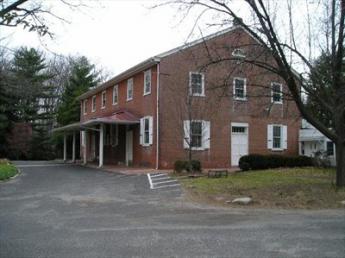
|
| Haddonfield Meeting |
"Truth is beauty, beauty truth. That is all ye know and all ye need to know. " The nice lady delivered her message in the Haddonfield Meeting for worship, not long ago. Standing at her bench in the otherwise quiet room. In a few minutes, another member echoed the thought, but I was too taken with the novelty of it to add to the carillon of Quaker responses. The meeting went on to other things, the Service Committee I believe, and then the meeting ended.
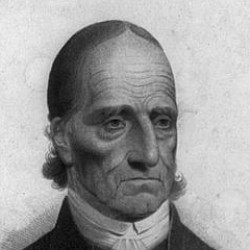
|
| Elias Hicks |
The early Friends, it must be recalled, were plain. Reacting adversely to the fancy dresses and high hairdos of the Romantic period, they would not have their own portraits painted or tombstones on their graves. They did not use the word, but they were utilitarian, admiring a plain way of doing things that made the world a better place to live. Beauty in the classical sense was not something they hated, but it was certainly a thing that used up time and money that might have had better uses. Philadelphia had some theaters and portrait painters, even some sculptors, but with the exception of Elias Hicks, they were almost all Episcopalians. For a century after plain Quaker speech and plain Quaker dress had become curiosities, Philadelphia lagged behind as a center of the arts. Arts and science gradually took over the town, but Quakers were mostly busy with other things when the arts were on display. Science was, of course, a different matter.
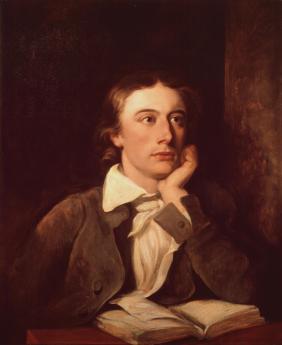
|
| John Keats |
My own experiences as a schoolboy were quite different. English classes, in particular, were all about poetry and simple novels from the Romantic period. I recognized Keats immediately when the lady quoted him. And so it was easy for me to imagine how Romantics of the Federalist period felt about truth and beauty; beauty was all there is. It's the truth. It's a classical style. The British had a fling with Romance literature, but the French really took it up. It was the essence of the French Revolution, particularly after they stopped chopping off the heads of aristocrats and fell under the spell of Napoleon. There was something Romantic about war, especially wars of Revolutionary zeal; cavalry charges and gallantry of all sorts. Quakers did not hold with war, and never had a lot of enthusiasm for our own Revolution. In fact, it was during this era that Quakers withdrew from political power, rather than participate in war, let alone lead in it. Now Jefferson saw things differently; although he was never a soldier, he liked the classics and he admired the Romantics. Whether it was the association with war and gallantry or not, classical architecture became something they studied in the Quaker Colleges, Bryn Mawr in particular, but it had too much aristocracy, pomp, and circumstance, to spill over into their houses and places of business.

|
| Professor Ian Stewart |
If Truth is Beauty, then anyone who likes truth has got to like beauty, right? The original name for Quakers was Friends of the Truth. Beauty is symmetry, according to Professor Ian Stewart. Does all this mean that beauty is anything but passably tolerable? Or maybe Truth is beauty and that's all you need to know. Personally, I rather doubt it.
International Law
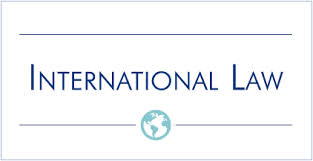
|
| International Law |
Let no one suppose I imagine myself an expert in international law. But as a member of a family with newspaper connections, I more readily recognize when someone is conducting a campaign, using a set of plausible arguments in place of the real ones. So, my suspicions are repeatedly reinforced by regular repetitions of the same arguments in different ways, to the effect that America should be more respectful of what is called International Law. Curiously, the same people are of a mindset to oppose European Union, when you would suppose that one argument leads to the other. It is almost a pose that, having won the war as legitimate sovereigns, they are already quashing would-be competitors.
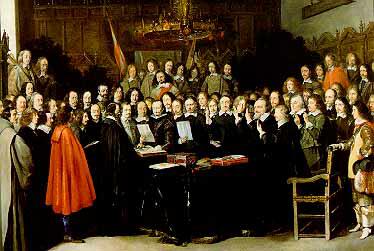
|
| Treaty of Westphalia |
Nationalism had its formal beginnings in the Treaty of Westphalia, about 1648. At that time, there were about a hundred little countries along the banks of the Rhine River, starting in Switzerland which was broken into four cantons, and south of the Swiss stretching the length of Italy, ending up in the far tip of Sicily. Many of these nations were no bigger than a golf course and were often leftovers from the robber barons who extorted bribes from passing boats in return for not attacking them. That is, they were protection rackets, which survived as rackets in the far tip of Sicily until 1880 or so, until Garibaldi emancipated them from their evil ways, and unified Italy.
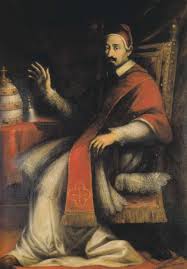
|
| Pope Alexander VII |
In 1648 the Pope was in nominal charge of everything, and all the rest of the Rhineland behaved the way we now think of the Mafia as behaving, in secret societies. Martin Luther's Protestant Reformation had broken the Holy Roman Empire into warring camps, shifting alliances as local politics required. It took a long time to get everyone into an agreement, but the outcome was the Treaty of Westphalia, which essentially made everyone agree to respect the national boundaries of the others, and the religion of the inhabitants of each country would adopt the religion of the local king. There had been nations before there was nationalism, but the Westphalian version operated with national boundaries as the defined beginning, rather than tribes, languages or religions. That sort of agreement displeased the Pope, of course, but it had the utility of lessening the endless warfare and pillage, each one of each other. Offhand, you might not have thought of boundaries as superior to ethnic inhabitants as an organizing principle, but somehow it worked better than the alternatives. Nationalism became the ruling premise throughout the world. If you win, your winnings are limited to the established boundaries. The treaty of Westphalia served essentially as the constitution for a majority of western civilizations, and it was pretty short and sweet, essentially downgrading religion as an organizing principle and replacing it with defensible boundaries, seemingly a degrading change.
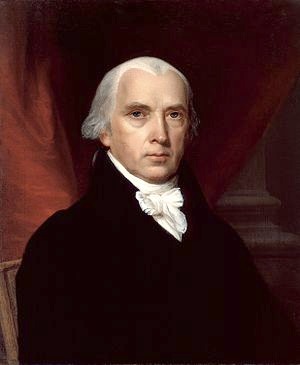
|
| James Madison |
Eventually, thirteen "sovereign nations" in the Western Hemisphere got together and wrote our new Constitution, which had an additional novelty of being written down and describing how the new United States would be organized. Religion was banished from governance, of course, so the way was open to our own nationalism. Among other features was a bicameral legislature. Pennsylvania in 1787 had just had a lot of trouble with a unicameral legislature, but the main impetus opposing that format was found in the small states. John Dickinson of Dover Delaware drew a startled James Madison of Virginia aside and told him the small states didn't like being bossed by the big ones (Virginia was the largest, at that time), and they particularly disliked the idea that it would be written down as a permanent arrangement. In the view of the big states, power would naturally go to the biggest and richest, and that infuriated the small states even more. To them, it meant the small states were expected to pay permanent deference to the ideas of their bigger neighbors, and for example, no one from a small state could ever expect to be elected President. Dickinson drew Madison aside and asked, "Do you want to have a Union, or don't you?" Dickinson was probably thinking in terms of equal representation for each state, no matter its size, while Madison was thinking of proportional representation like the House of Representatives. Rumor has it that Benjamin Franklin gathered folks into the City Tavern and worked out the present compromise. Which is, a bicameral legislature, one body with two and only two Senators per state, the second body with additional representatives for more population, and the overall agreement that no law would be passed without the agreement of both houses of Congress. Pretty simple, but it has gradually dawned on most people that the United State has held together (Civil War excepted) for two hundred years by debate and compromise, but meanwhile no other union has survived by any means except military force. Underneath that rule must be an assumption: for every quarrel, somewhere there exists a workable compromise. Even Ben Franklin was a little hesitant about that idea.
The League of Nations, United Nations, and all of the other national groupings, so far including even the European Union, have unicameral legislatures which follow the traditions of the Treaty of Westphalia. Equal representation for all, and therefore majority rule is expected to leave major groups nursing a grudge. In a bicameral state with different rules for election, the ruling instruction is "Don't you come out of that room until you agree on some compromise which will endure." A bicameral legislature is expected to produce flawed legislation; a unicameral body is expected to produce a victory. Therefore, a unicameral is expected to produce a vanquished foe; a bicameral needs cooperation to justify flawed legislation and keep it workable. As things work out, there is no perfect law, only laws which are more or less imperfect.
"On the whole, sir, I can not help expressing a wish that every member of the convention who may still have objections to it, would, with me, on this occasion, doubt a little of his own infallibility, and, to make manifest our unanimity, put his name to this instrument."
Honoring the Fallen
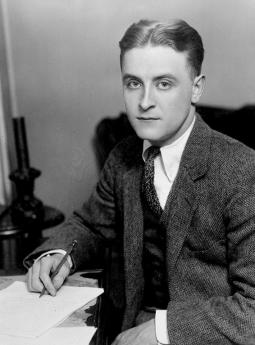
|
| F. Scott Fitzgerald |
The roarin' Twenties, just after the First World War, were a time when we seemed to change conventional attitudes about Society. But in many ways, the convulsive changes of the Twenties were merely a process of facing up to what we already knew. In retrospect, many of the deeply emotional conflicts of that time, now seem entirely bearable. Scott Fitzgerald's most ponderous statement, the one that says "The test of a first-rate intelligence is the ability to hold two opposing ideas in mind at the same time and still retain the ability to function," reduces itself to the trivial agonies of loving two girls at a time, or choosing to stop smoking when you always knew you shouldn't start. Just about the only instance, I can think of, where two deeply loved Philadelphia institutions are in seriously troubling conflict, are the First City Troop, and Quakerism. The matter came to mind at the Right Angle Club, when a Philadelphia Trooper who simply radiated the honorable dedications of upper-class Philadelphia gentlemen, meekly described his dedication to restoring the crumbling monuments of bravely fallen comrades. The monuments he finds and restores at great personal expense are not merely warring heroes, although one suspects that is the root of it. The gravestones and monuments crumbling in the dust are markers of heroes of our civilization generally. But we do forget what we owe them and neglect their monuments.
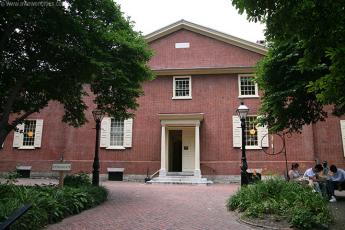
|
| Fourth Street Meetinghouse |
Although the dominant Quakers of Philadelphia's early days are now reduced to a handful of practicing believers, almost every educated Philadelphian knows those beliefs pretty well. The early Friends did not even sympathize with carving their names on their tombstones. If you visit the Fourth Street Meetinghouse, you will be told that forty thousand bodies have been buried on the grounds, but only two graves have tombstones. The worship of grave markers, you will softly be told, is idolatry. The goal of a funeral should not be to mourn death but to celebrate a life well-lived. And although the custom of gravestones has reasserted itself, it does not take long to be gently reminded that keeping alive the memories of one war's atrocities, can eventually lead to more wars. We recently have seen wars in Bosnia and Kosovo being fought over Thirteenth Century grievances which might better be forgotten. Some of this comes from immigration over three thousand miles of ocean, but the effect is the same. I have no idea even what nationality my own 13th Century ancestors might have fought for, and I doubt if the world would be improved if I found out and sought to wreak vengeance for the inevitable atrocities.
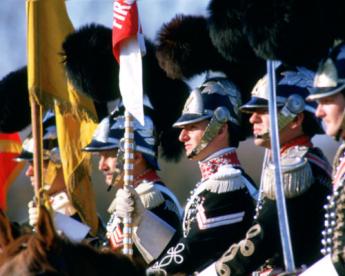
|
| Philadelphia First City Troop |
But unless one is determined to denounce anything at all admirable about everything our society does to defend itself -- and there are some who go that far -- it is necessary to make a sad concession to force in successful governance. The 18th Century Quakers perhaps seldom acknowledged the need for occasional force as a condition for leadership, but they watched their children drift away from the religion, once they absorbed the lesson. Even those who choose conscientious objection for themselves must occasionally acknowledge the debt they owe to those who do answer the call of force and knowingly fail to survive it.
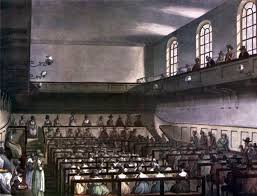
|
| Society of Friends |
There simply is no choice but to honor both sides of this issue, both permanently and side by side. There are some who can't, and in various ways fail to retain the ability to function. As in many of his more juvenile pronouncements, Fitzgerald does go much too far with assessing all the rest of Philadelphia as having less than first-rate intelligence. Philadelphians generally have at least a taste of the experience of holding these two opposing ideas-- the City Troop and the Society of Friends -- in mind at the same time, with approval for both. And generally seeming somewhat improved for having made the struggle.
"Sir"
In 1938 when I was 14 years old, I entered a new virtual country with its own virtual language. That is, I went to an all-male boarding school during the deepest part of the worst depression the country ever had.
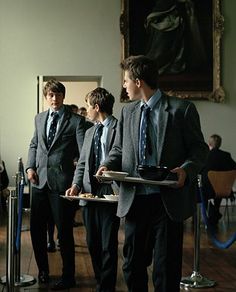
|
| Boarding School |
identified While it should be noted I had a scholarship, there is little doubt I was anxious to learn and emulate the customs of the world I had entered. My life-long characteristic of rebellion was born here, but at first, it evoked a futile attempt to imitate. Not to challenge, but to adopt what I could afford to adopt. The afford part was a real one because the advance instructions for new boys announced a jacket and tie were required at all meals and classes, and a dark blue suit with a white shirt for Sunday chapel. That's exactly what I arrived with, and let me tell you my green suit and brown tie were pretty well worn out by the first Christmas when I came home on the train for ten days vacation, the first opportunity to demand new clothes. First-year students were identified by requiring a black cap outdoors, and never, ever, walking on the grass. The penalty for not obeying the "rhine" rules was to carry a brick around, and if discovered without a brick, to carry two bricks. But that's not what I am centered on, right now. The thing which really bothered me was unwritten, equally peer-pressured by my fellow students, the custom of addressing all my teachers as Sir. The other rules only applied until the first Christmas vacation, but the unwritten Sir rule proved to be life-long.
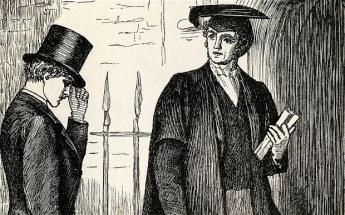
|
| Sir |
And it was complicated. It was Sir, as an introduction to a question, not SIR!, as a sign of disagreement. You were to use this as an introduction to a request for teaching, not as any sort of rebuke or resistance. Present-day students will be interested to know that every one of my teachers was a man; my recollection is, except for the Headmaster's secretary, the Nurse was the only other female employee. The average class size was seven. Seven boys and a master. Each session of classes was preceded by an hour of homework, the assignment for which was posted outside a classroom containing a large oval maple table. Needless to say, the masters all wore a jacket and tie, most of the finest style and workmanship. They always knew your name, and always called on every student for answers, every day. Masters relaxed a little bit during the two daily hours of required exercise, when they took off their ties and became the coaches, but were just as formal the following day in class. I had been at the head of the class of what Time Magazine called the finest public high school in America, but I nearly flunked out of the first semester in this boarding school. It was much tougher at this private school than I felt any school had a right to be, but they really meant it. Over and over, the Headmaster in the pulpit intoned, "Of those to whom much is given, much is expected."
I had some new-boy fumbles. Arriving a day early, I found myself with only a giant and a dwarf for a company at the dining table. I assumed the giant was a teacher, but he was a star on the varsity football team. And I assumed the dwarf was a student, but he was assistant housemaster. One was to become a buddy, the other a disciplinarian, but I had them reversed, calling the student "Sir", but the master by his first name. Bad mistake, which I have been reminded of, at numerous reunions since then.

|
| Yale |
When I later got to Yale, I began to see the rules behind the "Sir," rule. In the first place, all of the boarding school graduates used it, and none of the public school graduates, although many of the public school alumni began, falteringly, to imitate it. Without realizing it, a three-year habit had turned out to be a way of announcing a boarding school education. The effect on the professors was interesting; they rather liked it, so it was reinforced. It had another significance, that the graduates who said "Sir" acquired upper-class practices, the red-brick fellows seldom did. The only time I can remember it's being scorned was eight years later, by a Viennese medical professor with a thick accent, and he was obviously puzzled by the significance. Hereditary aristocracy, perhaps. Indeed, I remember clearly the first time I was addressed as Sir. I was an unpaid hospital intern, but the medical students of one of the hospital's two medical schools flattered me with the term. In retrospect, I can see it was a way of announcing that graduates of their medical school knew what it meant, while the other medical school was just red-brick. Although the latter had mostly graduated from red-brick colleges, their medical school aspired to be Ivy League.
If you traveled in Ivy League circles, the Sir convention was pretty universal until 1965, when going to school tieless reached almost all college faculties, thus extending permission to students to imitate them. Perhaps this had to do with co-education, since the sir tradition was never very strong in women's colleges, and denounced by the girls when the men's colleges went co-ed. Perhaps it had to do with the SAT test replacing school background as the major selection factor for admission. Perhaps it was the influx of central European students, children of European graduates for whom an anti-aristocratic posture was traditional, and until they came to America, largely futile. Perhaps it was economic. The American balance of trade had been positive for many decades before 1965; afterward, the balance of trade has been steadily negative.
In Shakespeare's day, "Sirrah" was a slur about persons of inferior status. In Boswell's eighteenth Century day, his Life of Johnson immortalized his characteristic put-down with a one-liner. It survives today as a virtually text-book description of how to dominate an argument at a boardroom dispute. "Why, Sir," was and remains a signal that you, you ninny, are about to be defeated with a quip. It's a curious revival of a new way of immortalizing small-group domination, and a very effective one at that, which even the soft-spoken Quakers use effectively. Whatever, whatever.
The 90-plus years of tradition of addressing your professor as "Sir," is gone, probably for good, except among those for whom it is a deeply ingrained habit. Along with the tradition of female high school teachers, followed I suppose by male college professors.
| Posted by: services | May 10, 2012 1:52 AM |
66 Blogs
Henry Cadbury Dresses Up for the King
 What should a plain-speech Quaker wear to the ceremony, if the King of Sweden is giving him the Nobel Prize?
What should a plain-speech Quaker wear to the ceremony, if the King of Sweden is giving him the Nobel Prize?
Slavery: If This be done well, What is done evil?
 Philadelphia German Quakers were the first to protest the evils of slavery.
Philadelphia German Quakers were the first to protest the evils of slavery.
International Visitors Council
 The International Visitors Council does a great job welcoming visitors from abroad.
The International Visitors Council does a great job welcoming visitors from abroad.
John Woolman Reports on Yearly Meeting, 1758
 At a time when the whole world thought slavery was perfectly natural, John Woolman brought the Philadelphia Yearly Meeting to declare it must be abolished.
At a time when the whole world thought slavery was perfectly natural, John Woolman brought the Philadelphia Yearly Meeting to declare it must be abolished.
Jury Nullification
 William Penn demonstrated one of the most incisive legal minds in England by trapping the British courts in what remains a central unresolved dilemma for the law. He was the defendant in his own case. By the South's way of looking at things, it was a pacifist effort to restrain mindless abolitionism. Meanwhile, both sides calculated it would win if the South decided to fight.
William Penn demonstrated one of the most incisive legal minds in England by trapping the British courts in what remains a central unresolved dilemma for the law. He was the defendant in his own case. By the South's way of looking at things, it was a pacifist effort to restrain mindless abolitionism. Meanwhile, both sides calculated it would win if the South decided to fight.
North of Market
 This old local expression originally pointed to where the Quakers live on Arch Street, but over the centuries has taken on a lot of less flattering associations.
This old local expression originally pointed to where the Quakers live on Arch Street, but over the centuries has taken on a lot of less flattering associations.
Pennyslvania's Boundary: David Rittenhouse, Hero, Lord Baltimore, Villain
 Because a local genius invented and perfected surveying instruments, America is one of the few nations in the world with straight-line boundaries.
Because a local genius invented and perfected surveying instruments, America is one of the few nations in the world with straight-line boundaries.
Edward Hicks: Peaceable Kingdoms
 This uneducated Bucks County farm boy has steadily risen in reputation as a painter of primitive art, just as he and his cousin have become spiritual leaders of non-dogmatic religious thought.
This uneducated Bucks County farm boy has steadily risen in reputation as a painter of primitive art, just as he and his cousin have become spiritual leaders of non-dogmatic religious thought.
Quaker Investment Committee
 Quakers expect results from their investment managers, not just Wall Street gossip.
Quakers expect results from their investment managers, not just Wall Street gossip.
Quakers From the Indian Point of View
 The Iroquois were fierce warriors, but they could see they would need better education to survive in a new world.
The Iroquois were fierce warriors, but they could see they would need better education to survive in a new world.
Rufus Jones, Quaker
 Rufus Jones dominated the Quaker religion for two generations, bringing unity out of disunity, and creating some towering institutions in the process
Rufus Jones dominated the Quaker religion for two generations, bringing unity out of disunity, and creating some towering institutions in the process
Silence Connotes Assent: Only To Quakers
 Quakers seek consensus, but try not to be intimidated by it. You get a lot accomplished at a meeting where agreement is assumed unless disagreement is voiced.
Quakers seek consensus, but try not to be intimidated by it. You get a lot accomplished at a meeting where agreement is assumed unless disagreement is voiced.
Slaveowning Quaker Steps Up To The Plate
 Slaves were valuable property, but it became a Quaker duty to give them their freedom. John Woolman, who started the idea, suggested freeing them in your will.
Slaves were valuable property, but it became a Quaker duty to give them their freedom. John Woolman, who started the idea, suggested freeing them in your will.
The Definition of a Real Philadelphian (1914)

The Naming of Pennsylvania
 King Charles gave Penn as much land as the whole of England, and named it after William Penn
King Charles gave Penn as much land as the whole of England, and named it after William Penn
The Schools of School House Lane
 Exclusive privates schools and colleges are usually to be found in isolated rural settings. But our oldest, best, and most famous schools are clustered together in a neighborhood that is far from exclusive.
Exclusive privates schools and colleges are usually to be found in isolated rural settings. But our oldest, best, and most famous schools are clustered together in a neighborhood that is far from exclusive.
Quakers Turn Their Backs on Power
During the French and Indian War, the Quakers who ruled Pennsylvania were forced to choose between political power and peaceful principles. They withdrew from power.
Keeping Lunaticks Off the Streets
Free Quaker Meetinghouse
 It's only open a few days each year, but the red brick building at 5th and Arch was the meeting house for those few Quakers, including Betsy Ross, who fought for the Revolution. The Park Service has made a beautiful restoration, which deserves to be seen by more people.
It's only open a few days each year, but the red brick building at 5th and Arch was the meeting house for those few Quakers, including Betsy Ross, who fought for the Revolution. The Park Service has made a beautiful restoration, which deserves to be seen by more people.
The No-Doctrine Doctrine
 The doctrine of Quakerism is to have no doctrine. It has provoked two main schisms in the church; George Keith making a plea for at least some doctrine, Elias Hicks leading a later move back to simplicity.
The doctrine of Quakerism is to have no doctrine. It has provoked two main schisms in the church; George Keith making a plea for at least some doctrine, Elias Hicks leading a later move back to simplicity.
The American Friends Service Committee
 Bravery in the face of danger, both physical and social, underlies the enormous international prestige of this remarkable Quaker relief organization. Many of its achievements defy all comparison.
Bravery in the face of danger, both physical and social, underlies the enormous international prestige of this remarkable Quaker relief organization. Many of its achievements defy all comparison.
Swarthmore College

Quaker Doctrine and Schism
 Without a written doctrine, outsiders get a glimpse of Quaker belief from what they think is worth arguing over.
Without a written doctrine, outsiders get a glimpse of Quaker belief from what they think is worth arguing over.
Politics of the French and Indian War
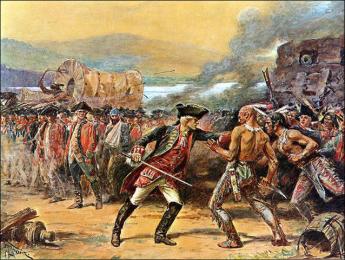
Plain Speech
 A visit to a neighboring city.
A visit to a neighboring city.
Philadelphia and Japan
 Sea faring Philadelphia was early in the opening of Japan. There is a long history of affection with the Japanese and their culture, possibly related to the understated architecture and dress, and the strong code of honor.
Sea faring Philadelphia was early in the opening of Japan. There is a long history of affection with the Japanese and their culture, possibly related to the understated architecture and dress, and the strong code of honor.
Friends Lifecare at Home
 Philadelphia Quakers run over twenty retirement communities for the elderly in their region. One of them is a virtual village, one without walls.
Philadelphia Quakers run over twenty retirement communities for the elderly in their region. One of them is a virtual village, one without walls.
The Walking Purchase
 Quaker treatment of the Indians had been exemplary before 1737 and has been highly sympathetic ever since then, too. However, James Logan totally destroyed the trust of the Delaware Indians by using hired runners to establish boundaries of the Walking Purchase, north of the Neshaminy Creek.
Quaker treatment of the Indians had been exemplary before 1737 and has been highly sympathetic ever since then, too. However, James Logan totally destroyed the trust of the Delaware Indians by using hired runners to establish boundaries of the Walking Purchase, north of the Neshaminy Creek.
Benjamin Franklin: Chronology
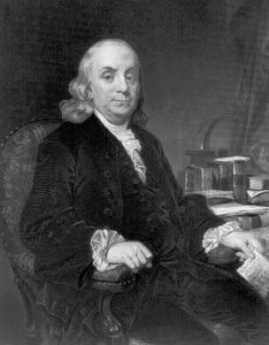 Franklin retired at age 42, and spent the other half of his life in public service. Only fifteen years of that career was spent in America. His timing was good, however; he was here for the French and Indian War, the Declaration of Independence, and the Constitutional Convention.
Franklin retired at age 42, and spent the other half of his life in public service. Only fifteen years of that career was spent in America. His timing was good, however; he was here for the French and Indian War, the Declaration of Independence, and the Constitutional Convention.
Logan, Franklin, Library
 James Logan and Benjamin Franklin were at the opposite ends of the social scale in Colonial Philadelphia and were to adopt strongly differing political views. But each recognized the intellectual power of the other, and they were fast friends.
James Logan and Benjamin Franklin were at the opposite ends of the social scale in Colonial Philadelphia and were to adopt strongly differing political views. But each recognized the intellectual power of the other, and they were fast friends.
Quaker Gray Turns Quaker Green
 Quakers mean to turn their headquarters near Philadelphia City Hall into a glowing example of how to save money while they save their environment.
Quakers mean to turn their headquarters near Philadelphia City Hall into a glowing example of how to save money while they save their environment.
Unexpected Benefits of a Lurid Past
 The legal prohibition of liquor caused corruption of society which was worse, and lasted longer, than the problems it might have solved. Here and there, some surprising advantages lasted a long time, too.
The legal prohibition of liquor caused corruption of society which was worse, and lasted longer, than the problems it might have solved. Here and there, some surprising advantages lasted a long time, too.
Quakerism and the Industrial Revolution
 The Industrial Revolution extended over two centuries and was more important than all the wars, governments, and agitations of its time. Quakerism began at the same time, in the same place. Was that only coincidence?.
The Industrial Revolution extended over two centuries and was more important than all the wars, governments, and agitations of its time. Quakerism began at the same time, in the same place. Was that only coincidence?.
Pennsylvania Prison Society
 When the British monarchy put William Penn in jail, they set in motion a social movement which has changed prison management more than it changed Penn.
When the British monarchy put William Penn in jail, they set in motion a social movement which has changed prison management more than it changed Penn.
Fernery
 Around 1840, there was a brief worldwide craze for ferns, related to the exciting discovery of their complicated reproductive process. Only one Victorian fernery still exists in North America, at the Morris Arboretum in Philadelphia.
Around 1840, there was a brief worldwide craze for ferns, related to the exciting discovery of their complicated reproductive process. Only one Victorian fernery still exists in North America, at the Morris Arboretum in Philadelphia.
Quaker Efficiency Expert: Frederick Winslow Taylor 1856-1915
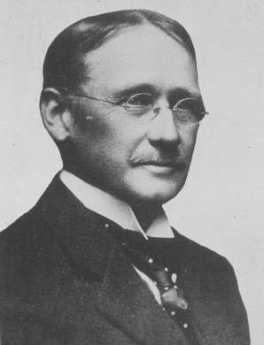 A rich Germantown Quaker boy became the world's symbol of the efficiency expert with a stop-watch, hated by Labor Unions but admired by Lenin and Stalin. He enriched the Midvale Steel Company with his invention of high-speed steel but was fired by Bethlehem Steel for eliminating too many employs. 000..0ees. Peter Drucker placed him in the class of innovators beside Darwin and Freud.
A rich Germantown Quaker boy became the world's symbol of the efficiency expert with a stop-watch, hated by Labor Unions but admired by Lenin and Stalin. He enriched the Midvale Steel Company with his invention of high-speed steel but was fired by Bethlehem Steel for eliminating too many employs. 000..0ees. Peter Drucker placed him in the class of innovators beside Darwin and Freud.
Gardening Survives
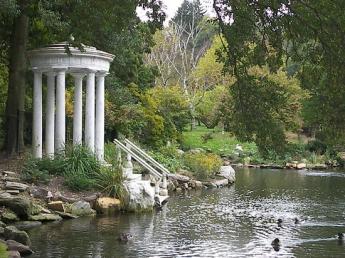 A new book has arrived, describing the 90 great public gardens of the Philadelphia regions, and discussing the best 40 of them in detail.
A new book has arrived, describing the 90 great public gardens of the Philadelphia regions, and discussing the best 40 of them in detail.
July 4, 1776: Patients in the Pennsylvania Hospital on Independence Day
Patients in Pennsylvania Hospital on Independence Day, 1776.
Nation's First Hospital, 1751-2016
 The nation's oldest hospital changed more from 1948 to 2016 than it did from July 4. 1776 to 1948.
The nation's oldest hospital changed more from 1948 to 2016 than it did from July 4. 1776 to 1948.
Volunteerism Needs a Business Plan
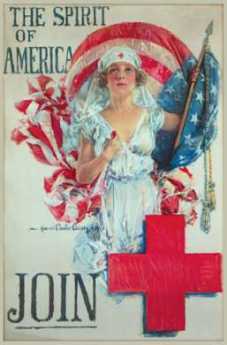 Volunteerism has declined in recent years because of conflicting demands made by gainful employment. The spirit of volunteerism has not diminished, it just needs a different business plan.
Volunteerism has declined in recent years because of conflicting demands made by gainful employment. The spirit of volunteerism has not diminished, it just needs a different business plan.
Line Dividing East from West Jersey
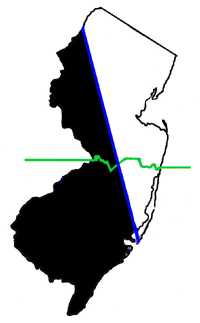 Although England had owned New Jersey for 17 years, it was unsettled until purchased by Quakers. By 1684 ownership was totally in the hands of two Proprietorships, or corporations, of Quakers. The boundary separating East from West Jersey was a line of 150 boulders from Beach Haven to Trenton. Every land title in the state is based on this survey.
Although England had owned New Jersey for 17 years, it was unsettled until purchased by Quakers. By 1684 ownership was totally in the hands of two Proprietorships, or corporations, of Quakers. The boundary separating East from West Jersey was a line of 150 boulders from Beach Haven to Trenton. Every land title in the state is based on this survey.
Concessions and Agreements
 Most 17th Century colonies were proprietorships, requiring agreements for local autonomy without losing allegiance to the home country. William Penn cleverly expanded the New Jersey document into the intellectual precursor of the U.S. Constitution.
Most 17th Century colonies were proprietorships, requiring agreements for local autonomy without losing allegiance to the home country. William Penn cleverly expanded the New Jersey document into the intellectual precursor of the U.S. Constitution.
Burlington County, NJ

Hidden River
In season, and for benefits, cruises of the Schuylkill are starting to be available at the Walnut Street dock. Go down the stairs at 24th Street.
Quaker Carillon
 In an unprogrammed Quaker meeting, respectful pauses between messages should be long enough to form a "gathered opinion". Not too long, of course, or lacking some external signal of what the subject is. Gathered meetings and fragmented ones may sound alike to strangers, but little signals that others are listening can be found in the intervals of silence.
In an unprogrammed Quaker meeting, respectful pauses between messages should be long enough to form a "gathered opinion". Not too long, of course, or lacking some external signal of what the subject is. Gathered meetings and fragmented ones may sound alike to strangers, but little signals that others are listening can be found in the intervals of silence.
Mississippi Carillons
 The two ends of the Mississippi River illustrate musical timing and harmony, with wider implications for Quaker meetings for worship if you search for them.
The two ends of the Mississippi River illustrate musical timing and harmony, with wider implications for Quaker meetings for worship if you search for them.
Mercantilism Dies Hard
 Diplomacy has been described as war by other means. It's possible to regard both war and diplomacy as economics by other means, a general attitude called mercantilism.
Diplomacy has been described as war by other means. It's possible to regard both war and diplomacy as economics by other means, a general attitude called mercantilism.
The Whole Town as a Retirement Center
Why not just stay where you are?
Robert Barclay Justifies Quaker Meetings
 Robert Barclay, one of the handfuls of English philosophers of enduring note, came close to establishing the doctrines of the Quaker Church, a religion with no formal doctrine.
Robert Barclay, one of the handfuls of English philosophers of enduring note, came close to establishing the doctrines of the Quaker Church, a religion with no formal doctrine.
First Amendment: Separation of Church and State
 Eleven of the original thirteen colonies had,"established" religions. The separation of church and state by the First Amendment was not a statement of fact, but a worrisome departure from the past, mostly prompted by the behavior of the Virginia Episcopalians. For the Pennsylvania Quakers, disestablishment was a most disheartening event.
Eleven of the original thirteen colonies had,"established" religions. The separation of church and state by the First Amendment was not a statement of fact, but a worrisome departure from the past, mostly prompted by the behavior of the Virginia Episcopalians. For the Pennsylvania Quakers, disestablishment was a most disheartening event.
Puritan Boston & Quaker Philadelphia
 The University of Pennsylvania Sociology professor E. Digby Baltzell drew attention to the strong persistence of earlier elite influences, using Philadelphia's Quakers and Boston's Puritans as prime examples.
The University of Pennsylvania Sociology professor E. Digby Baltzell drew attention to the strong persistence of earlier elite influences, using Philadelphia's Quakers and Boston's Puritans as prime examples.
William Penn, Excellent Lawyer, Terrible Businessman
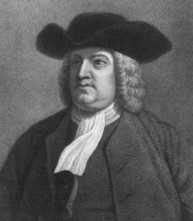 William Penn was the central force in the establishment of a religion, Quakerism, certain central features of the legal system, three colonies of America, and many of the central concepts of Constitutional Law. He leaves us over three thousand documents, but it remains very hard to form a picture of what he was like.
William Penn was the central force in the establishment of a religion, Quakerism, certain central features of the legal system, three colonies of America, and many of the central concepts of Constitutional Law. He leaves us over three thousand documents, but it remains very hard to form a picture of what he was like.
Foot of Arch Street

Three Revolutions at Once, Maybe Four
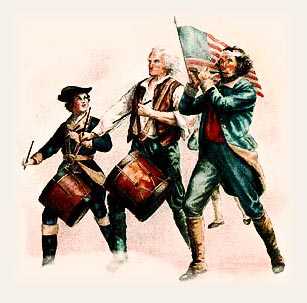 Asking the cause of the American Revolutionary War may be a little simplistic; civil wars pop up, all over the place, all the time. The more important question to ask, is why did this American Revolution have such a dramatic effect on the whole world?
Asking the cause of the American Revolutionary War may be a little simplistic; civil wars pop up, all over the place, all the time. The more important question to ask, is why did this American Revolution have such a dramatic effect on the whole world?
Lumpers In Constant Combat With Splitters
 The home dinner table is no longer the place most families teach the rules of conduct to each other, probably because of the invasion of homes by television. But there are places where friendly debate is still conducted and social issues are settled. In Philadelphia, newcomers are still taught what's what, in this manner.
The home dinner table is no longer the place most families teach the rules of conduct to each other, probably because of the invasion of homes by television. But there are places where friendly debate is still conducted and social issues are settled. In Philadelphia, newcomers are still taught what's what, in this manner.
Franklin's Codicil to His Will: Strange Afterthoughts
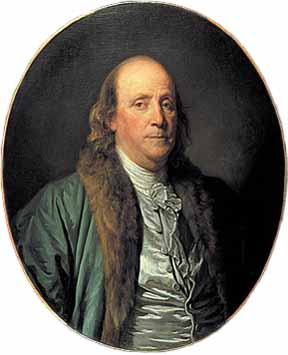 Ben Franklin died a very rich man, because he was a frugal one.
Ben Franklin died a very rich man, because he was a frugal one.
Religion at Girard College:Spiritual But Irreligious
 In his will, Stephen Girard famously banished all clergymen from the grounds of his school for orphans, even as visitors. Nevertheless, the school's atmosphere is a highly ethical, even religious, one. Many graduates have become ministers.
In his will, Stephen Girard famously banished all clergymen from the grounds of his school for orphans, even as visitors. Nevertheless, the school's atmosphere is a highly ethical, even religious, one. Many graduates have become ministers.
Fort Wilson: Philadelphia 1779
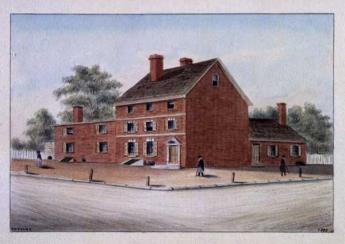 History was made at 3rd and Walnut, but so far, is unmarked.
History was made at 3rd and Walnut, but so far, is unmarked.
Quakers and Indians
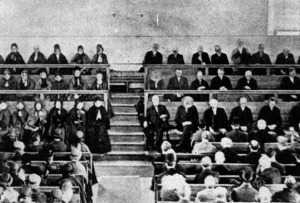 The Philadelphia Yearly Meeting of Friends has voted to endorse the U.N. Declaration on the Rights of Indigenous Peoples. The United States delegation to the U. N. has declined to endorse it. Each side has a point worth considering.
The Philadelphia Yearly Meeting of Friends has voted to endorse the U.N. Declaration on the Rights of Indigenous Peoples. The United States delegation to the U. N. has declined to endorse it. Each side has a point worth considering.
Too Much Money
 From the vantage point of 2012, the main cause of the 2007 financial crash was globalization's creation of immense wealth, which lifted 500 million desperately poor people out of poverty. The gold rush corrupted many minds, assisted by the computer and banking revolutions which hurried many smart honest people into fixing the engine while the motor was running.
From the vantage point of 2012, the main cause of the 2007 financial crash was globalization's creation of immense wealth, which lifted 500 million desperately poor people out of poverty. The gold rush corrupted many minds, assisted by the computer and banking revolutions which hurried many smart honest people into fixing the engine while the motor was running.
Keats, Symmetry, and Quakers
 Professor Ian Stewart says symmetry is beauty. Keats said Truth is beauty. Quakers say utilitarianism is the truth.
Professor Ian Stewart says symmetry is beauty. Keats said Truth is beauty. Quakers say utilitarianism is the truth.
International Law
 International Law is only for foreigners
International Law is only for foreigners
Honoring the Fallen
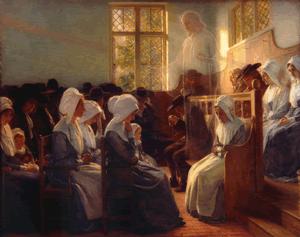 Two of Philadelphia's most honored institutions, Quakerism and the First City Troop, are in conflict.
Two of Philadelphia's most honored institutions, Quakerism and the First City Troop, are in conflict.